About this page
This page is a digital version of the book Kolomyya Forever, by Ariah Suchman (author) and Michael Toben (English language editor). Suchman copyrighted the book, but as he has since passed away, and it seems to be impossible to obtain a physical copy of it, I feel sure that he would rather it be available than not. (The book makes clear in several places, e.g. page 7, that it is intended as a memorial.)
I have tried to faithfully reproduce the text of the physical book, even including page numbers, typos, and so on (though I'm sure that I introduced some typos of my own). Anything you see in green boxes (like this one) is not part of the physical book, but everything else is.
I apologize for my low-quality reproductions of the photographs, maps, and drawings in the book. (They're from pictures I took with a camera, so are a bit distorted, and some are a bit brownish depending on lighting.)
As you'll quickly see, this page is still a work in progress. Last update: 2023-01-18.
About Kolomyya Forever
Kolomyya Forever is the English title of קולומיה לנצח by Ariah Suchman (אריה סוכמן). Some links about the book:
front
cover

p. 1
Kolomyya Forever
Arie Suchman
English Language Editor
This book includes new documentation, gathered over 8 years, during the making of a film on the destruction of Kolomyya and its environs.
p. 2
5764 / 2004
All rights reserved by the author.
p. 3
Table of Contents
- 9 In Memoriam
- 10 Preface
- 11 TODO Acknowledgments
- 16 Introduction
- 17 Forward from the production assistant
- 18 A film commemorating the Jews of Kolomyya
- 22 TODO Letters from distinguished personalities and institutions
- 27 ‘Prager Center’ Museum
- 29 Maps of Poland 1939-1945
- 32 Kolomyya
- 33 The author’s mother and Emperor Franz Josef in Kolomyya
- 34 Map of the Austro-Hungarian Empire
- 36 Pictures from Kolomyya
- 38 Yitzhak Teitlebaum
- 40 Edward Firestone
- 43 Yaakov Kube Menashes
- 44 TODO Rabbi David from Kilomyya reveals the greatness of the Baal Shem Tov
- 54 Beautiful pastoral scene of the Carpathian mountains
- 55 Rabbi Lau uprooted the tombstones
- 61 Photographs of Kolomyya
- 70 Documenting the Holocaust
- 73 The film: The Jews of Kolomyya
- 75 A brief history of Poland and Galicia
- 79 Outbreak of the war between Germany and the Soviet Union
- 83 The Nazi German and Soviet Union pact
- 85 Order of the Day of the Nazi Army on the eve of its invasion of Poland
- 86 General Governor Hans Frank
- p. 4
- 87 War breaks out between Communist Russia and Nazi Germany
- 90 In Recognition by Bhira Zakai
- 91 A visit to my city Kolomyya
- 93 Testimony of the holocaust survivor from Kolomyya, Edit (Icia) Glasberg
- 98 To Professor Maria Rosenbloom
- 99 An interview with Professor Maria Rosenbloom
- 107 Professor Blanca Rosenberg z’l
- 110 To Tell at Last
- 113 An interview with Professor Blanca Rosenberg
- 121 Chedva Kaufman
- 126 The testimony of a holocaust survivor, Mr Yaakov Zinger
- 130 The establishment of the Ghetto
- 139 Mordecahi Horwitz, Chairman of the Judenrat in Kolomyya
- 140 The railroad station in Kolomyya
- 141 Avraham Taub - hero of the Death Train
- 143 The testimony of Moshe Bretter
- 144 Kolomyya under the Nazis
- 146 An aktion in the ghetto
- 148 TODO Jews of the Ghettos
- 152 Professor Menek Goldstein z’l
- 153 The last day in the ghetto of Kolomyya
- 156 TODO Memorial Service Tribute to Menek Goldstein
- 163 The testimony of Salomon and Miriam Gutman
- 170 The testimony of Yeshayahu Likvornik
- 174 Righteous Gentiles - Vasilian and his sister Anya Petrovski
- 178 Dates of the aktions that took place in Kolomyya
- 179 TODO General Botschkivki, National hero of the Red Army
- 180 TODO Photos of the cemetery of the fallen of the Red Army in Kolomyya and the Monument to the Jewish soldiers from Kolomyya
- p. 5
- 181 TODO Order of the Supreme Command
- 182 TODO The liberation of Kolomyya from the Fascists
- 183 TODO May 9 is Victory Day over the German Nazis and a day of heroism
- 184 TODO Photographs taken during the bloody battles
- 186 TODO The capture of the Austrian war criminals
- 187 TODO Nazi Criminals slaughtered 80 thousand Jews from Kolomyya, Murders of Kolomyya Jews return to Vienna
- 188 TODO Chronicles of Nazi war criminals after the Second World War
- 190 TODO The dark secret of a noble-spirited journalist
- 193 TODO What was your business in Kolomyya?
- 196 TODO Deliverance
- 201 TODO Belzec Death Camp
- 204 TODO A translation of the inscription on the commemorative plaque in the Belzec camp
- 205 TODO The commemorative plaque at the Belzec extermination camp
- 207 TODO Kaddish in Belzec
- 208 TODO Phorographs of the Belzec camp - signs, monuments, etc.
- 210 TODO The remains of the Belzec camp
- 211 TODO A memorial ceremony held in the Shoporovtze forest
- 213 TODO Speeches made at the ceremny held at the Shoporovtze (Shoporvtza) Forest Memorial
- 216 TODO The burial of the ashes of the martyrs of Kolomyya
- 219 TODO Hanan Weisman
- 222 TODO Jacob Kuba Muntskik, z’l
- 223 TODO In the spirit of the 9th of Av
- 224 TODO I the name of the victims
- 225 TODO In memory of the martyrs
- 226 Yizkor
p. 6
This book has been published
with the assistance of:
Yad Veshem,
The Authority
for Memorializing the Holocaust and Martyrdom.
The
Foundation for Supporting Memorial Books of Holocaust Survivors,
The Azrieli Mall Chain, Azrieli Center, and IC of the Azrieli Group,
Thanks are also due to the Amos Foundation of the
President's Office for their generous contribution.
p. 7
Praise the Lord of the Universe who installed in the hearts of man the spirit of generosity and helped me to complete this memorial to the Jews of Kolomyya and its environs.
p. 8
This book is a companion work to two films, Kolomyya during the Holocaust and Vasilian and his sister, Righteous Gentiles which deal with the destruction of Jewish Kolomyya and its environs during the Holocaust.
For the future generations, the book and the films will be a permanent memorial to the memory of the Jews of Kolomyya and its environs who perished in the Holocaust.
p. 9
IN MEMORIAM
To the memory of the Jews of Kolomyya and its environs,
Eighty thousand martyrs, men, women, children,
Murdered in the Holocaust by the Nazis, may their name be blotted out.
May the souls of the martyrs be counted among the living.
May God revenge their murder.
Let us remember the young people of Kolomyya and its environs
who fought heroically against the Nazis
in the ranks of the Soviet Army and the Polish Army
and who fell in battle and whose burial place is unknown.
May the Lord avenge their blood.
To the memory of the souls of the members of my family
Who were murdered in Kolomyya
And in the death camp of Bergen Belsen,
My maternal grandfather, Yaakov Wasserman
And my maternal uncles, Kassiel Yager, his wife and children,
Itzik Yager, his wife and children
Benjamin Yager, his wife and children, from the town of Tchernovitz.
My mother's sister, Ester-Rachel bat Yaakov,
Her husband and their two sons from Tchernovitz,
My mother's two brothers from Kolomyya,
Yehuda Meshel, his wife and their daughter, Elka,
And Yoseph Leib, his wife and their children,
And all the rest of the members of my family whose names I no longer recall.
May their memories be blessed.
May God revenge their deaths.
p. 10
Preface

Ariah Suchman,
author of Kolomyya Forever
Many memorial books have been written to commemorate Jewish communities which were destroyed in the Holocaust, and among them the books on Kolomyya Jewry: Pinkas Kolomyya, (Kolomyya Notebook) in Yiddish and Yizkor K'hilat Kolomyya (Remember the Kolomyya Community) in Hebrew. No doubt all that has been written is a mere drop in the ocean compared to all that could have been written about each and every Jew who survived the Holocaust, and about those who were tragically murdered in the Holocaust.
Many of the horrors of those days have not yet been described or memorialized in a book. Now, fifty-five years after the war's end, there are fewer and fewer people left who remember the horrifying events of those days.
Eight years ago, I felt the need to perform a more concrete act of memorializing. I felt the need to make a documentary film which would be a living testimony, bringing alive the horrors of the Holocaust for the viewer.
In our generation, when television and the visual media have captured the masses, and people want to view historical events with their own eyes — more than to read about them in a book - a documentary film is actually the testimony which most effectively brings the horrors of the Holocaust alive for the viewer.
I approached the production of this documentary film from the depths of my memory, and with a sense of heavy responsibility and solidarity with the martyrs. For more than seven years, I faced many challenges including the need to collect documentary materials, especially from Kolomyya and its environs, to film documentary footage at the sites of the destruction and the old Ghetto, to write the script, to edit and proofread the narration, to film and record interviews with survivors, and to work on continuity in the film studio The result is an hour-long film. The viewer may not understand what is involved in the details of the production of a documentary film, but it is a difficult and arduous task.
Such a production is also quite costly — tens of thousands of dollars - which I did not have. I trusted that God would move the hearts of the people from Kolomyya to contribute towards its production. The help I received from my assistant, Ephraim Arbel, was nothing short of a miracle. We spent many days and nights working on the film. In both our names, I would like to thank the survivors of the Kolomyya Ghetto, now living in Israel and abroad, who graciously agreed to be interviewed for the film.
Finally, after the film was completed, I decided that it would need a book to accompany it. After much effort and a number of years, this is the product. My thanks go out to the innumerable people who contributed in so many ways to make this book possible.
p. 11
p. 12
p. 13
p. 14
p. 15
Acknowledgements
TODO: type up the acknowledgements (pages 11 through 15)
The goal of this book is to perpetuate the memory of the Jews of Kolomyya and the environs, and is not for any financial profit.
p. 16
Introduction
The book Kolomyya Forever is a memorial to those who were killed and butchered in the Kolomyya Ghetto. The book describes the terrible and horrifying experiences of the ghetto residents from september 1941, until their final liquidation in March 1943.
The book presents ten complete testimonies of those who survived the inferno. Three of the survivors emigrated to the United States after the war, and subsequently gained a reputation in the academic world. Their live testimony can be seen in the film "The Jews of Kolomyya during the Holocaust".
In those years of darkness and shadow there were also those, however few, who did not lose their humanity and who, at great risk to themselves, seved Jews from their killers. Vasilian Petrovski and his sister Anya are examples of such people. They endangered their lives by hiding sixteen Jews in their house, which was one hundred meters away from the Gestapo headquarters. On 12.11.97, Yad Vashem awarded them the title of 'Righteous gentiles'. The heroism and courage of these two people are described at length in the book by the survivors. The book preserves the memory of these events in documents and testimonies of the survivors. The book records the award ceremony that was held in the Garden of the Righteous Gentiles in Yad Vashem, Jerusalem.
The book, Kolomyya Forever and the two accompanying films are the products of many years of work. This trilogy tries to five as accurate a picture as possible of what happened to the community of Kolomyya during the terrible years of the Holocaust in Europe. The fate of this community with its very personal stories is the same fate of the rest of the European Jewish communities in this period, except for some details.
The book is intended as a study source and reference for high school pupils and students, and for all who are interested in the history of the Jewish people. I pray that this contribution of mine will help to make the youth of our nation become more aware of the importance of the study of the Holocaust heritage. In addition, the films and book will also contribute in the struglle against those who deny the Holocaust.
Ariah Suchman
p. 17
Our thanks to Mr. Ephraim Arbel

Efraim Arbel
Our deep thanks to my friend Ephraim Arbel for his extended help in the production of the film on the Holocaust of the Jews of Kolomyya and its environs. Together we carried the burden and handled all the difficulties in applying to various institutes for aid in making the film. Unfortunately, we often suffered disappointments.
I thank you for your hard work and we are all greatly indebted to you for your contribution and I wish you every success and may God bless you.
Your friend,
Ariah Suchman
Producer
From the film production assistant
I first met Ariah Suchman in the framework of cultural and educational work in the Dovev-Oz community in Ramat Gan. He told me about the work of perpetuating the memory he had been engaged in already for several years, namely, the production of a documentary film to perpetuate the memory of the Jews of Kolomyya who were murdered in the Holocaust. I expressed interest in the subject and then Ariah contacted me and asked me to be his production assistant.
The work in the project was very complicated. It was very difficult to obtain photographic documentary material of Kolomyya and the environs. Ariah ran from place to place and made contact with survivors from the Kolomyya Ghetto in Israel and abroad in order to interview them for the film, as well as to find sponsors for the project. He also made contact with people in Kolomyya in order that they should send him photographic material from there.
For many years, night and day, we engaged in editing, working in the film studio. During all this time Ariah tried to obtain financial support from institutions in Israel and more than once was sent away empty-handed. It was painstaking work over the years.
Thanks to his great and untiring dedication, and above all by the grace of the Lord, we managed to complete the documentary film commemorating the memory of the Jews of Kolomyya and its environs.
Ephraim Arbel
Assistant to the producer of the film
p. 18
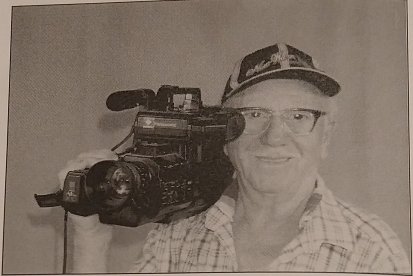
Ariah Suchman, Ariah Suchman, producer and director of the film The Jews
of Kolomyya.
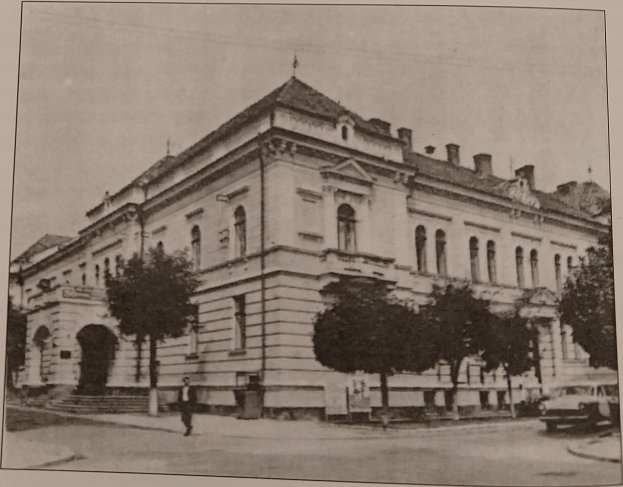
The Savings Bank and the National Theatre in Kolomyya
p. 19
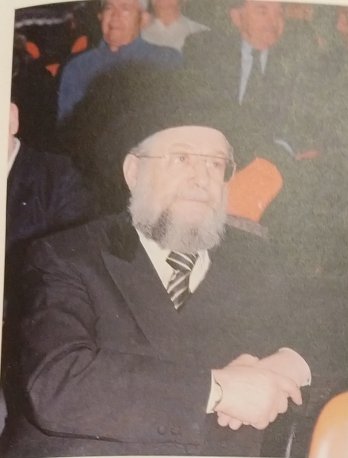


On the occasion of the first showing of the film The Jews of
Kolomyya
Above left: the Chief Rabbi of Israel, Rabbi Meir Lau who spoke at the
ceremony.
Above right: Rabbi Yechiel Wasserman, deputy mayor of Givatayim, opening the
event.
Bottom: Rabbi Skolsky, Director of the Kiddush Hashem Archive and his team of
assistants
p. 20
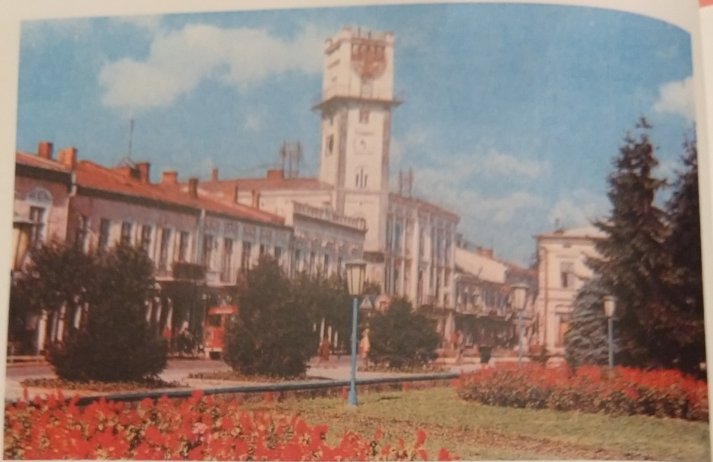
The city of Kolomea after its liberation
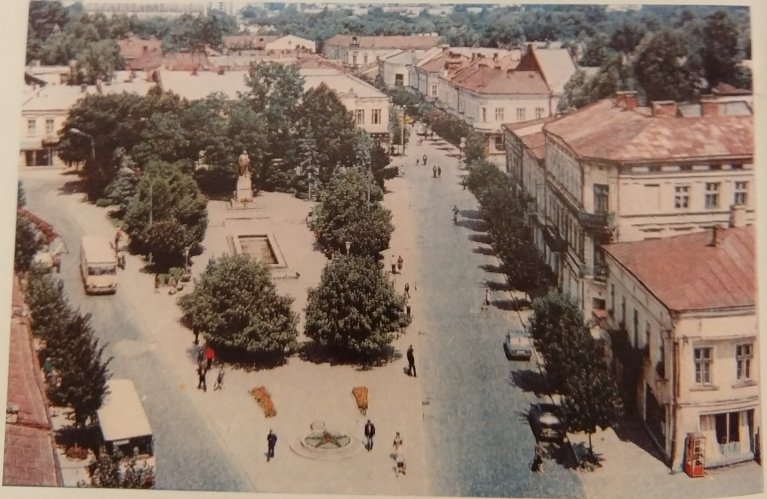
The city square at the center of Kolomyya
p. 21

The film The Jews of Kolomyya was screened at Bet Wohlin on
3.2.1999 on the 55th anniversary of the cessation of the extermination of the
Jews of Kolomyya and its environs. The banner reads,
"City of Givatayim — A film in memory of Kolomyya Jewry during the
Holocaust will be shown under the auspices of the mayor, Efi Stenzler —
Beit Wohlin, Wednesday 02/03/1999 at 4:00 PM".

Members of the audience at the premiere screening of the documentary The
Jews of Kolomyya.
p. 22
בס״ד
Israel Meir Lau
Chief Rabbi
of Israel
President of The Great Rabbinical Court
25 Tammuz 5761
16 July, 2001
Mr. Ariah Suchman,
Ramat Gan
Dear Mr. Suchman,
I was pleased to hear that you have devoted great efforts to memorialize the community of Kolomyya both in a film and in a wide-ranging book.
TODO: type the rest of this letter
With sincere greetings,
Israel Meir Lau
Chief Rabbi of
Israel
p. 23
A Translation of a letter sent on 29.7.1997 by Yad Vashem, Tel-Aviv area.
Mr Ariah Suchman
Producer of The Jews of Kolomyya
Ramat Gam
Dear Sirs:
TODO: type the rest of this letter, and attach the photograph of Avigdor Efron
p. 24
My sincere blessings to you, Mr. Suchman. May there be many more like you.
Respectfully,
Avigdor Efron
Director of the Educational
Center for the Holocaust
Yad Vashem, Tel Aviv District
p. 25

אוניברסיטת תל-אביב
TEL AVIV UNIVERSITY
The Lester and Sally Entin Faculty of Humanities
The Stephen Roth Institute for the Study of Contemporary Anti-Semitism
and Racism
16.7.99
Dear Mr. Suchman,
TODO: type the rest of this letter
Sincerely,
Dr. Ronny Shtauber,
Coordinator of the
Foundation
for the Study of Anti-Semitism
p. 26
Letter from Rabbi David Skolski (Kidush Hashem Archives)
Re: The Hebrew book Kolomyya Forever
TODO: type the rest of this letter, and attach the photograph of Rabbi David Skosky
Very sincerely,
Rabbi David Skolski
Director
p. 27
"Prager Center" Museum - Ganzach Kiddush Hashem
The splendor of the Jewish Nation, the charm of its holidays, the multifaceted nature of its daily conduct, the myriad‘s of charitable and mutual-assistance with which it was blessed - were at all times the focus of attraction to those who benefited from this exemplary behavior, as well as a source of envy to the non-Jewish world.
The Jewish nation in all its dispersions has managed to maintain its uniqueness. The two thousand years of Diaspora during which it wandered all over the world, battered and weakened by crusades, persecuted and exiled by the Spanish Inquisition, harassed and decimated by all kinds of pogroms - did not succeed in demolishing its spirit and to shake its allegiance to its Jewish heritage.
Our generation, a generation of hardship and wonders, has felt on its body the collapse of the Jewish world when the horrible Holocaust was inflicted on it by Nazi beast, and had the merit to witness the revival of the Jewish nation and the reincarnation of the “eternal Jew“ that sinks his roots increasingly deeper into the soil.
The researcher and published author, Mr. Moshe Prager, O.B.M., the Founder of “Kidush Hashem Archives - Memorial Center for Research and Documentation“, has lived to see three worlds:
He saw European Jewry during its heyday, during the time when millions of its sons continued to flourish on a soil where they and their predecessors sunk roots during two millennia; he has lived through and seen the horror of the Holocaust when this Jewry has been robbed of its beauty and magnificence, and he lived to see, observe and contemplate the rise of a new mangificent generation from the ashes of the crematoria.
He has felt and obligation to serve as the "connecting link" that has remained alive in order to join and unite the pats with the present and future generations and to transmit to them their glorious heritage.
The Goals
- Our institution - "Kidush Hashem Archives - Memorial Center for Research and Documentation", was established by Mr. Prager in 1963 in order to preserve the wealth of testimony on the spiritual bravery of Jews during the Holocaust and on the miracle of the rising of the Jewish nation from the ashes of crematoria and to give access to them to the public. He did this in order to attain several clearly defined goals, the implementation of which took up all his time and energy:
- To investigate, collect and record for posterity all the manifestations of Jewish spiritual heroism in our generation, when the Nazi fiend contrived to annihilate the nation that proclaimed the belief in the Almighty in the world. The Jew, unshaken in his faith, defended it against all odds and refused to repudiate it under the most trying circumstances. The same Jew, who was persecuted by p. 28 bloodthirsty Arabs in the East and by Communists in the Soviet Union, has spiritually survived, and under these circumstances his survival serves as irrefutable and persuasive evidence that all the Jews of the world are one Nation, whose spiritual heritage is indestructible.
- To salvage all forms of recorded documentation that manifest the unique image of the Jew throughout history and the entire spectrum of life styles of the Jewish world that is no longer. This is a dual goal: it is intended both to commemorate the glory of the Jewish nation and to awaken and foster the effort to re-forge the chain of generations and to build the life of the Jewish Nation on the foundation of the Jewish heritage.
- This goal combines the two previous goals and consists in establishing a museum, the exhibits of which would illustrate to the new generation, new immigrants and tourists from the entire world the manifestations of Jewish spiritual heroism under the Nazi occupation, the mutual assistance extended under the most trying circumstances and the brave resistance to the suppression of the spirit under the most horrendous conditions in recorded history. All this would be done with the purpose of the museum serving as a means to educate the younger generation by bringing them closer to their glorious past and imbuing them with true Jewish pride.
To attain all these goals, Moshe Prager started collecting documents and photographs from many sources. He traveled extensively abroad and went through all the many private and public archives, an enterprise that required unlimited patience and effort.
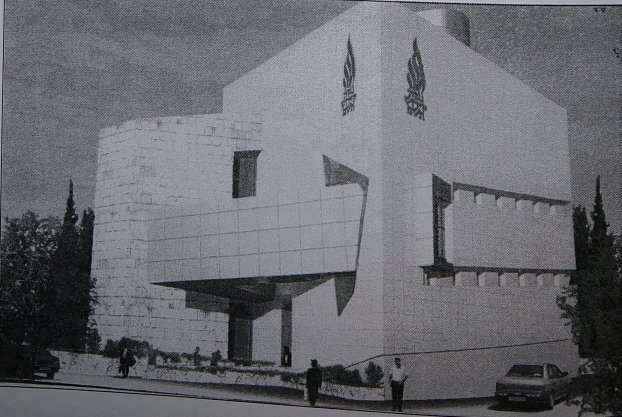
The Prager Center Museum - Kiddush Hashem Archives
p. 29
The partition of Poland between Germany and the Soviet Union,
28
September 1939

p. 30
Map of east Galicia during the Nazi occupation — 1941
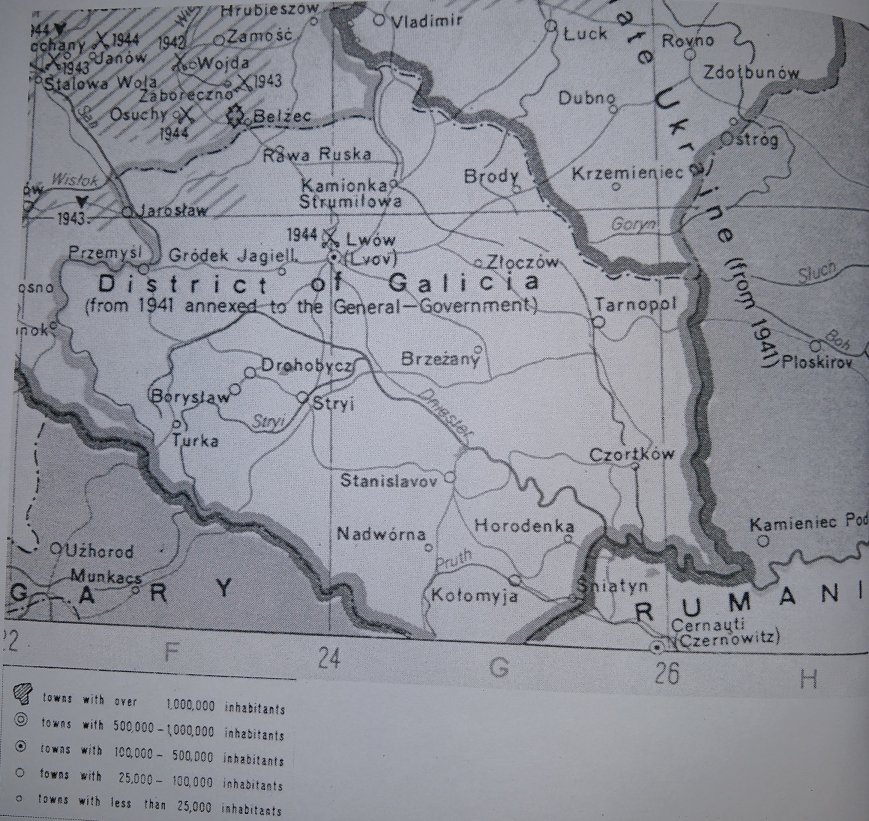
p. 31
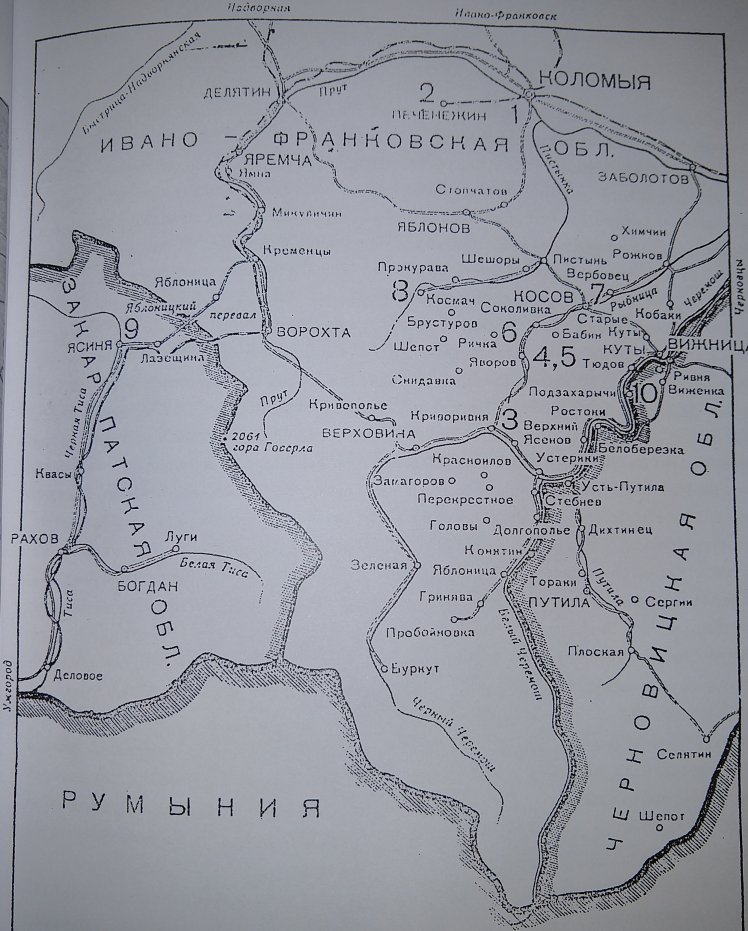
The regional map of Kolomyya and its environs including its southern and
eastern borders. Following the collapse of the Soviet Union, the area came
under the jurisdiction of the Ukraine. Kolomyya is in
the upper-right-hand (northeast) corner of the map, labeled in Russian as
"КОЛОМЫЯ".
p. 32
Kolomyya
The city of Kolomyya today is part of the Ukraine, standing on the banks of the River Prot. Before the Second World War it was in the southeast area of Poland, that is eastern Galicia. Not too far south is Romania , in the northwest is Poland, to the southwest stand the Carpathian Mountains.
According to archaeological findings and official accounts, the city of Kolomyya is one of the earliest settlements in Galicia. The first official date is 1241, though archaeologists claim that it dates much further back. In its beginnings, Kolomyya was a military fort that protected the southwest border of ancient Russia. The city underwent several changes. In 1259, the fortresses were destroyed, evidently by Prince Daniel of Galicia under the command of the Mongol-Tets. In the middle of the 14th century, Galicia was conquered by the Poles and was constantly under threat of foreign invasion. According to Polish accounts the city was burned by the Tets in 1621 and its inhabitants annihilated. In time, the city was rebuilt and it was situated on the commercial route from Poland and Germany through Galicia to Volga and the Danube: to Kiev and to Hungary and Czechoslovakia. After the first division of Poland in 1772, Kolomyya was annexed to Austria. The Levov-Chernovitz railroad was built in 1866, and the line between Levov and Bucharest was built in 1876, and contributed to the fast development of the city. After the First World War it was under Nazi rule for about three years. In 1944 it was liberated and annexed by the Soviet Union. With the fall of the Soviet Union it has become part of the Ukraine.
A number of Jews settled in Kolomyya and its surroundings at the beginning of the 16th century. There is evidence that Jews lived there even earlier. In time, the Jewish population grew. Before 1914, Kolomyya had 41,000 inhabitants with more than half of them Jews. In the First World War many Jews left and not all of them returned. The Jews in Kolomyya were active in commerce, industry and craftsmanship. The industry of building materials, such as bricks, was also in the hands of the Jews. Before World War One Kolomyya was an important military center of the Austrian empire and the Jews made their living from work for the military.
Kolomyya is known as a Chassidic city. The Baal Shem Tov also worked in Kolomyya and legend has it that he was born in a suburb of Kolomyya, Okop. The Chassidic movement spread to many areas and many rabbis came to Kolomyya. Even with the spread of higher education and secularism, Kolomyya did not lose its Chassidic character. It should be noted that in Kolomyya there was no widening of the gaps between the Chassidic movements and the other Jewish movements.
Emperor Franz Joseph enjoyed a long reign of fifty-eight years over the Austrian empire. From 1848 until 1916 he was engaged in various wars with national minorities who wished to establish independent states. In the latter part of his reign, the First World War took place, and in 1916 he died in the middle of the war, deeply depressed.
Franz Joseph was much admired by the Jews since he acted tolerantly towards them and extended his protection to them; as a result he was highly regarded as a ruler who protected the Jews. There were two p. 33 million Jews in his kingdom who were loyal to their benefactor. During the First World War thousands of them served in the army and many fell in the battles. Among those taken prisoner by the Russians was my father, Tzvi Suchman z’l, and my uncle Josef Leib z’l.
It should be noted that in all the synagogues throughout Eastern Galicia prayers were recited in Hebrew, Yiddish or German for the well being of the Emperor, which blessed the Emperor with the words: “To the Emperor Ephraim Joseph, May you be blessed and successful for one hundred and twenty years.”
The author’s mother and Emperor Franz Joseph
My mother, Tehila z’l, told me of an interesting event. When she was about 12, she was in a group of some ten girls chosen to welcome the Emperor Franz Joseph when he came to visit Kolomyya.
When the Emperor arrived in the center of the town towards noon, big crowds were waiting to see him. The town rabbis came out to meet him carrying Torah scrolls. They stationed themselves on the left and the church clergy stood on the right carrying crosses. When the Emperor descended from his carriage he approached the group of girls to taste the bread that the town’s girls offered him. Then he went and kissed the Torah scrolls, and only after that did he turn to the priests and kissed the crosses. Such was the esteem in which the Emperor held the Jews.
Ariah Suchman
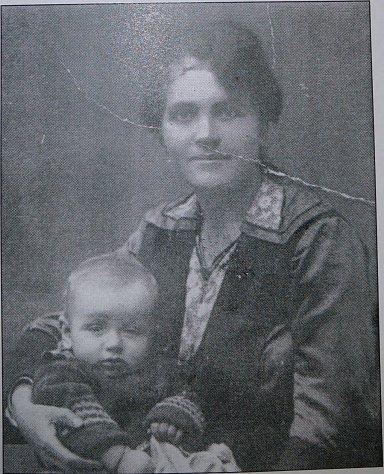
Photograph of the author’s mother Tehila Suchman z’l, neé Yaakov
Wasserman, with her eldest son, Moshe. The photograph was taken during the First
World War in Vienna.
p. 34
Map of the Austro-Hungarian Empire, eastern Galicia and Bukovina until the outbreak of the First World War
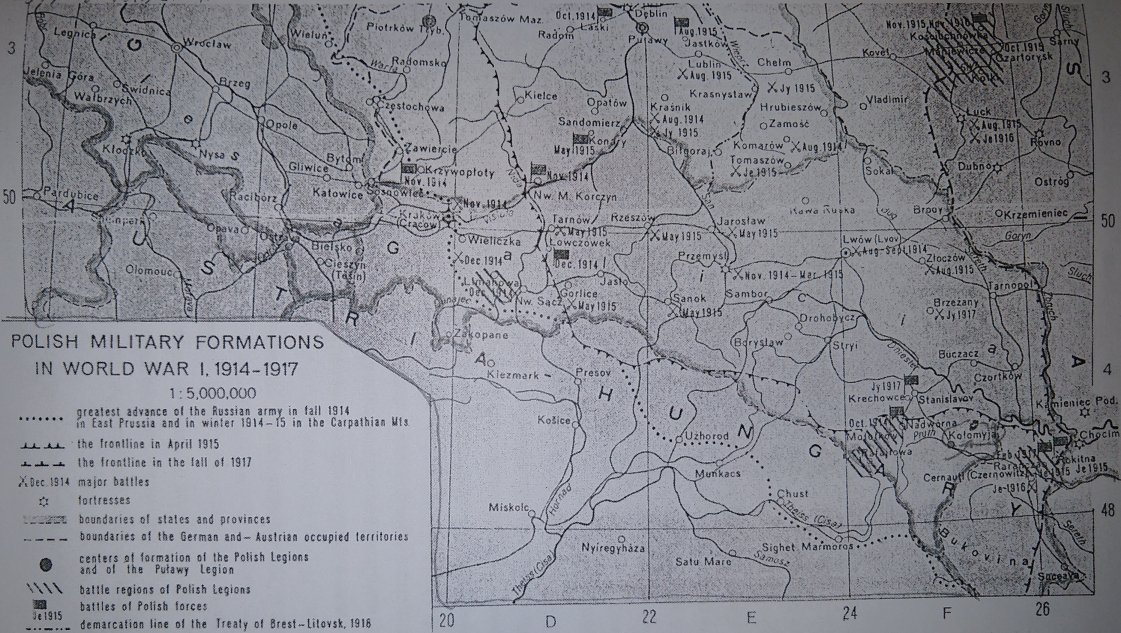
p. 35
Kolomyya in the Modern Period
Kolomyya excelled in Zionist pioneer activities. The first Zionists that were active there at the end of the 19th century were Dr Natan Birnbaum and Rabbi Ariah Laibel Toibash. Many pioneers who settled in Eretz Israel came from these pioneer movements that were operating before the Holocaust.
Among the many Jews who became famous for their economic activities in Kolomyya were two families in particular, the Brettler family and the Horowitz family.
Between the two world wars there were 35 Jewish doctors in Kolomyya (as opposed to 11 Christian doctors) and 45 lawyers, many of them highly regarded. There were also professors who taught at the Jewish Gymnasia and in other schools. It should be mentioned that a number of the doctors and academics were women.
The last chief rabbi of Kolomyya was the Rabbi Yosef Lau, a rabbi beloved by both the Jewish and non-Jewish community alike, a man who gave his soul for the Jews of Kolomyya and was murdered by the Nazis along with many other Jews from the city.
The city of Kolomyya, which was renowned for its Jewish character, was destroyed in the heinous Holocaust, but the memory of the Jews that died with the Name of the Lord on their lips will never be forgotten.
p. 36

Emperor Franz Joseph

'HaLokleka', the first train to arrive at the center of the city during
the time of the Austrians

The center of Kolomyya during the Austrian rule, 1917-18

Ariah Suchman's father Zvi Yager-Suchman, z'l, in his youth in
Austrian Army uniform
Ariah Suchman's uncle, Yosef Leib Wasserman, z'l, in Austrian Army
uniform, later murdered by the Nazis.
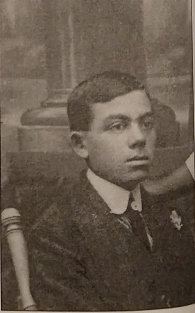
Ariah Suchman's uncle, Yehuda Meshel-Wasserman, z'l
p. 37
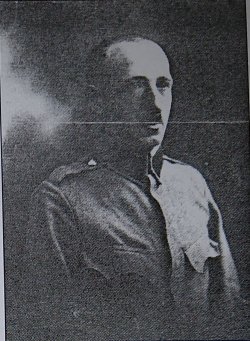 Julius (Yehuda) Bretler in the Austrian Army during the First World War. He was
an accountant, merchant, storekeeper in Kolomyya, and cigarette manufacturer in
Berlin, Germany. Sons: Mos (Dr. Maksim) Bretler, born in Kolomyya in 1909,
Emanuel Yeshayahu Bretler born in Kolomyya, 4 December 1921, married Franya Esta
Blatt, Kolomyya, August 28, 1907.
Julius (Yehuda) Bretler in the Austrian Army during the First World War. He was
an accountant, merchant, storekeeper in Kolomyya, and cigarette manufacturer in
Berlin, Germany. Sons: Mos (Dr. Maksim) Bretler, born in Kolomyya in 1909,
Emanuel Yeshayahu Bretler born in Kolomyya, 4 December 1921, married Franya Esta
Blatt, Kolomyya, August 28, 1907.
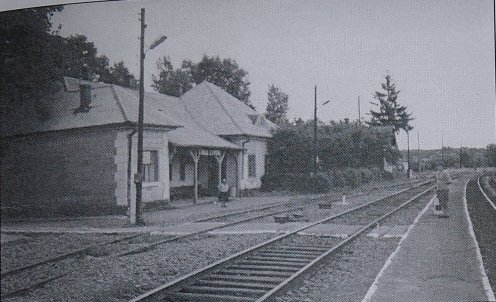 The railway station in the village of Gody-Turka, near Kolomyya. The station was
built by the Kolomyya property owner, Yaakov Bretler, before the First World
War
The railway station in the village of Gody-Turka, near Kolomyya. The station was
built by the Kolomyya property owner, Yaakov Bretler, before the First World
War

Yaakov Bretler's brewery in a suburb of Kolomyya - Getkowitza
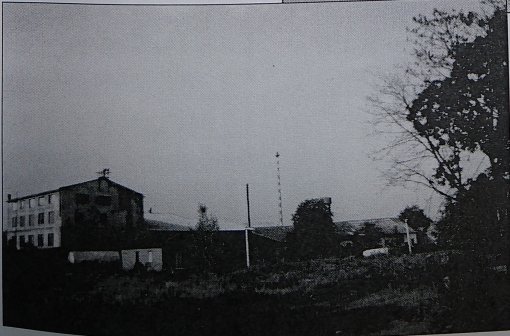
Yaakov Bretter's flour mill
p. 38
Mr. Yitzhak Teitlebaum

Yitzhak Teitelbaum, z'l, photographed at home in Haifa, March,
1992
In memory of Mr. Yitzhak Teitlebaum, our devoted friend, who gathered material for the memorial book of Kolomyya during the Holocaust. Yitzhak Teitlebaum made a wonderful contribution through his decades of active participation in the organization of The People of Kolomyya in Haifa. He was the first of the organization who started gathering documentary material in Israel and abroad, in order to bring this important and authentic material to publication in Hebrew and in Yiddish by the organization in a book memorializing the Jews of Kolomyya. The book was published in Israel and in the US, edited by Dr. Shlomo Bickell. Earlier Dr. Bickell had published a book, A Town and Its Jews in Yiddish in New York in 1942. The book was translated into Hebrew by Shimshon Meltzer. I hope that these books will remain as a memorial for this generation and generations to come, to read and to learn about the town of Kolomyya between the World Wars, until its complete destruction by the Nazis.
In September 1992, a memorial service was held in the Nahlat Yitzhak cemetery to mark 47 years since the destruction of the Jews of Kolomyya and its environs. That was the last year that Yitzhak Titlebaum participated in the ceremony. At the end of the service he asked for permission to speak. He addressed those present with his request to support the memorial project of filming a documentary about Kolomyya Jewry. Yitzhak Teitlebaum was a wonderful Jew, who worked intensively for the organization of Kolomyyans in Israel and abroad. For 20 years he labored at gathering the material for the Yizkor book of Kolomyya, which commemorated the destruction of the town of Kolomyya, which was and is no more.
At this ceremony, Rav Metzger spoke about the martyrs of Kolomyya who were murdered during the Holocaust. The film of the ceremony was a cornerstone for the historical project, which will present to coming generations the dimensions of the tragedy of the Holocaust.
When Mr. Ya'akov Kinick, of blessed memory, participated for the last time in this ceremony, he gave his blessing and support to the making of the film, and his approval for constructing a wooden model of the Great Synagogue. Mr.Hanan Weissman, our friend and craftsman, constructed this model, which is now on display in the Museum of Witness at Nir Galim, where thousands of tourists and pupils visit every year.
p. 39
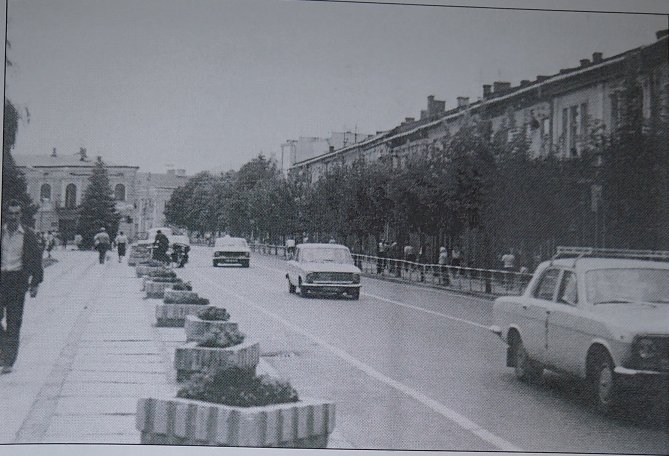
The town center in Kolomyya. Legionov Street, next to the Town Hall
building.
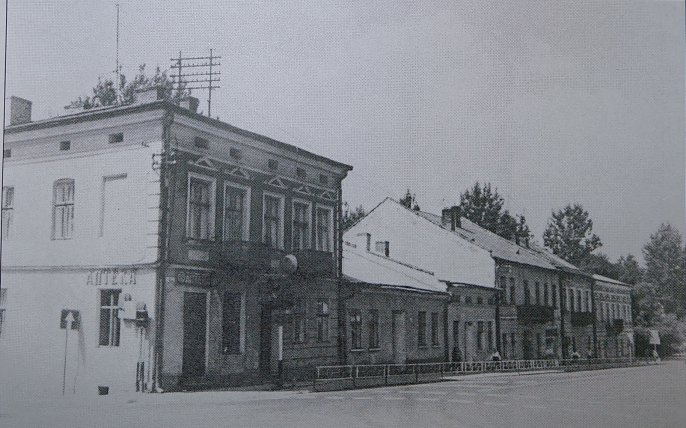
Sobieski Street, next to the Ukrainian Church. On the corner on the left, the
house of Yitzhak Teitlebaum z'l, who was for decades active in the
Organization of ex-Kolomyyans in Israel.
p. 40

Edward Firestone, z'l - Holocaust survivor.
He was one of the leading activists in the ex-Kolomyya community in the
United States until his death.
p. 41
On the work of Edward Firestone z'l, survivor of the Holocaust from Kolomyya and activist in the Kolomyya community in the US
Edward Firestone excelled in his public activities for the general welfare. While still a young man in Kolomyya, he was active in Zionist youth movements and in establishing a sports club. He was appointed Chairman of the Sports Federation of the best football club in the second league.
There were three Jewish sports clubs in Kolomyya, and he headed Z.T.G Dror. The second club was Asmonia, and the third, Hapoel. From the early 1930's and onwards these clubs competed with Polish clubs in Kolomyya, and the matches often ended in fistfights, in which the Poles lost. Edward Firestone always tried to make peace between the sides and prevent the violence.
He owned a materials shop together with his younger brother until the war broke out in 1939, when the Soviets entered Kolomyya. Later when the Nazis seized the area in 1941, the family suffered as other Jews of Kolomyya. However, by a miracle, he and his family survived after going through the hell of the Kolomyya Ghetto. After the war they went to Poland, and from there to Frankfurt in West Germany.
In Frankfurt, the unexpected happened. Edward and a friend, a survivor from Kolomyya named Krauthamer, were walking down a street when to their amazement they stood face to face with a familiar figure wearing civilian clothes. They froze on the spot for the man was the head of the Gestapo in Kolomyya, the former SS officer Peter Leidrich, who had conducted the cruel roundups in Kolomyya and sent Jews to their deaths. Edward and his friend began to shout, "Nazi! Nazi!" A crowd immediately formed, and the American military police soon arrived. The frightened murderer was arrested and jailed in Frankfurt. In the initial investigation, Edward Firestone and his friend Krauthamer testified.Additional witnesses were also called, who also testified to the murderou activities of the butcher of Kolomyya. During his trial, his captivity became known to the Polish government, which requested his extradition. In a court in Warsaw, Leidrich denied his guilt, maintaining that he had only dealt with issues regarding the Galician border. After a lengthy investigation, on the basis of firm testimony, he was sentenced to death and hanged in a Warsaw prison in 1947.
Edward Firestone will be remembered for laboring day and night in the US, as chairman of the organization of Kolomyya Jews, to memorialize the Jews of Kolomyya. He was blessed with many years, and passed away with a sterling reputation.
May his widow, Julia and her son also be blessed for their continued activity in memorializing the Jews of Kolomyya, especially for their generous contribution to the production of the book Kolomyya Forever. My thanks, and the thanks of all Kolomyya survivors in Israel and the Diaspora go to Edward Firestone.
p. 42

Edward Feuerstein z'l, at a communal function of former Kolomyyans in the
United States, delivering a speech at the evening commemorating the publication
of the Kolomyya Yiddish community record book in 1957 in the presence of a large
gathering and the remaining survivors.

The Dror Z.T.G football team in the 1930s. At the start of a match
against a rival team on the 49th Battallion’s sports
field n Kolomyya. Edward Feuerstein, the chairman, is standing on the right,
next to the player Bolek.
p. 43
Yaakov Kuba Menashes
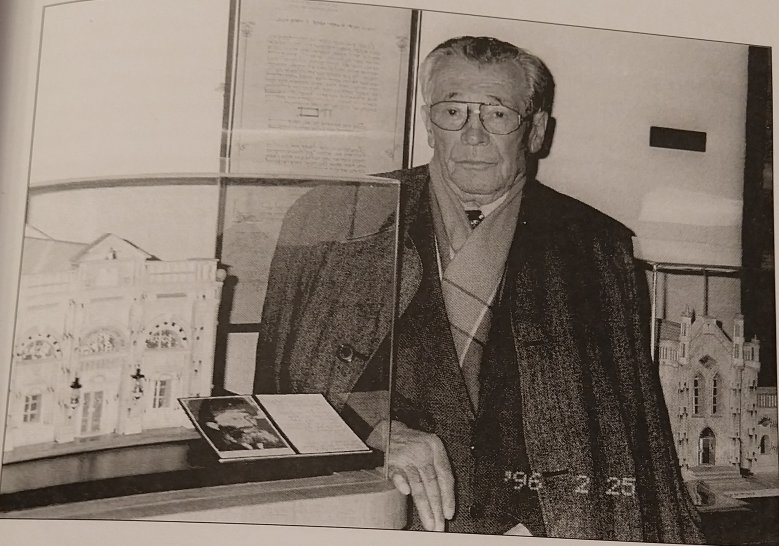
Attorney Yaakov Menashes visiting the exhibition of model synagogues in the House of Witness at Nir Galim. Yaakov Menashes was born in Kolomyya in 1906. He was one of the leaders of the Revisionist Movement in Poland and a well-known Zionist orator who was privileged to work closely with Zeev Jabotinsky. He held the post of secretary of the movement for eastern Galicia, whose towns and townships he frequently visited and attracted large crowds.
p. 44
p. 45
p. 46
p. 47
p. 48
p. 49
p. 50
p. 51
p. 52
p. 53
Rabbi David from Kolomyya reveals the greatness of the Baal Shem Tov
TODO: type up the text of this section (pages 44 through 47), and add the images and corresponding captions (pages 48 through 53)
p. 54
Beautiful pastoral scene of the Carpathian mountains in the area of eastern Galicia where the Baal Shem Tov, the founding father of Hassidism, would go into seclusion until experiencing a revelation.
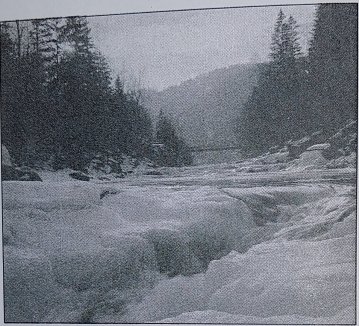
The River Prut frozen over in winter.

The River Prut in the summer.

The snowy Carpathian
Mountains in the winter near the Polish Hungarian border before the
outbreak of the Second World War. Smugglers crossing the Polish-Hungarian
border during the Holocaust used the mountain on the left.
p. 55
The last Rabbi of the Kolomyya community, the Great Rabbi Yisrael Yosef Lau, z'l, who died in the Holocaust
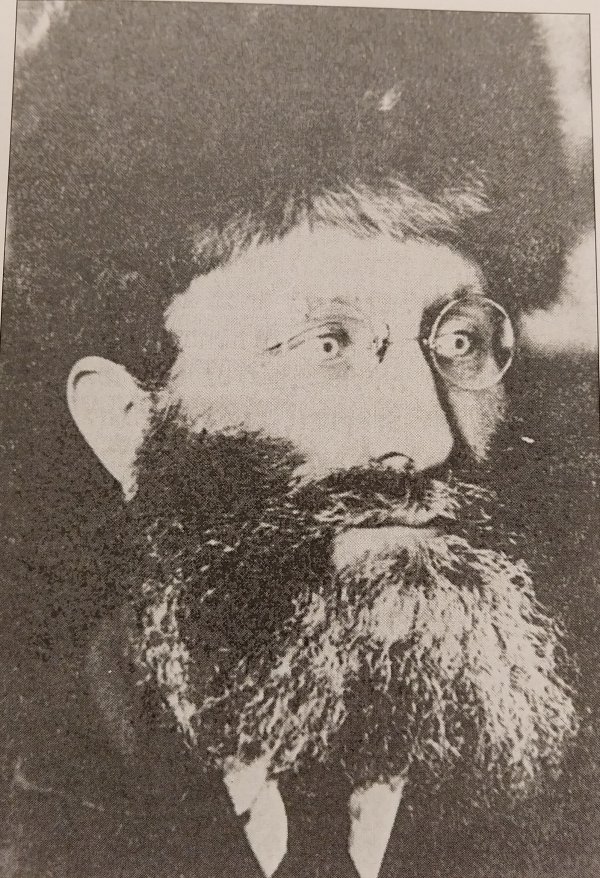
p. 56

The Great Central Synagogue of Kolomyya where the last rabbi of Kolomyya,
Rabbi Yisrael Yosef Lau, z'l, prayed. The synagogue was torched by the Nazis on
the night of Hashanah Rabah, 1942.
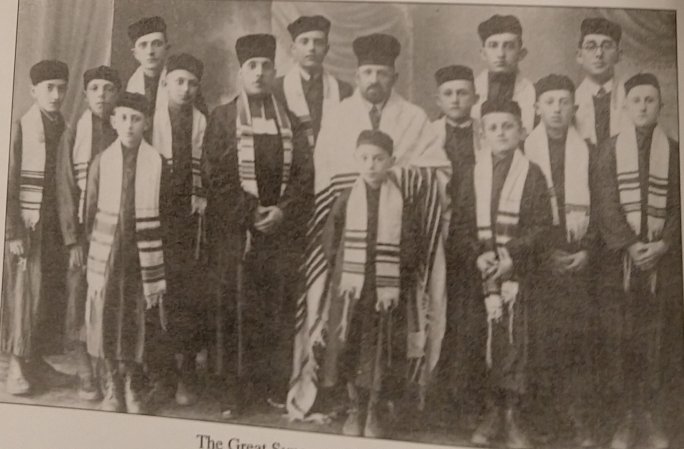
The Great Synagogue's choir, 1930s.
p. 57
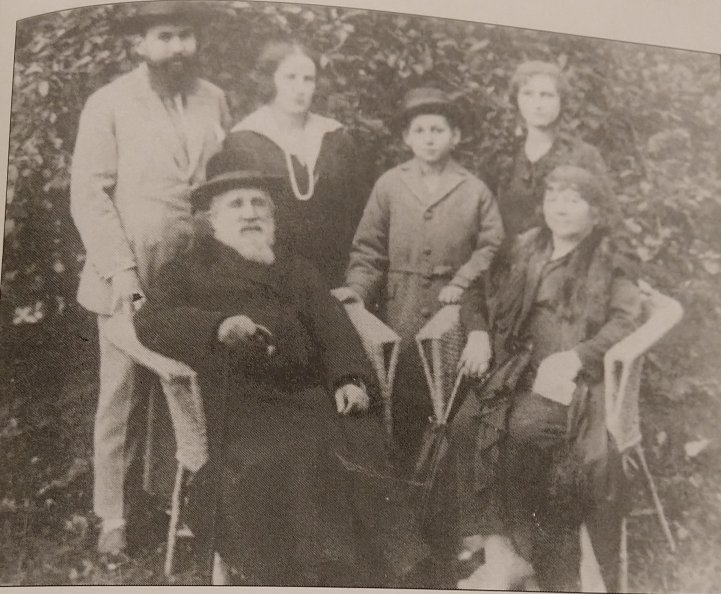
Rabbi Hirsch Leib Lau and his wife sitting in the garden of their house in
the city of Lvov. The parents of the two brothers, Rabbi Yisrael Yosef Lau,
z'l, the Rabbi of Kolomyya and Rabbi Moshe Lau, z'l, Rabbi of
Pyotrikow. The young boy in the center, Shmuel Itche, was the son of Rabbi
Yisrael Yosef Lau, z'l.
(The picture was reproduced
with the kind permission of the Chief Rabbi Yisrael Meir Lau, Shelita, son of
Rabbi Moshe Lau, z'l.)
p. 58
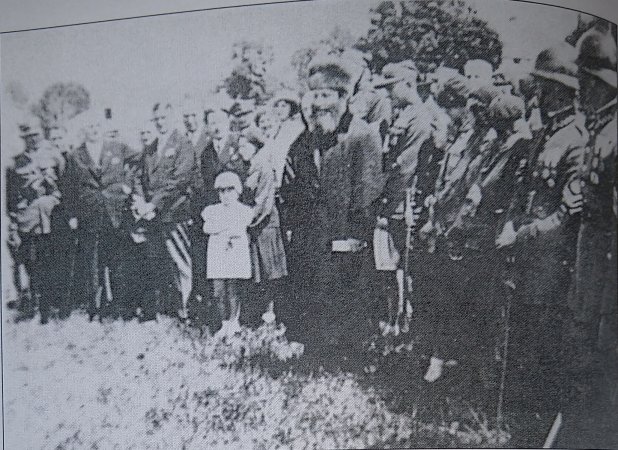
The Rabbi of Kolomyya, Rabbi Yisrael Yosef Lau, z'l, swearing in
Jewish soldiers into the Polish army. The ceremony took place in the 1930s in
Kolomyya on the sports field of Battalion 49 in the presence of town dignitaries
and Army officers.
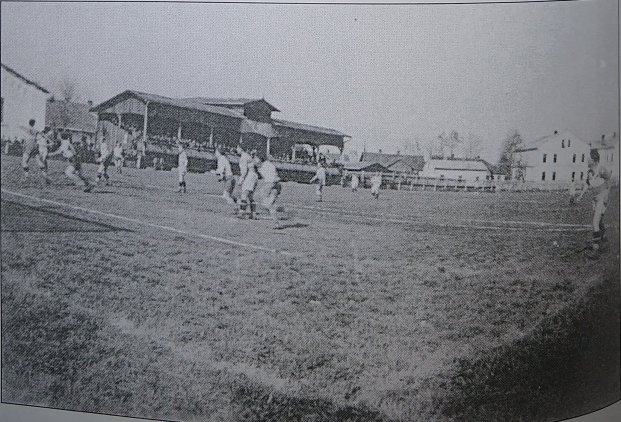
A game between two Jewish teams, Dror Z.T.G. and Simona on the sports
field of Battalion 49 in the 1930s.
p. 59
Rabbi Israel Yosef Lau uprooted the tombstone
From the book Remembering Kolomyya by A.S. Rina
The Rabbi's voice trembled. His face was ashen. Tears streamed from his eyes. He spoke haltingly: "Oh Holy Graves, Holy Dead, Holy Bones. Please forgive us for this wicket iniquity, for desecrating your honor. It has been decreed that we shall desecrate the holiness of your graves. We have to uphold this decree in order that your children and your children's children shall live. We beseech you, the Holy Dead, to forgive us. May our prayers and supplications multiply before the Almighty God. We pray mercy for Israel and the nation of Israel that has suffered so much affliction. Forgive us, Oh please. Forgive us"...
The thousands of Jews that stood with bowed heads and stooped backs among the many graves that covered the cemetery heard every word that was uttered by the Rabbi. They followed his words with sighs and silent lamentations. They watched the local Rabbi raise his pale white hands upwards, his voice choking: "Our Witness in Heaven, we are compelled" The Rabbi sobbed bitterly and with him the whole assembly began to wail.
With trembling hands the Rabbi touches the tombstone that is before him. He drenches the stone with his tears. He momentarily steps back and grabs his hands as though he had touched a burning rod. Once again he sends his quivering hands to the tombstone. The Rabbi's eyes are closed. His face contorted. He hugs the tombstone like a compassionate father would hug his only son. He breaks into a wail and begins to wrench the tombstone from its place ... The head of the community and its respected members soon join the Rabbi. They also begin tearing the tombstones from their places with piercing cries. The rest of the community that had come to the cemetery also began tearing the tombstones from their places.
That was between Rosh Hashana and Yom Kippur in 1942. The nazi commander of Kolomyya (in eastern Galicia) had plotted this heinous deed. The Jews of the city had been commanded to uproot the tombstones from the graves in the cemetery in order to pave roads for the German army's armaments to pass over. The day after Rosh Hashana in 1942, a Nazi captain came to the Gestapo that had the head of the Jewish affairs in Kolomyya under its jurisdiction. They demanded that the following morning several hundred Jews be sent to uproot the tombstones from the graves and transport them to the roads. An elderly Jew ran to inform the Rabbi of the city, Rabbi Israel Yosef Lau.
On the same day a meeting was called at the Rabbi's house with all the respected members of the congregation. Many said that they should not comply with the Gestapo demand and that they would prefer martyrdom sanctifying the name the Lord, rather than execute this terrible injunction of desecrating the honor of the dead of the city. The Rabbi was of a different opinion. In a broken voice he explained that it is not proper to desecrate the dead, but he conceded, that according to the Torah this would not be considered a capital offense. He stressed that "If this heinous deed is to be done at all, it will not be done p. 60 by 'simple Jews'. I will be at the head of this and together we shall go to the cemetery and take upon ourselves this sinful task. "The congregation accepted the Rabbi's decision and dispersed in silence. The following day the whole city was plunged into a public fast. The Rabbi was immersed in prayers and recited the Slihot and thereafter the respected Elders of the city went to the cemetery. When the word got out that the Rabbi had gone to the cemetery, there was a flood of Jews from every corner of the city. The Rabbi looked into the faces of his community that stood before him with bent heads and wrapped in silence. They stood for a few minutes in reverence. They watched the Rabbi, his lips moving in prayer. And then the mournful declarations burst forth from his mouth - to the Holy tombstones...
That deed saved the lives of many Jews in Kolomyya for another year. At the end of that year, the remaining Jews of Kolomyya with the Rabbi Israel Yosef Lau at their head, were sent to the concentration camp Belsac.
p. 61

Jewish gravestones
uprooted by order of the Nazis by Jewish slave-labor among whom was Rabbi Yosef
Israel Lau z'l. The Nazis used the stones to pave paths to the houses of
SS officers. After the liberation of Kolomyya and under Soviet rule, the
gravestones were collected and placed in the square where previously the statue
of Lenin had stood.
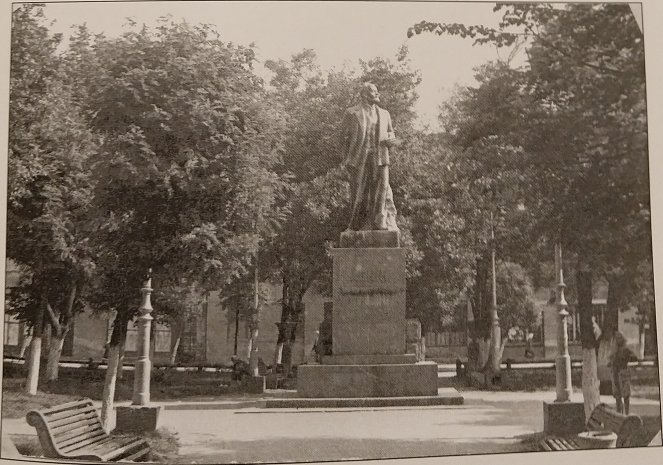
The statue of Lenin in the central square in Kolomyya placed there by the
Soviets in 1939-40.
p. 62
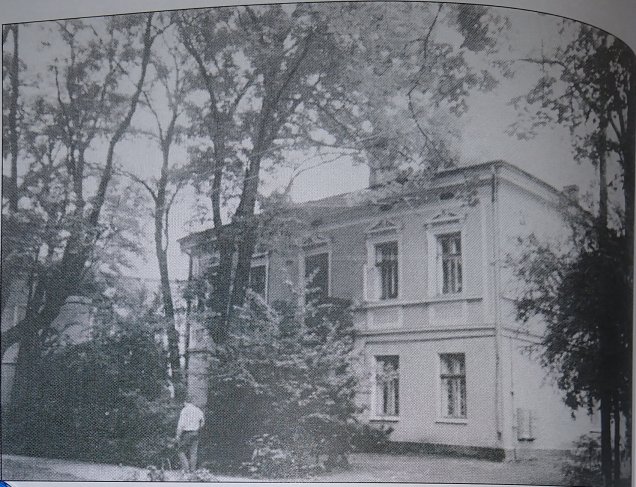
Rabbi Lau's house in Kolomyya. The house remained in tact during the Holocaust
and has remained unchanged until today.
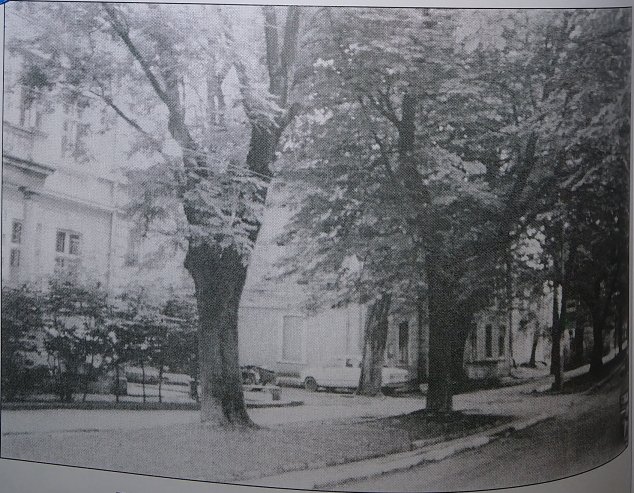
Welnoshtzi Street, near the house of Rabbi Israel Yosef Lau, z'l,
p. 63
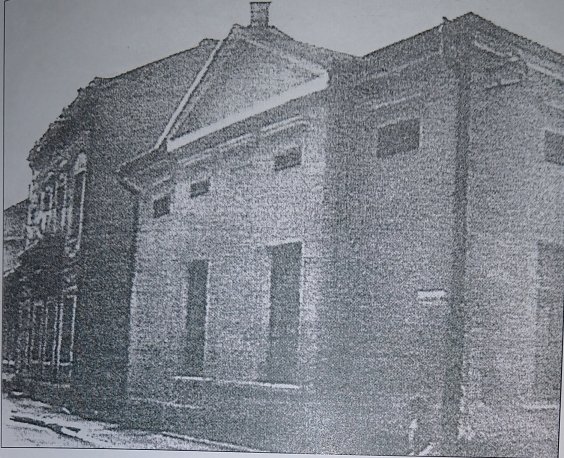
The DeYerushalayim Synagogue that survived the Holocaust is found near
the Central Square of Kolomyya. On Sabbaths and Festivals, services are held by
the few remaining Jews in the area.
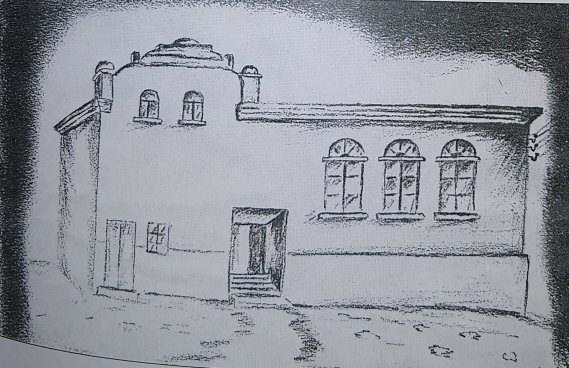
A drawing by Ariah Suchman.
The Synagogue Bojan Klaus Hassidim in
Kolomyya. Ariah Suchman's grandfather, Yaakov Suchman, z'l, was the last
sexton of the synagogue. On a Shabbat in 1942, the Nazis broke into the
synagogue during the service and started murdering the congregants. Tens of
congregants were murdered in the synagogue among them was Yaakov Suchman, z'l.
After the orgy of murder, the Nazis burned down the synagogue and nothing of
the building remains today.
p. 64
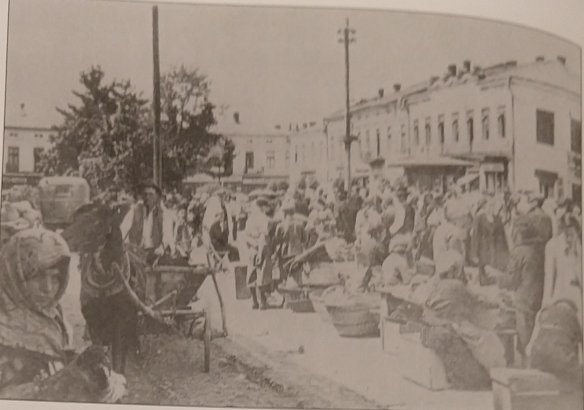
The famous marketplace (Der Markplatz) in Kolomyya. The photograph
was taken before the war.
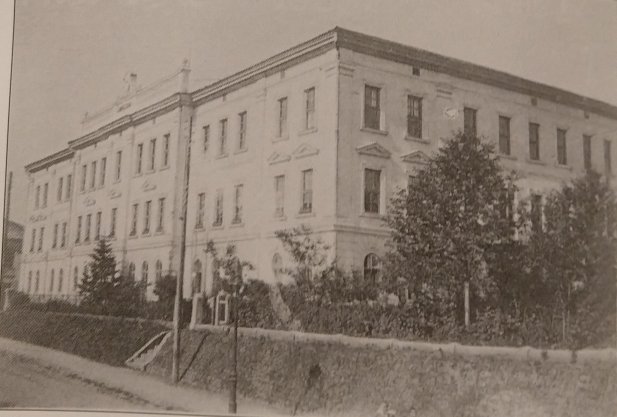
The Polish National Gymnasium in Kolomyya where both Jews and Poles
studied.
p. 65

The Rabbi with his pupils in the Talmud Torah

A sketch of the Talmud Torah as it appeared before the outbreak of the
Second World War by Ariah Suchman.
p. 66
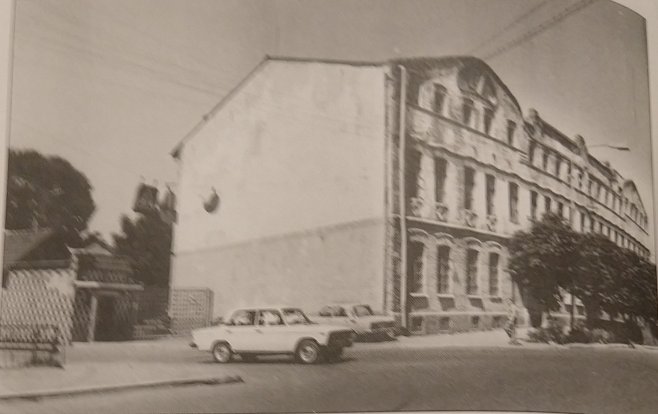
The Zaiger Prayer Shawl (Tallitot) Factory
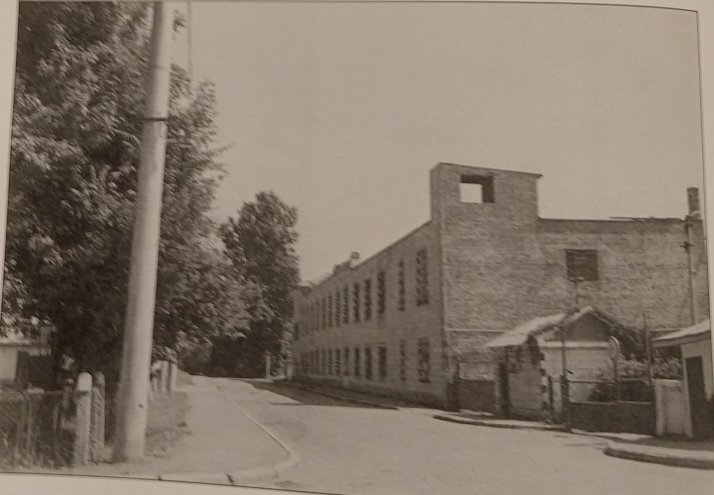
The Shimshon Heller's Prayer Shawl Factory. Today the two factories
produce fabrics.
p. 67

Jewish water-carrier.
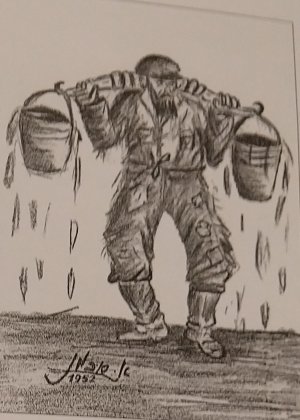
A sketch of a Jewish water-carrier on his horse and cart by Ariah
Suchman.
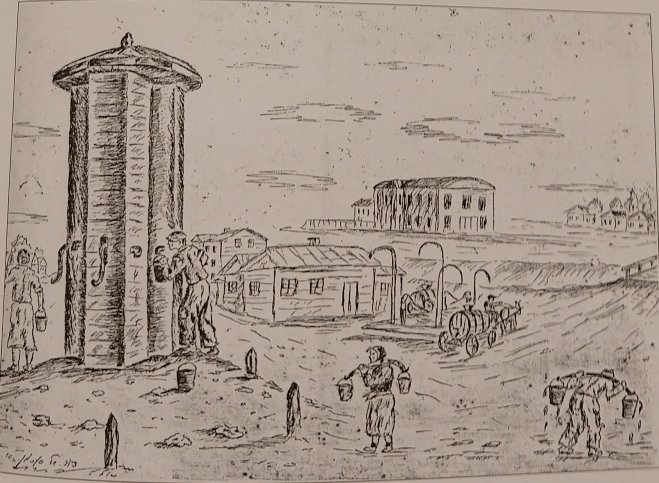
A sketch of the great well in Kolomyya by Ariah Suchman. This well is
mentioned in the book In Praise of the Baal Shem Tov.
p. 68
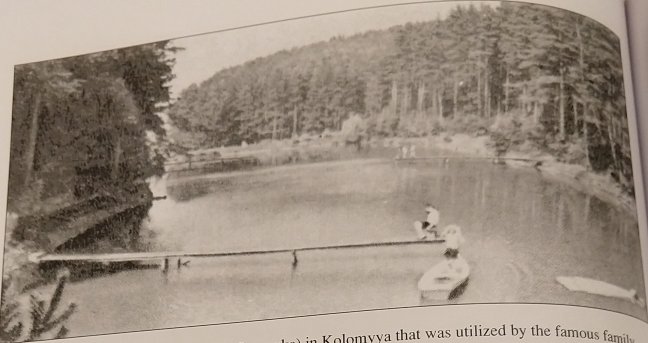
A tributary of the River Prut (The Mlynowka) in Kolomyya that was
utilized by the famous family Bretler flourmill.

A wooden bridge across the River Prut.
A group
HeHalutz HaZair members canoeing. The boy in the left corner of
the picture is the author's eldest brother, Moshe, and the boy third from the
right was his brother-in-law, Menachem Zvingeler, z'l.
The picture
was taken in the 1930s.
p. 69
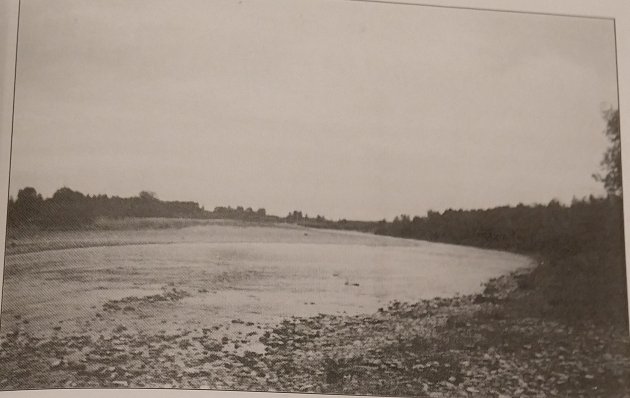
The Prut River in Kolomyya, August 1994

The bridge over the River Prut photographed in 1997 during a visit by
former Kolomyyans to the area. According to tradition, the Baal Shem Tov used to
cross this bridge in order to reach Kolomyya to earn his living and also to pray
in the Hassidic Kossov Synagogue in the Jewish quarter.
p. 70
Documenting the Holocaust of the Jews from Kolomyya and its Environs on film
The project commemorating the Jews of Kolomyya began between the years 1991-1993, in the framework of my activities in the organization of former Kolomyyans. I suggested to the late Mr Yaacob Kinik, the chairman, that there should be a commemorative project, to which he gave his blessing and encouragement. I began to work on the project unhesitatingly, not taking into account the financial and technical difficulties that would be involved in the preparation of a project of this magnitude. It was a God-given sacred mission.
At the 47th memorial service that was held at the cemetery in Nahlat Yitzhak, Rabbi Yona Metzger and many former Kolomyyans attended including the late Mr Yitzhak Teitelbaum, the chairman of the organization of former Kolomyyans in the Haifa area. Mr Teitelbaum was at that time collecting material for a memorial book of the Jews of Kolomyya. He publicly endorsed my project and turned to the people participating in the ceremony asking them to assist towards this sacred project. And so we set out on our project seven years ago; seven years of uninterrupted work often running into days and nights.
During the 47th memorial service for the murdered Jews of Kolomyya in September 1991, I filmed the ceremony. When I watched the film later with my friends, I felt very touched that the event had been documented, and decided that despite the many difficulties that stood in my way, I had to begin the project, at any price. I would give up days and nights for this project, and also as much money as I could to see it finished.
When the ceremony was over, and having completed filming the first video, Yeshayahu Likvornik, a fine Jewish man who survived the atrocities of the ghetto in Kolomyya when he was 12 years old, approached me and asked if I was making a film on Kolomyya. I told him that indeed I was making such a film because I felt that it was very important to perpetuate the memory of the Jews of Kolomyya and its environs. Yeshayahu looked at me with a touch of emotion and a smile on his face as he thought about his mother, brother and sister who were sent to the death camp in Belzec. Only he and his father had miraculously survived. He invited me to his house so that I could hear his difficult story, and perhaps include it in the film.
I arrived at Yeshayahu Likvornik's house equipped with a tape recorder. I was warmly received and we began our interview with his personal story from the time that the Nazis first entered Kolomyya right up to when the city was liberated by the Russian army on 28th March 1944. It was very touching to listen to the stories of the memories of his youth and his family and I was filled with wonder by the fact that he remembered every detail from that period and the exact dates of all the terrible acts that the Nazis had committed and the dates of the transport of the Jews on the death trains to Belzec.
p. 71
Within two years I had succeeded in documenting all the stories of horror from the Kolomyya ghetto. This material served as the basis for the preparation of the filming of the first interview with the Holocaust survivor from the Kolomyya ghetto - Yeshayahu Likvornik. I should emphasize that he is the central person in the film Kolomyya during the Holocaust owing to his unusual stories.
This interview led me to other survivors from the Kolomyya ghetto, eight of them, who related their stories from that period - amongst them Professor Maria Rosenbloom Hirsch, who now lives in new York, and the late Professor Blanca Rosenberg, the wife of Dr Rosenberg from Kolomyya who was the director of the hospital during the period of the Russian occupation and was inducted into the Russian army when it withdrew from Kolomyya on 29th June 1941.
I do not know why Yeshayahu Likvornik approached me to listen to his story about the ghetto of Kolomyya, maybe he had the feeling that I was the right man upon whom to place the responsibility of documenting the destruction of Kolomyya by the Nazis.
I have to tell you my friends, former Kolomyyans living in Israel and the Diaspora, that without Yeshayahu Likvornik, we would not have had the opportunity of perpetuating the memory of the Jews of Kolomyya who were annihilated by the cursed Nazis. He brought us important and authentic material of the horrible riots that took place in the city and exact dates of the aktions and transportations of the victims to the death camps. He suffered through these horrific riots until the ghetto was destroyed and he escaped with his father, the late David Likvornik, with the help of Vasilian Petrovski, a Ukrainian and Righteous Gentile who endangered his and his family's lives in order to save 18 Jews from the hands of the Nazis.
Likvornik and his father remained in hiding for 14 months under terrible conditions fearing they would be discovered until they were liberated by the Russian army, which entered the city on 18th March, 1944. Yeshayahu told me that he would never forget that day because that was the day he emerged from darkness to the light and the air of the world. God mercifully gave them life and they were reborn. It was a sad day too because only he and his father had survived and they never saw their mother, sister Tami and brother, Meir, alive again as they had been sent to die in Belzec. May their dear souls rest in peace.
We, the sons of Kolomyya in Israel and the Diaspora, owe our thanks and recognition of the contribution that Yesheyahu Likvornik made. He encouraged us to commemorate our dear ones who died sanctifying the Holy Name. It is owing to him and his initiative that the film came about in two parts: the ceremony honoring the Righteous Gentiles Vasilian Petrovski and his sister Anya, which took place at Yad Vashem in Jerusalem on 12th November 1997, with the participation of the survivors of Kolomyya, and Professor Dov Noy and a group of high school students.
Behira Zakai, one of the survivors, made a speech that described her suffering in hiding as an orphan with her younger sister after her mother had died in hiding six months before the liberation. It is owing to Behira Zakai that a new chapter has been written in Yad Vashem in memory of the late Vasilien Petrovski and his sister Anyah. The ceremony was presided over by Dr Mordechai Paldiel and the p. 72 deputy chairman of Yad Vashem, Mr Yochana Bein.
The second and main film is the full documentation of the destruction of the Jews of Kolomyya during the Holocaust, where eight survivors relate in detail about the day that the Nazis entered Kolomyya. I hope that our efforts in the preparation of the film with the testimony of the survivors will prove to be valuable for the coming generations and will substantiate for them the tragedy and the destruction of approximately 80,000 Jews of Kolomyya and its environs.
The survivors narratives in the film do not appear in the memorial book of the Kolomyya population. These are new and difficult stories about their escape from the ghetto with the aid of the Righteous Gentiles of Kolomyya.
I would like to state that Mr Tuvia Friedman, Head of the Institute for Documentation and Research into Nazi crimes was interviewed in the film and he tells of the crimes perpetrated by the Nazis in Kolomyya and about the fifteen Nazis who were brought to trial. They were apprehended in Vienna in 1947 with the help of the Russian authorities and were extradited to Siberia.
We faced many problems in the production of the film. Most of the film is made up of still photographs and video, which were filmed in Kolomyya over three years and then brought to Israel. Work began while the communists were still in power, and there was the danger that the film might be confiscated. It was our good luck that we had good relations with non-Jews in Kolomyya who helped us get this important material out. We had to pay them, but it was important to have this authentic material.
Similarly we had problems financing this work, especially in completing the project; the heaviest costs being the editing of the film in the editing studios by a professional editor. A 10-hour day editing job costs $600. This work can continue for a month and a half and includes expenses of recording the interviews with sound, translation, the narration into English, which all come to tends of thousands of dollars. The project will cost over $35.000, money that we obviously did not have. We first approached the Ministry of Education, the late Mr Zevulun Hammer, the then Minister of Education, as we knew he was particularly sensitive to the Holocaust issue. He passed on our request to his advisor who passed it on to the head of the film department at the Ministry of Education, Mr Boris Mafzir. Mr Mafzir met with us and promised to finance 30% of the cost of the project, but to our disappointment we received nothing.
I think that this sacred mission was a bidding from heaven. It makes a contribution toward substantiating the events of the Holocaust for future generations. It helps to explain the magnitude of the crimes and cruelty perpetrated by the Nazi criminals who exterminated the Jews of Kolomyya in eastern Galicia and the annihilation of the Jews of Europe in general during the Second World War.
A film commemorating the destruction of the Jews of Kolomyya is important for those doing research on the Holocaust and could thus serve educational institutions both in Israel and abroad.
I thank the Lord for making it possible.
Ariah Suchman
p. 73
The film: The Jews of Kolomyya
The documentary film on the destruction of the Jews of Kolomyya and its surroundings in Eastern Galicia (the old Poland) deals with Kolomyya from its early beginnings until its destruction in the days of the Holocaust during World War II.
The film presents the events that took place in the Kolomyya ghetto during the Holocaust from the day the Nazis entered the city until its liberation on 29 March 1944, by the Soviet army. The hero who commanded the liberating forces was General Botschkovski, a national hero who is assumed to have been Jewish.
A monument was erected in memory of the fallen soldiers, amongst whom were a number of Jews. May they be remembered for ever.
The entrance of the Soviet soldiers into Kolomyya bestowed a new life on the few remaining Jews who had been hidden by the righteous Gentiles in Kolomyya.
The Second World War and the Holocaust brought an end to the Jewish settlement in Kolomyya and its environs - a settlement that had begun in the 17th century.
Our commitment
We, the last generation of the children of Kolomyya and its environs pass on to our descendants the memory of the horrors of the past that filled our lives. May the commemorative film, The Jews of Kolomyya during the Holocaust, and this book serve as historical documents for future generations, as a memorial for the sacred souls who went up to Heaven in a terrible storm in those dark days that fell on Kolomyya and its environs during the Holocaust.
In the name of the survivors of the Holocaust from the Kolomyya ghetto, we express our deepest thanks to all those who supported us both in Israel and the Diaspora, those who aided us in the completion of the film and this book commemorating the Jews of Kolomyya and its environs who perished in the Holocaust.
Your names will be remembered and we shall be forever indebted to you for your contributions to the commemoration of this sacred purpose.
Ariah Suchman,
Producer
p. 74

The Documentary Film "The Jews of Kolomyya during the Holocaust"
by Arieh Suchman, Producer and Director
TODO: page 74 has not yet been typed/etc.
p. 75
A brief history of modern Poland and Galicia up to the German occupation
In the 18th century, Queen Maria Theresa married the German Duke Franz Stephan Lorient Lutrigen and established the new branch of the Lutrigen Hapsburg dynasty. Maria Theresa was a tall, blonde, stately woman. She was calm and serene, and she was as kind as she was down-to-earth. She was a good mother to her sixteen children. She was plain, but blessed with outstanding emotional strength and an exceptional talent for politics.
Maria Theresa, a patron of the arts, amended many aspects of the government. She nullified the cruel methods used in investigating defendants and established public elementary schools. During her reign, municipal sanitation services were established, a necessity considering the sanitary conditions of the time.
Despite all of Maria Theresa's qualities, she was nonetheless an anti-Semite, and caused the Jewish people great suffering. Maria Theresa ordered the expulsion of Jews from many places, particularly from Prague, the capital of Bohemia, but she was unsuccessful in implementing all of her restrictions. It was during her reign as queen, in 1772, that Galicia was annexed to Austria, following the first division of Poland. This annexation immediately doubled the Jewish population in the Austrian kingdom.
The queen's son, Joseph the Second, introduced reforms that eased the plight of the Jews under the Austro-Hungarian regime.
During WWI, the Austrian army conducted fierce battles on all the western fronts against the Italian army, which was striving to regain control of Tyrol that had been conquered by the Austrians. The Italian army, having earlier on won several battles, succeeded in overcoming the Austrian army.
In southeast Galicia, in Bukovina, Yugoslavia, the Czech Republic and Hungary, the Austrian army suffered defeat by the Russian army. The Austrians fought braavely in the Carpathian Mountains, and despite the loss of thousands of soldiers, the Russian army was unable to defeat the Austrians, or to bring about Emperor Franz Josef's surrender. During the fighting, the Bolshevik revolution broke out, turning things around on the battlefield for the Austrians.
During this time, the Austrian army also suffered losses in northern and central Poland. The Polish Legion, under the leadership of Marshal Pilsudski and Gemeral Haller, tried to limit the presence of the Austrian army in Poland, and to liberate Poland from the foreign occupation between the years 1919 - 1921. The result was the new Polish Republic, with Germany on its western border, Prussia on the north, and the Bolshevik regime along the long eastern border. Rumania, the Czech Republic and Hungary bordered on Poland in the south, along the Carpathian Mountain range.
WWI ended in the Austrian defeat, resulting in an Austria diminished in size. Poland became a large and powerful country under the leadership of Marshal Pilsudski (1921-193) who was a popular leader, and p. 76 the anti-Semitic Poles often noted that he was the protector of the Jews.
Jewish refugees began returning to their homes in eastern Galicia during the late 1920s and early 1930s, only to face the destruction and ravages of the war. Slowly, life began to return to normal. The Polish regime allowed the Jews to deal in commerce and industry, to serve in the army, to study in the high schools and universities. These rights were not easily achieved, and a long and arduous struggle was fought before the Jews were granted the same rights as other Polish citizens.
One of the reasons the third Reich was able to rise to power in Germany was the economic crisis and the severe unemployment. These conditions led to the election of an extremist, Nazi government, headed by a new demon — the nefarious Adolf Hitler. He trapped the German people, who awarded him their full trust. The elderly Chancellor Hindenberg, defeated and humiliated, resigned from the Parliament, leaving the way for Hitler to resolve the national crises, to build up a powerful military industry and prepare the country for war - a war no one could have predicted the results of. The evil speeches delivered by the Nazi oppressor were soon heard throughout Europe, particularly in Poland. The Jews began to sense a black cloud of doom approaching from the western border. They heard the resulting voice of the Nazi army over the radio as they marched through the streets of Berlin shouting "Heil Hitler, as the smiling fuhrer waved at the German crowds anticipating their imminent conquest of the entire European continent.
Evil, venomous voices of incitement and agitation against the Jews could be heard daily over Radio Berlin. The Jews of Poland lived in fear of the Nazi oppressor and the impending invation of Poland. The beloved leader, Marshal Josef Pilsudski, knew what was going on in Nazi Germany. He also understood that the Polish army, armed with outdated weapons and not trained in modern warfare, did not stand a chance against the great German army with its thousands of tanks and airplanes. Marshal Pilsudski was aware of the inevitable future his people and country faced should the Nazi army invade Poland, but he was impotent against the desire of mighty Hitler to conquer all of Poland. In the mid-1930s, Marshal Pilsudski died. All of Poland grieved the loss of their admired leader; millions of Poles flooded the streets to participate in memorial services. The Jews also conducted memorial services, attended by the chief rabbis, mayors and Polish military figures. Slogans, directed toward the Jews, appeared in the streets of Poland, "Your father and grandfater are dead. These were the first signs of Polish anti-Semitism of that time.
Within a short while, Polish Jewry was living in fear. Poisonous anti-Semitism was rampant on the streets of Poland. The Endecja (Polish Nazi Party) recruited its members from the high schools and the universities. The situation worsened, and outbursts of anti-Semitism became increasingly common, with Jews being attacked, often brutally. The German army's invasion of Poland was expected any day. The Polish people paid a heavy price when the Nazis invaded their homeland, but Polish anti-Semitism was deep rooted and needed little prodding from the Germans. They were eager to see Poland free of Jews, and to claim all Jewish property for their own.
In 1939, the Polish people were preparing to protect their homeland from invasion by the Nazi army. p. 77 The Polish army and people prepared themselves, and the civil guard in the cities made preparations for chemical warfare. Radio Berlin continually denigrated and vilified both the Poles and the Jews. The Nazi army paraded in the streets of Berlin, flaunting their tanks in front of sympathetic crowds of millions. Hitler's voice could be heard over the radio, frightening the Polish people, as well as citizens of the other countries he intended to invade.
Kolomyya was located far from the German border and from the dangers of bombings and destruction. The Polish population was not prepared for the possibility of the total devastation the Nazis engineered throughout their homeland, the most brutal and barbarian annihilation ever known to mankind. Kolomyya was relatively calm when the war began. Everyone listened attentively to the radio, and there were many sleepless nights as everyone waited to hear news of the nation's fate, now so unsure and in the hands of God.
As the invasion of western Poland grew closer (September 1, 1939), the population began to hoard basic supplies. They spent all their savings to ensure there would be sufficient food in their homes at the hour of need. Merchants grew rich, amassing great quantities of Polish money, which later became valueless.
The Nazi army invaded with great force along the western Polish border, with every city in western Poland suffering from heavy bombings. Warsaw was hit the worst. The city protected itself bravely, and thousands of soldiers fought like lions, holding back the occupying forces for two weeks. The bombing went on for days. The Polish army did all it could to protect the city against the Nazi army that attacked again and again with heavy artillery. But the Polish army was unable to halt the invasion, and after three weeks of battle, the army surrendered. In the end, Warsaw surrendered after paying a heavy price while severe fires left the city badly scarred. Thousands of soldiers and officers were captured by the Nazi army and led in groups to detention camps. Also thousands of Polish soldiers, Jewish officers among them, were taken captive following the Russian invasion of east Poland in 1939. Later, many of these soldiers and officers were murdered in the Katyn forest, others were sent to forced labor camps in Russia.
During the first days of the war, sirens were heard in Kolomyya, warning the population against the enemy air attacks, but the city was saved thanks to the Molotov-Ribbentrop Agreement, which divided Poland, the west falling under German rule, and the east falling under Communist rule. Thus, during the height of the Nazi invasion, which had almost reached Lvov, Kolomyya woke up one to the sight of Russia tanks quickly entering the city center and flying the red flag from atop City Hall. The population of Kolomyya was relieved. Everyone spilled out into the streets to greet the redeeming Russian army with flowers and candy. Kolomyya was saved from complete destruction, and along with other parts of eastern Galicia, it fell under Russian rule. The Jewish population was saved from the horrifying fate that the cities of west Poland suffered.
In September 1939 the Russian army entered Kolomyya, and the Jewish and Polish population became accustomed to the new regime. The Russians made sure that all residents were employed, both Jews and non-Jews. The Jews managed well with the Russian regime, even better than before. They worked p. 78 where they were placed, and made a living. The population learned to live with the new regime, while hoping for a brighter future.
The Ukrainian population, fiercely patriotic nationalists, did not come to terms with the new regime. They were anxious to see Nazis in power so that they could settle their account with the Jews, wipe them out and appropriate their property. This had been their plan from the days of Chmielnitski.
In a period of twenty-one months, from September 1939 until June 1942, the Germans acted in west Poland to isolate the Jews in ghettos in preparation for their destruction. Many Jews were shot during this time. In a few instances, the Germans deported Jews to the east, to the area of the Soviet occupation. A small number of Jews managed to escape to Soviet territory. However, the majority of Jewry in west Poland remained to meet their bitter fate.
At this time the Soviets ruled east Poland, and in accordance with communist tradition, they arrested the wealthy and the property owners and deported them to Siberia and to other areas in the Soviet Union. This was the fate of the affluent Jews of Kolomyya, and while the deportation was against their will, it was what saved them from the destruction that was the fate of the less fortunate Jews of Kolomyya and the surrounding area after the Germans occupied east Poland.
p. 79
The Out-Break of War between Russia and Nazi Germany (June 22, 1941)
& the Dramatic Developments in and around Kolomyya
The Jewish population began to fear for their lives. Tears welled up in the eyes of all, especially the women, in anticipation of the inevitable. All deliberated regarding the most difficult and fateful decisions - should they stay, or pack up and flee with their families? Should they attempt the flight by train, cart or even by foot to escape the bitter fate of lynch or revenge by their gentile neighbors, particularly the Ukrainians and Poles who eagerly awaited the Nazi invasion to "settle accounts" with the 'Yids'.
Those that decided to leave immediately went to the train station, with only a small valise holding no more than a spare pair of trousers, or an extra coat, or a loaf of bread for the way. From their worried faces, it was clear that they were far from certain that they would actually board the freight train about to leave the station heading for the Russian border. Their only wish was to escape the city immediately, for fear of what they could expect.
Hundreds crowded the train platform in an attempt to flee the city, only to be disappointed. Two freight trains stood at the station, bursting with members of the Soviet army with their families and the possessions they had accumulated during the Communist regime in Kolomyya. The station was surrounded by soldiers and policement who allowed only certain people to board the trains and leave the city. Even those Jews connected to the Communist regime were helpless. Thus, two trains waited on the platform in Kolomyya, packed with Russian soldiers and their families, ready to leave for the Russian border at any moment, while the Jews of Kolomyya were unable to save themselves by boarding the trains. At critical moments like these, people find themselves considering their best moves and weighing up where fate will treat them less cruelly.
On the second day of the war, at 11:00 AM, amid the noise of the crowded train station, the hum of planes could be heard. The crowds at the train station looked up as the planes descended to drop their bombs on them. The sound of anti-aircraft gun's firing pierced the air, and luckily for those at the train station, the guns shot down the planes before they could drop their deadly bombs on the station.
The people in the station, understanding that their city also was in danger of being bombed from the air, tried to force their way on to the over-crowded train. Members of the army and police, already on board the train stopped them, thus determining the fate of the Jews of Kolomyya. Many tried to escape by foot, bicycle or carts, making their way through Ukrainian villages in the direction of the Russian border. Most of those who fled were young men, members of youth movements or students who escaped through fields and avoided all known roads.
The devil awaited them on the sides of the roads leading to the border. Few reached their destiny, and those that did get to the border arrived hungry and exhausted. The German planes bombed the roads leading to the border, as well as the bridges and train tracks, making progress very nearly impossible.
Hard times hit the city. Parents accompanied their conscripted sons as they left for the front. Mothers hugged their sons, weeping with the thought that they may never see their beloved sons again. Grandparents walked with grandchildren, mumbling prayers begging that their young be delivered from p. 80 the fate they knew in their hearts awaited them. They prayed that for the young who had never had a chance to enjoy life, be spared from all harm. Despite the anxious prayers, few returned from the war. The Russian army's retreat from Kolomyya and its environs tragically ended in failure. The Nazi army swiftly advanced in eastern Galicia, and the Nazi tanks overtook the large Russian forces, now downtrodden and retreating. Thousands of soldiers, many of them Jews, were unable to cross the border. They were taken prisoner by the German forces, and shipped to camps. There they were systematically murdered to the last man.
Hundreds of Nazi planes continuously bombed the cities and towns in Russia and the Ukraine which went up in flames from the constant attack. The devastation was nearly total. Millions of people had fled their homes, leaving all their possessions behind. The Fuhrer had won a tremendous military success, and by this time almost half of Europe was under his foot. The important powers, England and France, had done nothing to hinder his military advance.
Hitler hoped that the powers would not interfere when his army invaded Russia. In August 1938, upon his return from Moscow with a non-aggression pact, Hitler told his Foreign Minister Ribbentrop, that he had taken care of Russia, and that he had "tricked" Stalin. But Hitler was wrong. The Allied powers joined the war, and eventually defeated Nazi Germany.
Of the groups of young people from Kolomyya who had tried to cross the Russian border by fleeing on foot through fields and forests, few were successful. Only those with vehicles succeeded, and more importantly, only those with firearms, to protect themselves from Ukrainian villagers succeeded.
Hundreds of young Jews in Russian army uniform marched towards the Russian border, together with droves of Jews from Kolomyya and the area. Without guns to protect themselves, they wer brutally murdered by Ukrainians bearing knives and axes. The cruelty of the Ukrainians knew no bounds, even stealing the clothing off the backs of their victims.
Back in Kolomyya, on the night between June 29th and June 30th, 1941, the Red Army took leave of Kolomyya. Before leaving, the Russians destroyed the mail, telegraph and telephone infrastructure, and blew up the train station. They took Ukrainian and Polish prisoners, and set the Jewish prisoners free. The non-Jewish population was infuriated by this last move.
After the Russian evacuation, the Jews remaining in town feared the Ukrainians, known for their hatred of the Jews. The Ukrainians were eager to take revenge on those who had enjoyed good relations with the Communist regime. The Jews boarded up their houses, and tried to protect themselves from a pogrom. It was not long before the Ukrainian mob broke into the deserted Russian camps and stole the weapons and supplies they had left behind. Chaos broke loose, and the marauders began fighting among themselves, as all tried to seize the supplies the Communist regime had left behind.
The Ukrainians lowered the Russian flag above the Town Hall, and replaced it with the independent Ukrainian flag. The mob, armed with Russian guns, wandered through the streets, breaking into Jewish homes and stores. They plundered Jewish property and fired at those who resisted. The rioters advanced, overcoming all obstacles, as fear and dread grew among the Jews. The city was in turmoil, and only a miracle could have saved the Jews from annihilation.
Temporary salvation came in the form of the Hungarian Army. They invaded Kolomyya and the surrounding area within 24 hours of the Russian evacuation. Soldiers filled the city, took up the central positions and proclaimed the imposition of Hungarian military rule. The anarchy in the city ceased, and p. 81 the Ukrainians, who had intended to assist the Nazis in annihilating the Jewish population, were unable to continue with their diabolic plans. The Hungarian army stayed in the city as an ally of the Nazi authorities until the end of 1941, awarding the Jews a few months peaceful respite, until the Hungarians left Kolomyya. Once the Hungarians left, the Gestapo moved in, implementing horrific acts which few survived.
The 'glory' of German victory continued until the winter of 1941. The defeated Russian army meanwhile made its preparations to defend Russia against the Nazi army. They dug defense trenches, and the Nazi invasion of the Soviet Union came to a halt immediately. When the Russian army received military reinforcements and new weapons, it began to attack the enemy. The Russians fought the Nazis in bloody battles, and many Nazi soldiers were taken prisoner. Slowly the Russians gained the upper hand, and the vast and illustrious Nazi army was eventually defeated near Stalingrad, and tens of thousands of soldiers were taken prisoner. The Russian army moved forward to liberate the land from the Nazi oppressor while the Fuhrer was beside himself with rage because of the swift defeat of the great Wermacht.
A day or two before the liberation of Kolomyya, the thunder of canons was heard throughout the city. The Nazi army knew their end was near in face of the swift advancement of the Russian army, now strengthened by a large armored corps. Hundreds of thousands of soldiers were pushing forward conquering the region adjacent to Kolomyya.
The survivors that had been hiding in the bunkers under extreme conditions knew they were soon to be released from their suffering. It was hard for them to believe that they would see daylight soon, after fourteen months of living in constant fear, darkness and mortal fear of the clutches of the Nazis and informers. The day of redemption was approaching, and they were soon to be free, soon to breathe fresh air and enjoy sunlight.
One of the few righteous gentiles who had given refuge to a number of Jews was Vasilian Petrovsky and his sister, Anya, and when the first Russian soldier entered Kolomyya, Anya, entered the hideout, smiled, and quietly gave notice of the city's liberation. She asked them not to leave the bunker all together, so as to avoid the attention of the neighbors. Anya said good-bye to everyone, and hugged the survivors and wished them well. It is hard to describe the survivors tears and joy as they left the yard of the Righteous Gentile, Vasilian Petrovsky at 50 Krashevsky Street, Kolomyya. Departure from the bunker in the initial hours after liberation was very dangerous. The Ukrainians wondering the streets were capable of killing any and every Jew they saw. The survivors had no idea where they should go or where to spend their first night above ground in fourteen months. Eventually all sixteen men, women and children found their way to the center of town, and were witnesses to the liberation of the town by the Russian soldiers from the Nazis.
Large military units entered the city, and unfurled the Red Flag over the Town Hall. The Russian regime had returned to the city after departing on June 21, 1941. All of the Jewish survivors gathered in a building in the center of town to discuss the best course of action. Only a few had survived the tumultuous war years, and the city had been ravaged past recognition. The Jewish ghetto had been burned, and the handful of survivors wept at the site of the destruction and the recollection of their loved ones who had not survived.
On March 28, 1944, the city was officially liberated by General Butschkovsky, a national hero. The armored division that had fought in many bloody battles and destroyed the Nazi forces surrounded the p. 82 city of Kolomyya. The heroes that fell during the battle of liberation were buried in the town's military cemetery, and a memorial was built in the town's center to honor their memory.
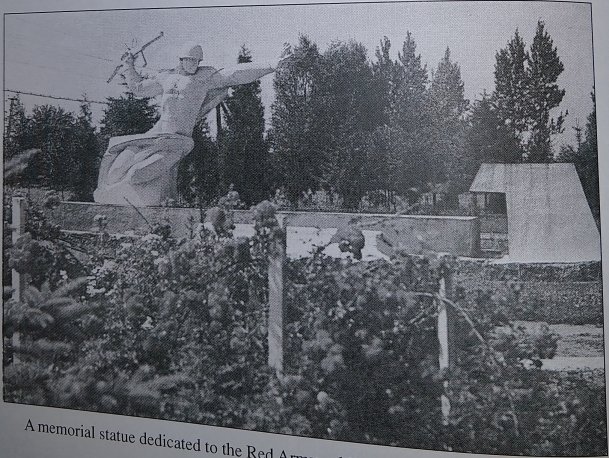
A memorial statue dedicated to the Red Army soldiers who fell in the
capture of Kolomyya - 28.3.1944
p. 83
The Nazi German and Soviet Union pact
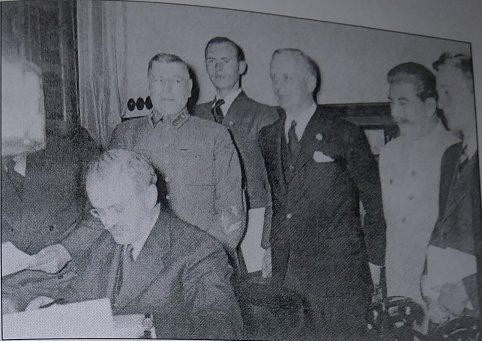
The signing of the non-aggression pact between Germany and the Soviet Union on
August 23 1939. This pact, which was preceded by an economic agreement, in fact,
enabled Hitler to launch his attack on Poland, which led to the outbreak of the
Second World War. One of the clauses of the pact was the partition of Poland
between the Soviet Union and Germany, which delayed the extermination of the
Jews of Kolomyya by two years. On 22.6.41 the Germans attacked the Soviet Union
in violation of the non-aggression pact. In the picture, Molotov is signing the
pact, while Stalin looks on, and the crafty Ribbentrop is pleased.
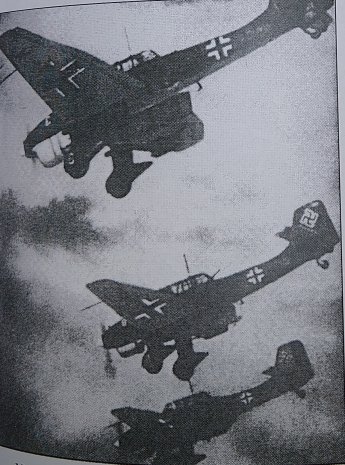
Nazis planes bomb Polish cities - 1.9.1939
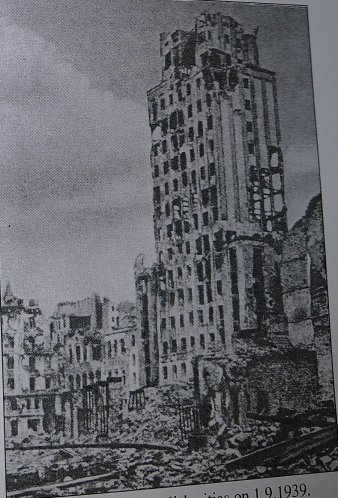
Nazis planes bomb Polish cities on 1.9.1939. Warsaw under aerial attack.
Kolomyya was not bombed because the area had been annexed to the Soviet Union in
the Molotov-Ribbentrop Pact. In June 1941, when the Germans invaded the Soviet
Union, they bombed Polish cities but miraculously Kolomyya was left
untouched.
p. 84
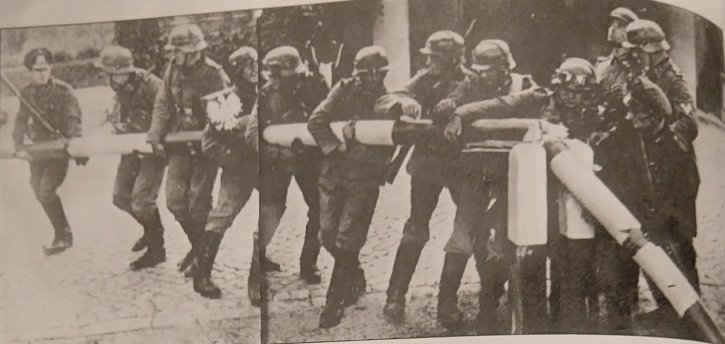
German soldiers removing the barrier on the western border of Poland on 1.9.1939
at the beginning of war.

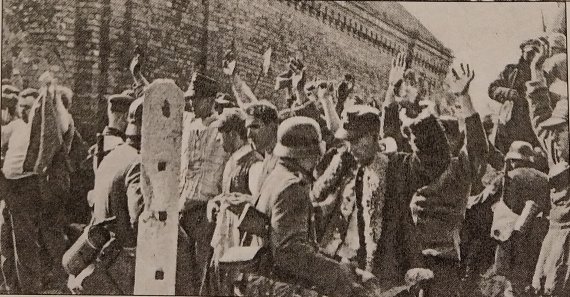
Thousands of defeated Polish soldiers taken captive and being led away by
soldiers of the Wehrmacht, (the Nazi German Army).
p. 85
Order of the Day of the Nazi Army on the Eve of its Invasion of Poland
from Hitler's Statement to the Commanders of the German Army, the Wehrmacht
On 22nd and 23rd August 1939, Hitler held a series of meetings with the commanders of the Wehrmacht (the German army) in Obersalzburg.
Here are some excerpts from his remarks:
... Our first task is the destruction of Poland. Our aim is to crush the enemy armies and not to reach any particular line.
I shall give our propaganda some reason or other to justify the outbreak of war, and it is not important whether it is true or not. They will not ask the victor if he spoke the truth or not.
At the start of the war and in the course of it, the question is of victory and not of its legitimacy. We have to advance brutally and in no case show mercy. Justice and law are with the strong ... therefore, I have prepared my Toten Kopf units (The Death's Head - the SS) and ordered them to kill mercilessly every man, woman and child of Polish origin....

The Nazi army on the march
p. 86
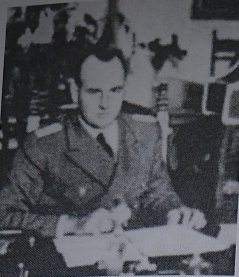 General Governor Hans Frank
General Governor Hans Frank
12 października 1939 r.
Hitler podpisał dekret
o administracji
okupowanych ziem polskich,
który wszedł w życie
26 października 1939 r.
Tego samego dnia
Hans Frank mianowany
generalnym gubernatorem
wydał rozporządzenie
o odbudowie polskich
obszarów zwanych od tej
pory Generalnym
Gubernatorstwem.
Obszar GG podzielono
na cztery dystrykty:
Kraków, Lublin, Radom
i Warszawa,
a 1 sierpnia 1941 r.
dołączono piąty,
tzw. Galicję.
Powierzchnia Generalnego
Gubernatorstwa wynosiła
ok. 145 km2 z ok. 17 776 mln
mieszkańców.
Siedzibą władz GG został
Kraków. Warszawę za to
uznali Niemcy
za najbardziej
niebezpieczne miasto w GG,
wyznaczając specjalne
ekipy administracji
hitlerowskiej, które miały
przejąć od dowództwa
Wehrmachtu władzę nad
miastem.
On 12th October 1939, Hitler signed an adminstrative order concerning the occupied Polish territories. The order came into effect on the 26th October. On the same day Hans Frank was appointed the Generalnym Gubernatorem (General Governor), an order was issued for the reconstruction on the occupied territories of Poland that were to be referred to as Generalnym Gubernatorstwem (General Government). This area was to be divided into four districts: Krakow, Lublin, Radom, and Warsaw. On 1st of October, a fifth district was added to the Generalnym Gubernatorstwem, Galicia. The whole area was 143 square kilometers and the population numbered 17,776,000. The capital city was Krakow. The city of Warsaw was considered to be the most dangerous of Polish cities, and therefore, they appointed an especially highly trained group from the Wermacht to administerit.
p. 87
War breaks out between Communist Russia and Nazi
Germany
22. 6. 1941
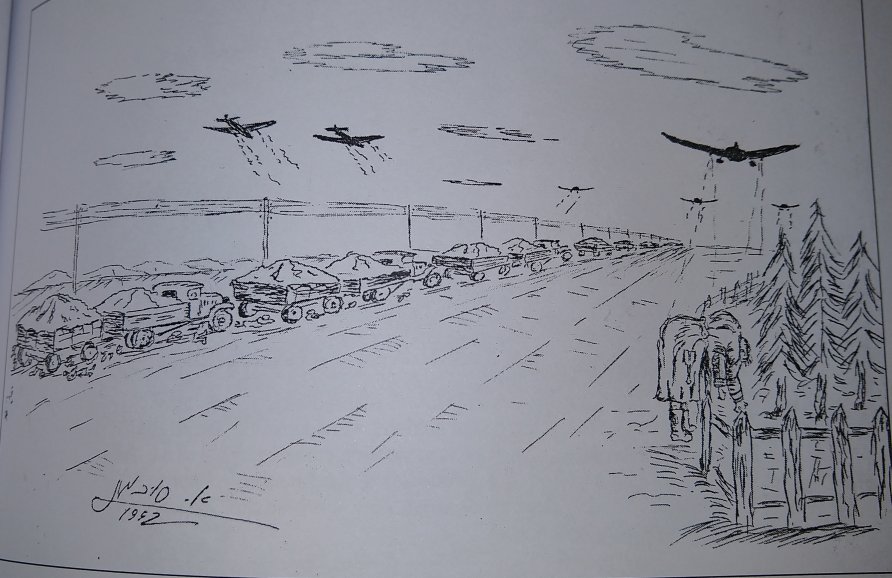
The last Soviet forces withdraw from Kolomyya in the night between 29 and
30.6.1939 across the old Russian frontier. During the withdrawal, the Russian
convoy was attacked by Nazi planes causing heavy losses. During this attack a
Jewish soldier was killed. He was the son of Rabbi Bocher.
His dead body
remained hanging over a fence on the side of the road.
The sketch is by
Ariah Suchman.
p. 88

Jewish soldiers in the Red Army taken prisoner by the Nazis shortly after
the invasion of Russia in June/ July, 1941.
The Jewish solders were separated immediately from the non-Jewish soldiers and
sent to an extermination camp by order of the German Command. According to the
Soviet authorities in the first three months of the war
4 million Soviet Army soldiers were captured. Few survived the German
internment.
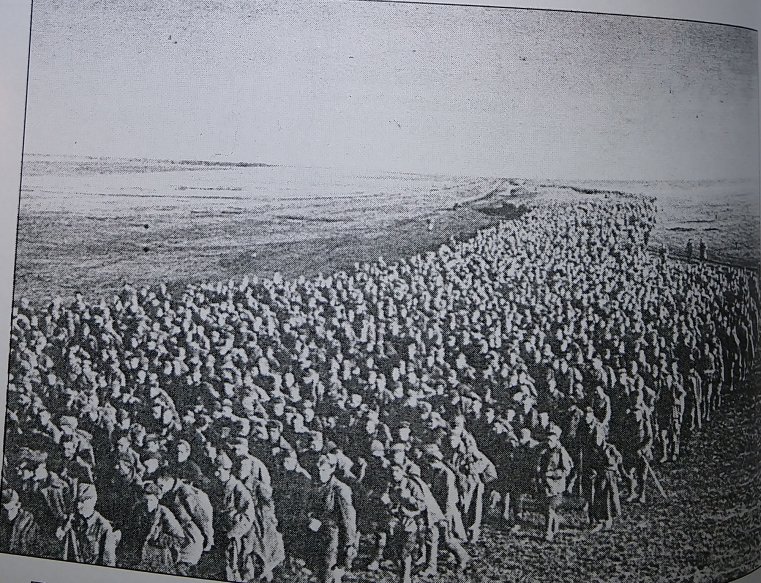
Thousands of captive Red Army soldiers being led to
army prisoners’ camp in 1941.
p. 89

The statue of Lenin, erected by the Soviets, replaced the statue of
Josef Pilsuzki when the Russians entered Kolomyya in 1939.
When the
Germans conquered Kolomyya in the summer of 1941, the Ukrainians forced 250 Jews
to pull down the statue using only ropes and then drag it to the
market place where it was destroyed.
p. 90
In Recognition
by Bhira Zakai

Behira Zakai

Hana Haklayi,
Behira's sister
At the outbreak of war in 1939, there 18,000 Jews in Kolomyya who were joined by refugees from Germany (who were expelled from Zbonshin) and refugees from that part of Poland that had been conquered by the Nazis.
In the 30's many Jews in the area suffered financial difficulties. The Polish authorities, who were prejudiced against the merchants (many of whom were Jews), established cooperatives that competed with the merchants' businesses and added to the tax burden that made life all the more difficult for them. The situation served as a warning to the Jews. Despite the difficult times, the Jews absorbed the refugees and welcomed them to join their diverse activities: social events, a cultural associations, educational programs, and cultural activities in Yiddish, Hebrew and Polish. They were part of the active and vibrant community. However, all these activities took on a new form with the Soviet conquest. The rulers tried to steer the Jewish way of life in the direction of the revolution. This affected many of the Jews. Several were arrested, several exiled, and the religious Jews had to practice their rituals in secret.
These were two very trying years until the Soviets were defeated by the invading Germans.
The Nazi conquest brought to a halt Jewish life and activities. The Jews were soon closed off in the ghetto and commandeered to work for the German war effort. They were isolated from their surroundings, suffered from hunger, overcrowding and disease, and the most terrifying of all, they were being physically annihilated.
The first groups to suffer were the stateless refugees, then the intelligentsia, the Soviet supporters and very soon every single Jew. It is estimated that there were 70,000 Jews in the ghetto in Kolomyya (Jews from the towns and villages were gathered together in order to be sent to their fate). A few, some tens of local Jews survived - and it is these that took upon themselves their life’s mission - to remember those Jewish members of the family from Kolomyya who had perished, and commemorate their activites and contributions to the Jewish way of life.
Of the few who remained, some have repressed their past for fear of remembering the inferno. They have shrouded themselves in silence. Some have told their story to close family members, and some have narrated their memories to the authors of the book of Kolomyya. But this is not enough. We have to p. 91 leave a testimony for future generations.
Ariah Suchman has invested endless days and nights in gathering details about the people of the area and their activities, their contributions and how they were ensnared into the death-trap by the Nazis and their collaborators. He edited these testimonies in a commemorative film and this book. They will serve as a memorial for generations to come. His labors have established a monument for the Jews of Kolomyya. May he and his outstanding labors be blessed.
A Visit to my City, Kolomyya
by Bhira Zakai
As a child, Kolomyya was for me a typical Jewish city. It was so full of stories, so many uncles and aunts and cousins, neighbors and friends! Jews lived in Kolomyya for centuries through all its metamorphoses and vicissitudes, in bad times, prosperous times, difficult times, and in times when they were the object of hatred of the local people.
I remember the people, the children, the schools, the kindergartens, the boys and girls who used to walk along the streets of the city. On my arrival in the city 52 years later, I felt that the city was now a city without any Jews.
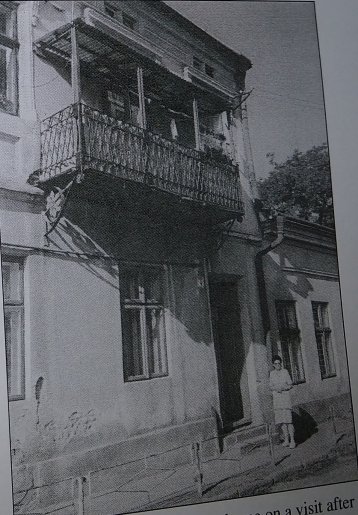
Behira standing outside her home on a visit after the Holocaust.
I knew that the Jews of Kolomyya had perished. Throughout the years of the war I had been in the city, and on the day that the Soviets arrived in 1944 when the few Jews who had survived were reunited. And now, on my return trip to Kolomyya, I met one person who claimed to be a Jew. Perhaps there are more Jews who hide their Jewish identity.
The day I came to the city I realized that I had come to a graveyard - a city of the dead. The Jewish cemetery serves as a garbage dump. The gravestones have been uprooted and were used in the foundations for monuments or for other building purposes. And next to the pit at Shoporovtza where 22,000 Jews were shot to death, a cross stands surrounded by a chain and several small crosses. These crosses were placed there by the locals as a memorial to the Jews of Kolomyya and the surrounding areas. Their tombstone is a cross. That is the city that I found.
p. 92Some of the houses are still standing untounced. The ones that were within the ghetto are mostly destroyed. Only the Baron Hirsch school, which served as the Judenrat, still remains and the house opposite which served as an orphanage and in the ghetto as a hospital, overlooking an empty street.
For close to 50 years I avoided writing my story. I hardly even talked about my experiences. I remember several important details. I read the testimonies of my fellow citizens and I listened to the survivors. I knew that several of my family members perished and that I have to perpetuate their memories. It is my obligation to tell their stories and to pass them onto my family.
When I visited Kolomyya, I went to the house where I was born. There are people living in it and I did not dare go in. It still stands today as it was then, only my family is not living in it. It stands at the entrance to a small and desolate marketplace. It has no shops, nor vendors and the Beth Knesset (Synagogue) that served the vendors is gone.
The second place I went to was the house of Vasilian Petrovski, the man who saved us and was a Righteous Gentile. Petrovski endangered his life and the lives of his family to save 16 Jews from the inferno. It seems that there were very few of these righteous people, one in the city and one in the country. He knew what punishment awaited him if he were to be discovered. He knew the fate that awaited him and that of the Jews he was hiding, and despite that he continued and persisted in protecting them by giving them a place to hide.
I also visited the city where I was born and found evidence that once Jews had lived there, and now there are none. They perished at the hands of the Nazis and their henchmen.
p. 93
Testimony of the holocaust survivor from Kolomyya,
Edith (Icia) Glasberg, neé Hausmann
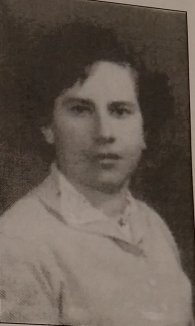
Idit (Itzia) Glazberg neé Hausman, Holocaust survivor
Edit Glasberg was the daughter of Dr. Wolf Hausmann, a pediatrician, and Haya Hausmann - a pharmacist, who owned a pharmacy on the corner of Jagellonska Street and Alleje Wolnoschi in Kolomyya.
On June 21, 1941, I was returning from an end of the year party in school, and the same evening we heard that war had broken out between the Soviet Union and Germany. That very same night, the Red Army mobilized my father with a large number of other doctors. I cried a lot when we parted and at that time I didn't know that my tears would influence my father's decisions. In fact, my father endangered himself and fled from the Red Army, in order to return home. He returned without knowing that a cruel fate awaited him - death at the hands of the Nazis. On 29.6.41, the Soviets retreated to the great joy of the Ukrainians who believed the German promise that the Ukraine would be set free. The rejoicing of the Ukrainians knew no bounds. I saw processions of Ukrainian villagers, each village in its traditional costume, singing and celebrating.
My father returned home with his feet full of blisters from continuous walking, because he had not managed to get any transport, not even at the cost of a valuable gold watch. We were very happy and didn't imagine what fate lay in store for him in the near future.
Within a few days the Hungarians entered Kolomyya in order to impose order and remained until the arrival of the Germans. They compelled my parents to put up a Hungarian colonel in one of the rooms of our apartment. The colonel spoke German and found a common language with my father when they talked about their First World War experiences.
A few days later, Kreishauptman Folkmann, the governor of the province arrived in Kolomyya. His assignment (given to him by the head of the Gestapo, Peter Leidritz) was to set up a Judenrat and a ghetto in Kolomyya.
On the outskirts of the town, notices were posted requiring all Jews to bring to Folkmann's office: jewelry, gold, money and all furs. Anyone who refused would be sentenced to death. The Jews flocked to his office and brought what was asked of them and in return they received a little receipt.
One day Folkmann arrived at our apartment house, and this was because he had heard about our fine house, its furniture, carpets and fine porcelain. When he arrived, I saw before me a young man, sturdy and energetic, who had climbed the stairs rapidly and entered the corridor of our apartment. On seeing p. 94 the coat of a Hungarian colonel, Folkmann left the apartment without uttering a word. The next day the Hungarian colonel bid us farewell saying that he had received an order to leave.
A day or two passed, and on 15.8.41 which is the Catholic feast day, at a time when the streets were full of worshippers returning from the churches, happy and gay, a man from the Ukrainian militia (which had been set up in the meantime by Folkmann) came to our house with an order from Folkmann to arrest my parents. An hour passed and another militiaman arrived with an order to evict me from the apartment forbidding me from taking anything with me. I was to leave in just what I was dressed at that moment, (in a summer dress and sandals), and to lock up the house.
The same Ukrainian, who I had never seen before, and whose name I don't know, told me that my father had saved his son from death and he would not forget that. He ignored the order, went into the back room in our apartment so as not to see, and enabled me to take a few things, as if without his knowing. I threw everything I could grab into the courtyard as quickly as possible. The man locked the house and I remained alone with the few belongings that were in the courtyard, because I had no family in Kolomyya.
Everything that had happened in my house reached the ears of Ms. Herman, the owner of a restaurant next to my mother's pharmacy, and she took me into her home. I was with her until the flight from the Kolomyya ghetto in autumn 1942. A few days later, I saw the Germans come and take away all the contents of our house: carpets, porcelain sets, cut glass etc.
Before the Gestapo had arrived in Kolomyya, some Polish doctors, headed by Dr. Kalinievitch, the director of the hospital in Kolomyya, acted to get my parents out of the prison. They prepared a certificate of ill health, and as a result my parents were transferred for treatment in the hospital on Dr. Kalinievitch's personal responsibility, and so I was able to see my parents whilst they were in the hospital.
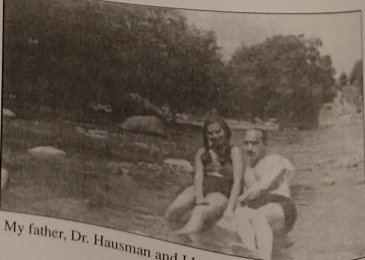
My father, Dr. Hausman and I before the outbreak of war, 1939.
In the meantime, the Gestapo arrived and began its aktions. Germans wandered through the streets of towns and ejected Jews from their homes, partly from information supplied by the locals and partly by chance. In this way, two of my best girl friends were taken on the same day: Prilingo and Rotenberg, each of whom lived in a different part of town. One day there was an aktion on Mokre Street, hundreds of Jews were caught and taken to the Szeperowce (Shoporvtza) Forest. They were taken to their death and their families remaining in the town could not believe that they had been put to death.
When Folkmann arrived in Kolomyya, the Jewish community was headed by Professor Schweitzer. Schweitzer was killed, and instead of the Jewish Community office, a Judenrat was set up to which Jews were p. 95 appointed according to the wishes of Folkmann.
We knew that in the Judenrat there were people on good terms with the Gestapo, and that through them it was possible "to arrange" matters. I gave gold to Jakobi, a member of the Judenrat, so that he would arrange the release of my parents who were still in the hospital as prisoners, (apparently without the Gestapo knowing about them).
And in fact, a miracle occurred, my parents were released from the hospital as free people, but the miracle only lasted for a few days.
My parents had nothing, because Folkmann had taken all that they had accumulated over many years. They thought to begin afresh. Autumn arrived and children were falling ill. My father was summoned to care for the sick, and at night my parents slept in the home of the photographer Kibler.
This lasted for only a few days. And then one day a Gestapo agent came to the Herman family to arrest my father. My father wasn't there and so the agent ordered us to inform my father that we was to come the next day to the Gestapo between the hours of 8 and 10 a.m.
Many offers for hiding reached my parents from Polish friends - among the offers were also hiding places outside Kolomyya. My father didn't accept the offers, saying that it was preferable that, one Jew should go, instead of a whole street in his stead being taken, as had happened in the aktion in Mokre Street. He went alone to the Gestapo; through the corner window in the apartment of the Herman family I saw him go off in the direction of the prison.
The story was repeated - my mother was not home when a Gestapo agent came to the Herman family looking for her. Again a Gestapo agent ordered that she should come to the Gestapo. When my mother heard that she had to go to the Gestapo she said, "I am not prepared to endanger the others." She went, and again I saw her being taken by the Gestapo. From that day on, I have not heard anything from my parents, or about their fate. They were victims of Folkmann.
In the spring of 1942, the Jews were compelled to move to the ghettos that had been established in three neighborhoods. I moved with the Herman family, five souls, to a tiny room in the first neighborhood. Only one small room was allotted to the whole family, and we had to find some small metal stove for cooking, and the basic necessities.
On Passover, without warning there was an aktion. The Germans entered the house and shouted "Juden raus!" - Jews outside - and led them all to the big synagogue. The meal that had been prepared had been obtained with great effort remained on the stove.
At the entrance to the synagogue a selection took place. Most of the people were directed to the big hall - to death; a small number of young people were directed to a small room - to life. Me, they chose for life. After several hours we were transferred from a room in the "big" synagogue to another synagogue nearby, and in the evening this small group was released.
The people who were released could not believe that they were alive - they ran in the street and pinched themselves in order to be sure that they were really alive.
When I returned to the tiny room in the ghetto, the Herman family were nor there. They were among p. 96 those sentenced to death. Miraculously, they managed to get themselves released by bribing someone. And so they were able to flee the next morning.
Thousands did not return. They were led off to the Szeperowce Forest - to death.
In order to survive it was necessary to obtain an Ausweis (a work permit) that would enable one to leave the closed ghetto that was guarded by Ukrainian and Jewish militia. I went to the Arbeitz Platz Umschlagplatz (the assembly point), for transport from which Salomon, a member of the Judenrat, sent various people to various jobs, according to the German requirements. I managed to obtain a work permit and get out of the ghetto.
During the whole of the summer, although there was no aktion in the ghetto, elderly people were taken according to a list issued by the Gestapo.
There were arrests. One day a number of people were taken, well-to-do people who before entering the ghetto had hidden part of their property with a rich Ukrainian named Homiak. He saw to it that they died by informing on them in order to avoid having to return their property to them.
Life in the ghetto was hard; anyone who didn't have the means was condemned to die of starvation, in spite of the soup that the Judenrat distributed to a few needy people. The month's ration of bread that was distributed only sufficed for a day.
I saw starving people, some of them looking like walking skeletons, others swollen with water. They called this "dry hunger" and "wet hunger". It was a slow and cruel death. Every day I saw bodies dying from hunger collected on carts to be taken to a mass grave.
In the summer, Jews from the towns and villages around Kolomyya were brought to the ghetto, and the overcrowding in the ghetto was terrible.
In autumn 1942, near to the holy festivals, notices were posted in the ghetto. On the day appointed, every Jew who possessed a work permit had to report with his family, nicely dressed, at the assembly point at the Arbeitz Platz. The notice promised that those who reported would be safe and those who hid would die. The reality was different. Those who listened to the promises were the first victims. After they had been collected, the search for those in hiding began. They all suffered the same fate, a cruel death. Some were shot in Szeperowce Forest, others were sent by train to the gas chambers in Belzec.
Before the aktion, which they had announced in advance, I managed to get out of the ghetto and found a hiding place in an abandoned house, opposite the Gestapo building. Through an opening in the attic I saw the preparations for the aktion. During the whole night, the Gestapo building was lit up. The Gestapo men wandered around and drank unceasingly, and the town dogs howled without respite.
In the morning, I saw the Gestapo go off to the aktion, and within a short time a line of Jews began to stream along Kraschewski Street, on their last walk to the Szeperowce Forest. Thousands of people, partly on foot, partly in carts harnessed to horses, proceeded to their deaths. The convoy moved slowly and seemed unending. This terrifying spectacle will be with me until the day I die. From my hiding place I could not see those being taken to the train on their way to the gas chambers in Belzec.
p. 97 A few days later I returned to the ghetto. Of the three neighborhoods, only one remained. From the few, who had survived, I heard how they had been forced to strangle their babies so that by their crying they would not give away those who were in hiding. I heard how the Germans cruelly pulled out those they found hiding, how they threw small children against the walls to shatter their heads. The survivors told hair-raising stories. I heard that doctors caught by the Gestapo poisoned themselves before the Germans had time to kill them. The head of the Judenrat - Horowitz, and his sister, also poisoned themselves. I understood that the sole chance of surviving lay in trying to flee from the ghetto.
On the outskirts of the town, notices were posted threatening the population with death of the entire family, if they hid a Jew, and the people were afraid to help Jews.
I managed to flee from the ghetto and thanks to some good Poles who endangered themselves and their families and with a lot of luck, I remained alive.
In 1944, with the arrival of the Red Army, I was free, and I shall never forget the wonderful feeling of freedom after such a long period of indescribable suffering.
When I returned to Kolomyya I heard to my great sorrow, from Poles who had seen my parents in autumn, 1941, that they had been taken to Szeperowce. They were victims of Folkmann,
I visited the place where the first neighborhood of the ghetto had been and the house I had lived in. Only a few stones remained scattered on the ground, and of the Jews of Kolomyya only about 70 people remained (apart from those who had fled to Russia or other places far from Kolomyya). The Nazi beasts exterminated entire communities from Kolomyya and the environs totaling of about 80,000 people, men, women and children.
In 1998, I visited the Szeperowce Forest with my family. The trees were growing over the bodies of the murdered victims. In the forest, the Ukrainians put up a tall cross and a memorial was erected by the survivors to the memory of the Jews murdered and buried in the Szeperowce Forest. That is the little that remains of the tragedy that took place there.
The "D'Yerushalaim" Synagogue in Kolomyya miraculously remained undamaged, and we are happy to report that a minyan is held there on Sabbaths and festivals.
p. 98
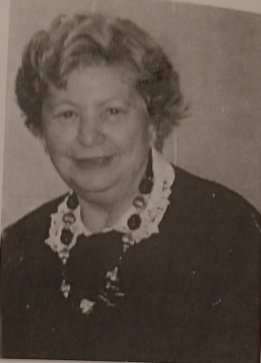
Professor Maria Rosenbloom
To Professor Maria Rosenbloom
On behalf of the survivors of the ghetto of Kolomyya now residing in Israel, we would like to express our deep gratitude to a fine and wonderful woman, a survivor of the ghetto of Kolomyya, Prof. Maria Rosenbloom, the daughter of Shmuel Hirsch, for her untiring efforts and loyalty to the project commemorating the Jews of Kolomyya who are sadly passing away. The project was prepared for the future generations in Israel and the Diaspora so that they may see and know about the terrible destruction of the Jewish people in Europe and especially the cruel annihilation of the Jews of Kolomyya. Her contribution and that of the family of Dr Menek Goldstein serve as a testimonial to the memory of our dear ones who were tortured and murdered in the ghetto in Kolomyya during the Holocaust.
With thanks and recognition to you Maria Rosenbloom. We shall not forget how wonderful you were and the help you gave us that enabled this historical project to reach a successful completion.
Ariah Suchman
p. 99
An interview with Maria Rosenbloom
Interviewer: Arieh Suchman
Maria Rosenbloom, formerly a professor of social work at Hunter College of the City University of New York, came from the United States on a visit to Israel. She was interviewed in 1994 about her experiences in the Kolomyya Ghetto, and about her flight from the ghetto to Lvov, to the Aryan side, using a false identity. The interview was held in English.
In 1939, Maria, the daughter of Shmuel Hirsch, a respected businessman in Kolomyya, the owner of a wholesale store for household goods, married Nunek Neider, the son of the owner of the pharmacy in Kolomyya. The two of them studied at the university in Lvov. Here is a summary of her testimony:
On June 21, 1941, when the Germans attacked the Soviet Union, we were visiting our families in Kolomyya and planning that day to return to Lvov. On our way to the railway station, we noted that Soviet families were leaving, in a panic, boarding trucks and buses. They were on their way to Russia. At the railway station, we were told that trains were not available to the civilian population, and so we returned to our families in Kolomyya.
When the last Soviet soldier left the town, I was a witness to the rampage of the Ukrainians in the streets. They ransacked Jewish stores and warehouses, and also shot Jews in the streets. At the beginning of July, the Hungarian Army entered Kolomyya. They immediately restored order, and the rioting of the Ukrainians stopped.
In August, the Gestapo entered Kolomyya. The aktions against Jews began immediately. At first, they arrested the intelligentsia, lawyers, doctors, etc. The victims were led to a forest next to the village of Szeperowce, about 10 kilomeeters from town. There they were shot and thrown into a pit, which the unfortunate people had been ordered to dig for themselves.
Afterwards, they carried out abductions of Jews in the streets, and they too were murdered in the Szeperowce Forest.
The Gestapo ordered all the men to report for forced labor. The work was very harsh and the cruel. Overseers struck the people on their heads with they whips in order to make them work quickly. My husband, Nunek, received permission to work in the pharmacy outside the ghetto since the Germans needed medicines, and so he was able to obtain some food for the family.
At the beginning of 1942, the Judenrat was established. It was headed by Mr. Markus Horowitz. Nunek and I lived in the ghetto together with my parents in a small narrow room (before the war I had lived with my parents in a spacious house at 9 Kosciusko Street). There were no food supplies. Many people were starving and many died from starvation. Every morning I saw corpses lying in the streets. Among the dead, I recognized my teacher from the gymnasium and some relatives. They piled the corpses onto a cart hitched to an emaciated horse that could not stand upright. We called the horse the "Messiah Horse" because we envied those "liberated" by death.
p. 100 In our apartment, we prepared a bunker under the floor to which we descended into whenever there was an aktion in the ghetto.
I remember distinctly the one in September 1942 called the Registracia. Everyone was ordered to report early in the morning at Umschlagplatz, (the assembly point), a large plot on Aleje Wolnosci, opposite the Municipal Park, for the so-called purpose of registration.
My father, my husband, and the husbands of my two sisters went to "register". My mother, sister Cyla, sister Frania and, her infant son, Leszek, went to the bunker. I also joined them and do not remember where Menek, Cyla's son, was at the time. I found some neighbors there, too.
There was a deadly silence in the hiding place. No child was permitted to cry. Time did not seem to move.
Suddenly, we heard dogs barking and shouts: Juden raus! (Jews out). We could hear the heavy boots of the S.S. and, the Ukrainian police. After a while, someone yelled: Niemand da, (No one is here). It was quiet again. It seems the dogs did not sniff us out and, so we were saved. All of this was taking place on the floor, just above our bunker.
After a while, we began to smell fire and started to cough. Some wanted to leave; others to remain. In a split second decision my family, including myself, went up the ladder and returned to the apartment. We preferred death by bullet than by fire.
To our surprise, there were no policemen in our place or on the street. The fire was receding, but the smoke was pervasive. There were many dead bodies of people shot and others wounded lying around.
Early evening my father and my husband returned from the Registracia. They were obviously shaken and unable (or, unwilling) to speak. My brothers-in-law did not come back. We have never seen them since. There were rumors that 7,000 men, women, and children were packed into cattle-cars. Destination unknown. Only much later did we hear that they were taken to Belzec, a death camp. [In 1953, on my first visit to Israel, I met Mr. Schneebalg, formerly a bookkeeper in my father‘s firm. He had escaped from that transport and told me that one of my brothers-in-law attempted the same, but was shot by a guard on the train.
Other aktions followed. I remember the one focused on children. S.S. men, accompanied by Ukrainian policemen and dogs snatched Jewish children from a local orphanage and shipped them to Belzec. Another one took place in the Jewish slaughterhouse in the Ghetto. Jews of every age, including children, were abducted in the streets and brought to the poultry slaughterhouse. There, they were shot to death. Their screams still ring in my ears.
A sense of terror descended on the inhabitants of the ghetto. It was evident that no one would escape the terrible death. Yet, some attempts to survive were still evident. Whoever could, built an underground bunker. Others tried to establish contact with non-Jews, outside of the Ghetto, in the hope of finding a hiding place. Often a handsome sum was offered for such an arrangement.
Some planned to flee the ghetto and live on the outside "legally", under a false identity. Such an existence was open only to those who did not "look Jewish" and spoke accent-free Polish.
p. 101 Going out to the Aryan side involved great risk. When discovered, the Ghetto-inhabitant was shot on the spot or subjected to extreme torture to "teach a lesson". This was the tragedy of a colleague of mine from my Gymnasium days: beautiful Yohana Singer, daughter of a prominent lawyer. The news of her most cruel death came to the attention of the Ghetto-dwellers and, for a time, discouraged people from taking such a risk.
My parents and Nunek insisted I should flee to the other side. My command of the Polish language was excellent, and I did not look Aryan. I was afraid and felt terribly guilty about the prospect of leaving my family behind. Nunek insisted that I should be the first one to take this step; that he'd follow me soon after he found a good hiding-place for my parents outside of the Ghetto. We spent late evenings weighing choices.
One day Nunek brought me a birth certificate of a young woman, who had recently died: Juliana Gorska. It was given to him by a local priest, a client of the pharmacy. He also told me with that he had located a Polish couple, formerly customers of my father's, who were always appreciative of buying "on credit" the fine chinaware and crystals for which they had no cash. They adored my father and were ready to help his youngest daughter. Nunek‘s request was that the man escort me to the train station if I decided to escape from the Ghetto.
In the end, after much hesitation, armed with the blessings of my father and mother, with strong encouragement from Nunek and the promise that he would follow me shortly, I made the decision to take that risky step. A positive letter from my close friend, Blanca, who escaped the Ghetto a few weeks earlier, and lived as a Christian in Lvov helped me make the decision. Blanca was assisted by a friend from Germany (originally from Kolomyya but later deported to Poland) who masqueraded as a Volkdetsche (German national) in Lvov. His name was Stanislau Glaz, formerly Edward Rothman.
Early morning, on Christmas Day, 1942 (my husband assumed the guards would be drunk and would not notice my escape), I jumped through a hole in the wall of the Ghetto, after discarding my white armband, the marker of a Ghetto Jew.
The elderly Pole, as arranged, was waiting on the outside. He took me to the railway station on a horse-pulled sleigh, bought me a ticket, put me on the train, and put a note into my pocket. This was the address of his friends in Lvov.
When I reached Lvov, I went straight to the address he had given me. The family knew my true identity and, made me feel welcome. They invited me to participate in the Christmas festivities. There were other guests there too and I did not know whether they knew anything about me.
Early evening, when I went out for a short walk on a deserted street, I noted an older man was following me. He was one of the guests at the party. I had a strange feeling about him and increased my steps. He caught up with me and addressed me in the following manner: Madame Apothekerin (wife of a pharmacist), I know all about you, your real name and the name of your parents. Where are you going on this dark evening? May I join you?" There was something in his voice that frightened me.
I began to run. He ran after me in a determined way to catch me. I could feel his breath on my neck. I p. 102 knew I was in trouble. I ran and ran and turned into a building where I found a courtyard. From there, I entered another building. I knew how these houses were built since I had earlier lived in this city as a student.
When I emerged into the street, I noted the man was gone. I assumed his advanced age prevented him from keeping up with me. I decided not to return to the family though I'd left my suitcase there. Desperately I ran toward Halicka Street, an address Blanca had sent to me earlier.
The landlady, an elderly Polish woman, confirmed that Blanca had stayed there but suddenly had to leave for Warsaw. She had expected me here and I could rent Blanca's room. After a sleepless night, I woke up with a determination to return to my family in the Ghetto. I probably would have done so if not for a man by the name of Mr. Glac, who had come to visit the following morning. He had promised Blanca he would look after me. It took him many hours to “convince“ me not to go. He assured me that I would be killed immediately on arrival in Kolomyya and I would never see my family again. After a full day of discussion, I felt totally exhausted and incapable of any decision.
A few days after my arrival in Lvov, Blanca returned from Warsaw. Despite her "good" looks, she was identified as a Jewess but managed to sneak out of her work place before the police arrived. We "settled" on Halicka Street and looked for work. For me this was more difficult because of my "Jewish" looks. Children in the street would run after me yelling 'Zydowka' (Jewess). I tried to limit my walks to evening hours.
On Sunday morning, February 3, 1943, Blanca went out to buy a newspaper that advertised jobs. On the way home, she spotted a young woman with a child. It was my sister Frania and her son, Leszek. They were walking toward our apartment after a night spent in the doorway of a nearby building. It was the night after the final liquidation of the Kolomyya Ghetto, February 2, 1943. It was also the night when the Germans lost the battle for Stalingrad.
Frania shared the terrible details. The S.S. and the Ukrainian police attacked the Ghetto inhabitants in the middle of the night, dragged them into the frozen streets, and marched them toward Szeperowce. My parents were separated: my mother went with my sister Cyla, and my father was together with Menek, his grandson. Frania thought Menek had escaped but did not know what had happened to Nunek. He was seen by others on the march to Szeperowce.
She herself escaped with the baby, running through fires. Eventually, she got on the train to Lvov. She tried to spare me the details but I wanted to know everything. I was numb with pain and remember a strong desire that the floor cave in and I would disappear into the earth. I could not cry, and wanted to be dead.
A look at the tired and hungry face of little Leszek -brought me back to reality. We needed to find some food and find a place for him and his mother. We needed to get out of the room less the landlady become suspicious. Blanca washed my face and put some lipstick on me. I walked in a daze and needed her physical support. Fortunately, Frania had an address of another Kolomyya "refugee" and we brought her there for the night. She and this woman were friends from the Ghetto, and they stayed together for p. 103 a long time afterwards.
Sometime later, Blanca and I succeeded in obtaining work as cleaning women in a Lazaret (Hospital) for the German army. Many were wounded in the war against Russia and were on their way home to Germany. By then, I already had another identity card under the name of Kazimierza Kowalska. (The earlier one was taken away from me in an incident with a Szmalcownik*, who also robbed me of the little money I had left.) I do not recall how I got the new card but Frania‘s money helped. Prior to her escape from the Ghetto, she removed some buttons from a sweater and replaced them with diamond stones. She did not take off that sweater for the remainder of the war, but from time to time would exchange a diamond for money.
[footnote, p. 103] * Szmalcownik: a slang expression referring to a Pole who blackmailed and informed on Jews to the Nazis.
Blanca and I shared a furnished room in another Polish household while we worked at the German Lazaret. The semi-normalcy of our lives was soon interrupted when one day a young Ukrainian woman came to our employment place, identified me as a Jewess and reported it immediately to my German boss (she had remembered me from the earlier University studies in Lvov). Before he was able to complete a call to the police, I jumped out of the window, and alerted Blanca and we both managed to escape. We did not go back to our apartment and later found out the police had already searched it, but we hid in the doorway of an old building near the railway station. Toward the evening, we sneaked into the station and bought tickets to Warsaw. On the way, we spotted police announcements on the walls with our names and photos.
On arrival in Warsaw, the following morning (Good Friday, 1943), we were immediately approached by two plain-dressed policemen and brought to the Kriminalpolizai across the street. We were told we were Jews and grilled for details of our escape. We insisted we were Polish girls who had come to Warsaw to learn to be cosmeticians. Our identity cards and money were taken away. A priest, evidently a member of the police department began to examine me on my knowledge of the catechism. I answered all the questions correctly having studied the subject since my escape from the ghetto.
Therre was fire in the skies and the people in the streets were screaming. Jewish men who were brought in were immediately put in another room and soon placed in a police-car. We later found out it was one of the first days of the Jewish uprising in the Warsaw Ghetto.
At one point, Blanca was moved and I could not find out about her whereabouts. Toward the evening a policeman named Stach suggested I go with him to the nearby post-office. While he was in that building I was to wait for him in the street. It occurred to me I could escape but where to? My identity card and money were left in the police station. I did not know the city and felt totally demoralized by the smell of the fires (from the Ghetto) and the bullet awaiting anyone caught in an effort to escape through the sewers. It was probably the most dangerous place for a Jew to be in but I was too paralyzed by fear, the cries, and the bullet-shots, to plan an escape. I hoped for a quick death.
After some time, Stach re-emerged, took me back to the police station, returned my documents and p. 104 announced in a loud voice that I proved I was not a Jewess, otherwise I‘d have escaped. He drove me in his police-car into the unknown and finally brought me to a building, just on the border of the Ghetto. There I was reunited with Blanca. Stack told us he would be back the next day. When he returned, he urged Blanca to look for work and suggested I not go out in the street.
Blanca, indeed found work in a German household, which was combined with an office that served the purpose of collecting taxes for the German Reich. Eventually, she managed to bring me over there as a cleaning woman. She herself served in the role of a cook, not only for the German employer and his young family, but also for his many office workers (accountants). One day, a friend of our employer came from Germany and was impressed by the quality of Blanca‘s cooking, particularly her apple strudel. After much hesitation, Blanca went to work for his family in Heidelberg. Naturally, our separation was very painful but there was hope that perhaps she could get me a similar job there, too. It was easier to live under a false identity in Germany than in Poland. This was not meant to be.
In the summer of 1944, the Soviets were approaching Warsaw and the Germans fled. I was all alone in the apartment, hoping for a speedy arrival of the Soviets. Meanwhile, however, the Polish Underground Army organized an uprising and there were street-fights everywhere. The Soviets decided to “sit-it-out“ in Praga, across the River Vistula. Soon afterwards, the Germans returned and stated burning the city. Everybody was running.
Joining my neighbors, I found myself in the sewers of Warsaw, destination unknown. Finally, we landed on a strip in the Vistula and entered a small boat, hoping to get to the other side, held by the Soviets. Suddenly I was shot in my back by a German soldier and hauled out of the boat. With hundreds of others, I was marched to a nearby detention camp in Pruszkow. I remember being extremely thirsty and bleeding from my wound. My memory of this experience is very hazy. But days or a week later, I found myself on a train with many other Polish fighters - destination Stutthoff. Some people on the train threatened to denounce me, as I looked Jewish. Probably, in an effort to end my life, I jumped from the slow-moving train early one morning. I cannot remember details but found out later that a priest picked me up in a field near the city of Tomaszow Mazowiecki. He brought me to the home of a Polish woman. She was poor but very kind; fed me and took care of my wounds. My stay there ended prematurely when a visiting neighbor declared I must be a Jewess. She apologized that she could not keep me. She gave me half a loaf of bread and two apples for the “road“. Soon afterwards, I found a temporary job in a pharmacy in Tomaszow Mazowiecki (cleaning bottles) and a warm reception by the pharmacist‘s family. They were proud to help a “heroine“ from Warsaw. The end of this “paradise“ came shortly after they discovered lice (from my wound) on their bedding. A visit to a clinic cleaned out my wounds but in my homelessness, I spent nights on street-benches drenched with frequent rainfalls. One evening, I was picked up by a German policeman and brought to the railway station to join a group of Polish women for work in Germany. This is a long saga, and, it would take me hours to tell that part of my life-story. Eventually, and miraculously, I was able to join Blanca in Heidelberg. This was October or November of 1944 and I obtained a job as a maid in a German household, close to Blanca‘s place. By then, my new name was Maria Bielska. We were liberated by the American Army in April, 1945.
p. 105

A post-war picture of the house of Shmuel Hirsch, Maria Rosenbloom's
father, a well-known wholesaler in Kolomyya. Maria lived here with her family
until they were forced to move into the Ghetto by the Nazis.
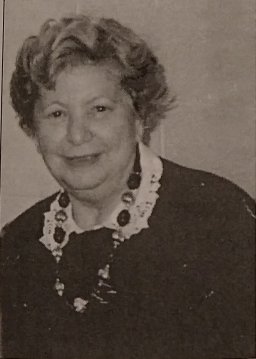
Maria Rosenbloom.

Nunek Nejder , Maria's husband, killed in Kolomyya at the age of twenty
five. Maria received this picture from her brother-in-law, Celek when she
visited Poland in 1991.
p. 106
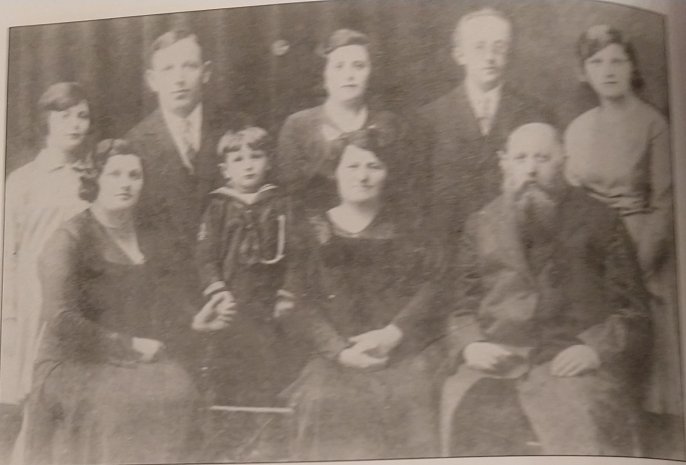
Professor Maria Rosenbloom's family and in-laws. Maria is on the far
left. On the right is her sister, Frania, (both sisters were saved with the help
of forged papers). The child at the center is Menek Goldstein who was also
saved. The rest of the family members on this picture were exterminated at
Belzec. The picture was taken in the 1930s.

The corner house on Legeonov and Walova Streets on the border of the
ghetto. In the cellar of this house Maria Rosenbloom and Menek Goldstein hid
during one of the aktions.
p. 107
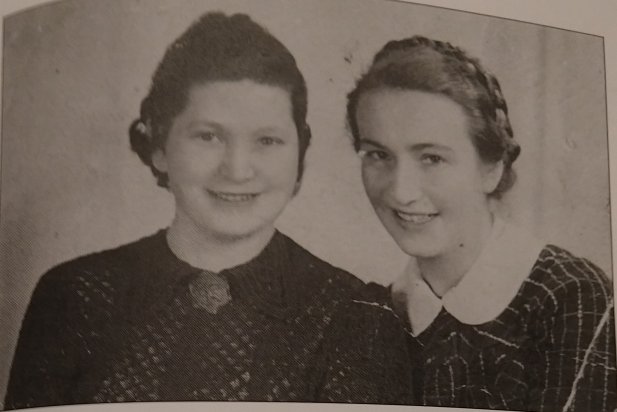
Maria Rosenbloom Blanca Rosenberg
Professor Blanca Rosenberg, z'l
In memory of Prof. Blanca Rosenberg, survivor of the Holocaust from Kolomyya, who, together with her friend, Prof. Maria Rosenbloom survived miraculously the period of the Nazi conquest of Kolomyya. Professor Blanca Rosenberg died just before Rosh Hashana 5759/1998, in her home in New York, leaving twin sons. She came to the United States with her husband, Dr Rosenberg in 1947 from Austria and rebuilt their lives after the Holocaust. Dr Rosenberg began to work as the Director of a small hospital next to Virginia and Blanca continued her studies to gain her doctorate in Sociology. She worked in the School of Sociology at the University of New York until she retired.
In her book To Tell At Last, 1941-1945, she relates her difficult experiences during the period of the Kolomyya ghetto and what she saw when the Nazis entered Kolomyya in June 1941. Together with her friend Maria Rosenbloom they escaped from the ghetto, and from Levov to Warsaw, where they lived using false papers.
Her book is surely a great contribution to the history of the Jews of Poland who suffered in the Holocaust and certainly contradicts those would deny the Holocaust.
Two years ago she came to Israel in order to be interviewed for the film on the period of the holocaust in Kolomyya. Her reports of the horrors that were perpetrated by the Nazis in Kolomyya and the surrounding areas are truly moving.
p. 108
Professor Blanca Rosenberg, z'l
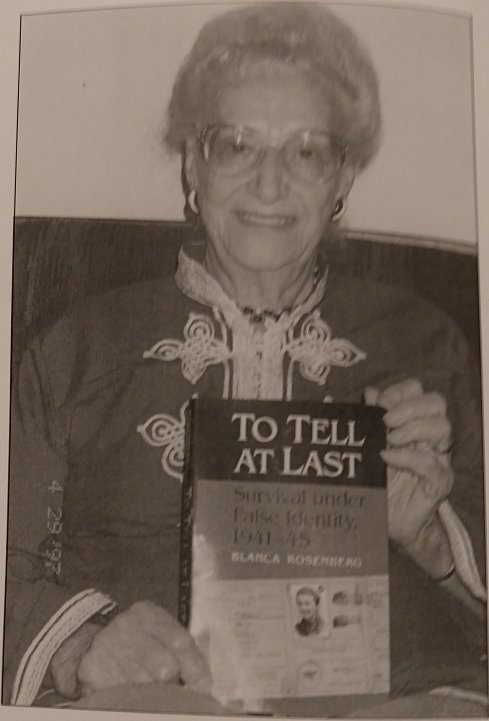
This photograph of Professor Blanca Rosenberg z'l was taken during her
visitto Israel in 1997 in the course of the filmed
interview with her for the film The Jews of Kolomyya during the
Holocaust. When Blanca arrived in the USA in 1946 she wrote a book about her
experiences during the Holocaust. The book was published in English and in
German. It was called ToTell at Last.
p. 109
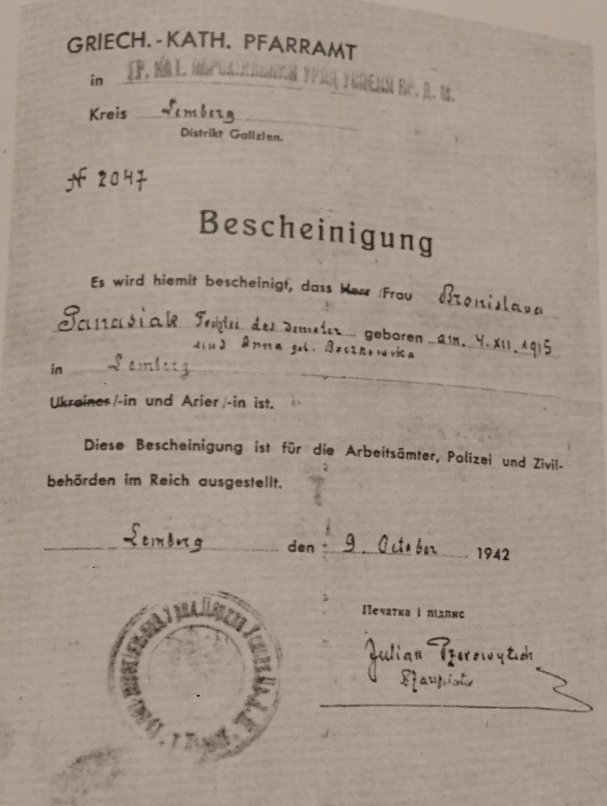
This birth certificate—used as a racial identification
document—was given to me by Lydia. She got it from her brother, a priest.
It was the real birth certificate of a Polish woman, Bronislava Panasiak, who
had died in Siberia. Note that she was identified as "Arierin"—an Aryan.
In deep sorrow we mourn the death of Blanca Rosenberg. It is truly sad that she did not live to see the finished film and book that she had so looked forward to so much. May she rest in peace.
p. 110
From the back of Professor Rosenberg's book:
To Tell at Last
Survival under False Identity,
1941-45
by
Blanca Rosenberg
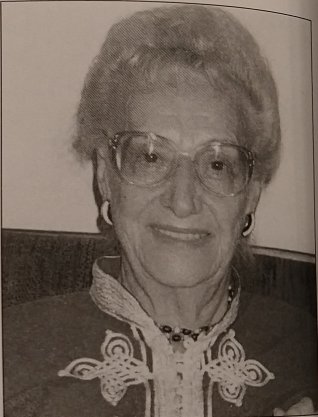 About the book: Blanca Rosenberg was a young wife and mother who escaped the
brutality of the ghetto in Kolomyya, Poland, after her entire immediate family
was killed. Though equipped with Aryan false identity papers, she found life
marked by daily threats and the danger of discovery by the Gestapo, Polish
police, extortionists, collaborators, hoodlums, and even former colleagues and
acquaintances. Rosenberg‘s wartime trek took her to
Polish cities, German military hospitals, and finally to Heidelberg, Germany,
where she worked as a maid in a Nazi household from 1944 until her liberation
by American forces. Her story is also a testimony to the power of friendship.
Brought together in the ghetto, she and her friend Maria continued to support
each other in their ensuing struggle for survival.
About the book: Blanca Rosenberg was a young wife and mother who escaped the
brutality of the ghetto in Kolomyya, Poland, after her entire immediate family
was killed. Though equipped with Aryan false identity papers, she found life
marked by daily threats and the danger of discovery by the Gestapo, Polish
police, extortionists, collaborators, hoodlums, and even former colleagues and
acquaintances. Rosenberg‘s wartime trek took her to
Polish cities, German military hospitals, and finally to Heidelberg, Germany,
where she worked as a maid in a Nazi household from 1944 until her liberation
by American forces. Her story is also a testimony to the power of friendship.
Brought together in the ghetto, she and her friend Maria continued to support
each other in their ensuing struggle for survival.
"A tensely compelling narrative of life - the height of personal danger." This is a story of a friendship between two Jewish women, which overcame the threat of Nazi genocide. This is one of the finest, most authentically dramatic and richly detailed memoirs written by a survivor of the Nazi Holocaust."
Alan Adelson, Exeecutive Director, the
Jewish
Heritage Project, producer/director of "Lodz
Ghetto".
BLANCA ROSENBERG is a retired associated professor of social work at Columbia University and is in private practice as a psychotherapist in New York City. Publication of this book was supported in part by a grant from the Jacob and Clara Egit Foundation for Holocaust and Jewish Resistance Literature, Toronto, Canada, through the Histadrut Assistance Fund.
p. 111
An extract from Professor Blanca Rosenberg's book:
To Tell at Last
The day was September 7,1942. By early morning the street in front of the Judenrat was crowded. Soon it had swelled to a thousand people, milling at the periphery, pushing and pulling at the center, trying to find friends and family. There must have been several hundred mothers tightly holding the hands of their children, each taking pains to look presentable. Mothers pulled at shirttails, straightened out dresses, pasted down cowlicks, all in hopes that their children might survive by looking cute. I heard more than one mother urge her children to smile and be cheerful.
As I stood at the edge of the crowd, my eyes sought out familiar faces. Instead I saw only ghosts. Before me stood a young woman, all skin and bones, grooming herself as she held a pocket mirror to her face and rubbed a bit of red paper on her cheek. The dress she wore to look her best made me turn my head away. Next to her stood a mother trying to calm a five-year-old boy. The boy was sobbing. "Please, Mommy, let's go back to our cellar and hide with Grandma. I don‘t want to go to the Germans." The mother could only reply: "Behave. When Daddy comes back from the war, he'll bring you a fine toy." Toward 7:30 in the morning, the members of the Judenrat appeared and the noise of the crowd subsided. The counselors were evidently agitated. One came forward to speak.
"Where are the elderly? Why didn't they come? If they're hiding it will go badly for them, and for the rest of us too. The Germans will be furious. They promised no one would be harmed. It's just a registration. Why can't you people follow orders? Why do you make our work so difficult? We're here to help, but you won't let us."
This complaint was met with silence and derision. So the Judenrat sent out the Jewish Auxiliary Police to find the missing one thousand or so that had to be in the ghetto somewhere. As tension rose, some in the crowd began to slip away, seeking their shelters after all.
At 8:00, we heard the order to line up and march out. Quietly, people began to file out, heading for the soccer field behind the ghetto walls. There, they were met by a handful of SS officers and a squad of Ukrainian militia. War-priority workers formed up in their own special group. They appeared relaxed and self-assured, as though they were untouchable. Others came to a halt in the middle of the field, eyeing them enviously. The silence was broken only by the occasional cry of a small child.
After all were assembled, Leideritz, the chief of the Kolomyya Gestapo, stepped forward. Dressed in full Gestapo regalia, with riding boots and white gloves, he motioned to a Ukrainian guard to bring the first group of Jews forward. This first group was composed of workers from the lumber mill. Leideritz motioned them all to his right. Everyone breathed easier. Next came the brick factory workers. Again Leideritz scanned the list. As he did so, his face grew red. Then he threw the list to the ground, pulled off his white gloves, and began to shout.
"Schweinehunden, who do you think you're dealing with? You can't pass off these broken-down old men as war-priority." He picked up the list and tore it into pieces. "I will make the selection." He began to move along the line, picking out the youngest and healthiest among the brick workers, sending them p. 112 to the right. The rest were moved to the left by the gun butts and truncheons of the Ukrainian guards.
And so it went with group after group. By the time Leideritz had sent two thousand or more to the left, there were no illusions about what each side meant. Cries and screams filled the air as men and women were consigned to their fates, separated from one another, from children and parents. Those who begged for mercy received blows from the Ukrainians.
A mother sent to the right attempted to smuggle herself back to the left to be with her child. One of the SS officers noticed her weaving through the crowds toward the crying child. He marched into the throng, picked the child up by an arm, and carried him toward a wall. As he reached a point a meter or two from the wall he picked up the little boy, spun him over his head, and threw him at the concrete. We should see the child's brains splatter as he fell to the ground. The German turned, a leer on his face, and joined the laughter of his comrades.
I turned from this scene to see one of the Ukrainians approach Leideritz and whisper in his ear. The commander nodded. Suddenly the selection was stopped. The SS officers took seats, and the Ukrainians fanned out among the crowd, singling out mothers and children.
A bit of chalk was found and bull‘s eye circles drawn on the concrete wall. At the SS commander's order, the Ukrainians tore children from their mothers and carried them to their targets. And then the militiamen began target practice. At this, a hundred men broke from the crowd and set upon the militiamen. But after a few moments of firing, their bodies were added to those of the children.
I could not bring myself to believe what I had witnessed. My child had been incomparably luckier; he had died in his grandmother's arms, or so I hoped.
Near me, a young girl I knew, Joasia Singer, began attacking one of the Ukrainians, biting and kicking. "Murderer," she shrieked. "You will die a thousand deaths." The guard pinned her hands and began dragging her away from the crowd, all the while beating her with his truncheon. As she lost consciousness she was still struggling. Then another guard came over and poured water on her face so that she might revive to feel more blows. But it was too late. She had died, resisting.
When the shooting was over, many were still prostrate on the ground. The registration resumed. The next group was the wives and children of the Jewish Auxiliary Police. They seemed to sleek and healthy we could hardly look at them. We all knew that their good fortune had been bought with blood. When they formed up before Leideritz, however, a remarkable thing happened; they were all sent to the left, to death. The Jewish police members could hardly contain themselves. One stepped forward to protest: "There must be some error. These are our women and children."
Leideritz interrupted him. "Shut up. Get back to your place." No one felt any sorrow for our Jewish guards as their spirits crumpled before our eyes. As the guards stood among the saved, on the right, the others shrank from them as from lepers.
Across the field there was another small disturbance. A pharmacist had managed to cheat the Nazis by swallowing a cyanide pill. As he lay dying, others ran through his pockets hoping to find another pill. Then it was our factory's turn. A thousand men, women, and children moved forward.
Blanca Rosenberg, To Tell at Last, University of Illinois Press, Chicago, 1993, pp.62-4
p. 113
An interview with Professor Blanca Rosenberg
Ariah Suchman, a native of Kolomyya from the surviving remnant, producer of the documentary film commemorating the Jews of Kolomyya, interviewed 80-year-old, Blanca Rosenberg from the United States, during her visit to Israel in July 1997, about her experiences in the Kolomyya Ghetto, about her life on the "the Aryan side" with a borrowed identity, in Warsaw, and after that in Germany, in the city of Heidelberg, where she worked as a housemaid.
The interview was held in English. Yaakov Reicher, a native of Kolomyya, and himself a Holocaust survivor translated the interview into Hebrew.
Ariah: Welcome to Israel, Ms Blanca Rosenberg. What motivated you to write a book about your memories of the Holocaust period?
Blanca: I thank you, Ariah , for welcoming me to Israel. I shall talk to you willingly today, fifty-five years since I left your town of Kolomyya, your town, although I wasn't born in Kolomyya nor did I grow up there.
After marrying, I went to live in Kolomyya for a short time. That was from 1938 to 1942, when I fled from the ghetto after I had lost all my family and my little child. It was a very, very tragic time. After four years of war, I began a new life. I remarried and we had two sons whilst we were living in Salzburg, Austria.
I came to the United States in 1947, and it was very hard for me to begin a new life. The great tragedy that I had undergone pursued me, and people did not wish to hear about what I had been through during the Holocaust. They said: you have survived. You are lucky, and so be happy and begin afresh. It was easy for someone to tell me to start afresh, but at that time my dreams of the atrocities pursued me at nights and they were inside me. For two years after arriving in America I was in a deep depression, and I didn't have the strength to detach myself from the tragic past. Therefore, in order to start afresh, I decided to sit shiva (the traditional seven-day mourning period) for all those I had lost, for my parents, for my brother, for my little child and for many relatives.
At that time I wasn't living in New York but in a small town in West Virginia, where my husband was working as a doctor in a small hospital for mental patients. We lived in a small house opposite the hospital and I sat and watched the hospital and the patients who had lost touch with reality. I identified with them. I thought to myself that like that I had to break the ring encircling me. However, I reflected, I am stronger than they are, because I can write. I have paper and pencil and I am able to sit down and write. Thus I decided to write my memoirs. This was not writing with the aim to publish, it was not for glory over my defeat of the Satan. It was, as I have told you, like sitting Shiva for my murdered people, and in this manner, symbolically, I could bring all my family members back to life in my imagination and weep tears over their graves, and only after I had brought them back 'for burial' was I able gradually p. 114 to detach myself from the tragic past, and I began to be a mother, a married woman and to function like a normal person. And so I began to write my memoirs.
When I had finished writing, I put the book aside and when I told people about this they asked me: How can you, after all you have gone through, resume living a normal life? My answer was: it's normal for you, for me it is life within suffering and also everyone of us Holocaust survivors, we live in suffering, with the suffering and in spite of the suffering.
At that time I didn't think of publishing my memoirs. Only after I returned to New York, to Columbia University, I continued my studies and became a lecturer at the university. When I retired, after more than ten years as a lecturer, I began to think about publishing my memoirs, because my two sons, who had grown up in the meantime, urged me to publish. In 1993, my memoirs were published with the help of the University of Illinois. The book was translated into German by Surkampf in Frankfurt-am-Main.
Ariah: Blanca, what is the significance of your book of memoirs regarding the tragedy in the Kolomyya Ghetto for our youth and the future generations?
Blanca: I think that it is very important to transmit the message to future generations. In recent years, after I went into retirement and stopped lecturing, I traveled throughout the United States and lectured on the Holocaust. I didn't ask for payment for my lectures, I felt a deep need to tell people the truth about what had happened, truth which will never be forgotten. You see Ariah , today in America and in the entire world and also in Germany, people don't want to open the Pandora's box. People want to get on with their lives and to forget what happened. In America, there are many people who say that in their opinion there never was a Holocaust, that this is an invention of the Jews and that we Jews are making a big tzimmes (a big fuss) out of nothing and that the six million who we lost never existed at all.
We must not agree to the continuation of this situation. For the rest of our lives and until our last breath, and we are no longer young, we must leave a message for the future generations and talk about what happened. It is very important that this should be done through the printed and spoken word. We must preserve the historical facts and this is a part of general history. It can happen again and it is the duty of the future generations to ensure that such a thing shall never recur.
Ariah: Blanca, on June 29 1941, the last soldier of the Soviet Army left Kolomyya. In the town there was no longer a Soviet regime. What do you remember? What did you see? How did the Ukrainians behave in the town, in the streets?
Blanca: I can answer the questions in two ways, one personal, that is tell you about what happened to me personally, or I can tell that what happened to me happened to many others in Kolomyya. I had a little four-month-old child. My husband was a doctor in the Russian hospital with a very important position, and was well known in the town. He was a Communist or supporter of the Communist regime. His father was a very religious Jew, named Abraham Rosenkrantz. The husband's family lived in Malinovka Street. My father-in-law, my mother-in-law, their son and daughter had already been abducted in one of the first aktions.
We lived at 7 Sobieskego Street in a house that belonged to Mr. Hacker who was one of the first victims p. 115 in the town. The whole family decided even before the Soviets left the town that my husband had to leave together with the Soviets because the Ukrainians knew about him and would kill him right away. It was very hard for me to part from him. The atmosphere in the town was very tense. Very many people wanted to leave with the Russians, but this was impossible. There were no trains, cars or carts. Everyone tried to flee as best as he could in order to save his life. I, with my four-month-old son, could not move. But I begged my husband to flee. He considered it. My heroic brother, Romik, who was four years younger than I, a young man, could have fled to save his life but he decided to remain with me. He gave his life for me.
Now for what happened in the town; the Ukrainians raised their heads. They hoped that an independent Ukraine would be established. They raised their national flag. In the first days, they went with the Germans and pointed out the houses of the wealthy Jews who lived in fine houses, because at that time there was no ghetto. We lived in a very fine house belonging to Mr. Hacker, who was the first victim in the town. Already, in the first days the Nazis had arrested 200 Jews whose houses the Ukrainians pointed out to them. They also came to my apartment. The Ukrainians said to them: This woman does in fact look Slavic, but she is a Jewish. Her husband was a doctor and he fled with the Soviets. Shoot her. I ran to my child's cradle, I took him in my arms and cried: "Now shoot us!" The German didn't shoot. He pushed the Ukrainian aside and fired one shot outside through the window. Thus I was saved.
Ariah: Blanca, when did the Hungarians come to Kolomyya?
Blanca: The Hungarians came immediately after the Russians left. A small band of SS also arrived in Kolomyya but the administration was in the hands of the Hungarian Army. The Hungarians also looked for fine apartments for their officers. For their commander, who was also the town governor, they chose the home of a Jewish doctor, Dr. Teicher, who the Nazis shot. He owned a fine two-storey house that looked like a palace.
One bright day the SS snatched about 200 Jews off the streets and led them outside the town to Korolovka. There, in a field, they ordered them to dig a great pit. Before they planned to shoot them they ordered them to sing and dance around the pit. When what was happening got out, the heads of the community came to Dr. Teicher's widow and told her about it. Mrs. Teicher, a very good looking and noble woman, went straight away before the Hungarian commander, who as I mentioned was living in her house, bent down before him on bended knees and pleaded with him to save the Jews. He at once gathered a band of officers and armed soldiers, drove with them to the field and arrived just as the Jews were dancing around the pit. The town governor ordered the SS to immediately stop their aktion and to release the Jews. Thus Mrs. Teicher saved the Jews on that day.
Ariah: Blanca, how long did the Hungarians remain in the town? Did they issue decrees against the Jews? When did the Nazis and the Gestapo arrive in Kolomyya and what were the first decrees and aktions?
Blanca: The Hungarian occupation was temporary. It lasted from July 3, 1941, till the end of July. At that time the Jews were ordered to work in forced labor units.
p. 116 At the beginning of August 1941, the town came under German control. A short time after their arrival, the Germans demanded that the Judenrat, which they had established, supply them immediately with a large sum of money, gold and jewelry. In order to ensure the rapid implementation of their demands they arrested 20 of the town notables, among them was Dr. Kohan. This was the first aktion, which we called the "intelligentsia aktion" and from which only a few returned home.
Ariah: Blanca, tell us about the Judenrat in Kolomyya and if the Nazis began with the aktions and executions immediately.
Blanca: Yes, immediately after they entered the town, the town governor asked the Ukrainians who the town notables were. On the basis of this, he appointed the Judenrat from a number of notables, who were mostly respected Zionist activits, among them Haim Ringelblum, a man of conscience, as chairman. Haim Ringelblum refused to accept the appointment and he was taken after that in the Mokra Aktion and shot in the Szeperowvce Forest together with all the others.
In his place the governor appointed Markus Horowitz as chairman. Straight away they demanded more and more money, they also demanded the Judenrat supply then with workers without payment for various jobs. They also demanded that they supply them with people in order to send them, so they said, to work in Germany. In fact, they were taken to concentration camps. Thus the Judenrat, which everyone hoped would help the Jews, turned into an instrument in the hands of the Gestapo for the implementation of their demands, and in the end it collaborated with the Gestapo. From sheer despair, people took their own lives, among them Mr Horowitz after they demanded that he hand over all the children to the Gestapo. Mr.Horowitz was a very wonderful man.
Ariah: Blanca, tell us about the Jewish police in the ghetto. Who were they, what kind of people were they? Were there among them also educated young men or only simple people?
Blanca: They varied. They volunteered for the police in order, so they thought to save their own lives, to save their children, their wives and their families. This was unfortunately very tragic since this was done at the expense of the lives of the others.
Now allow me to tell you about the aktion, which we called "Die Moktra Aktion" named after the "Mokre" streets, which were streets where only Jews lived. The aktion took place even before the establishment of the ghetto in March 1942. An old woman lived there whose grandson was a Communist in the days of the Soviet rule and who had fled to Russia with them. The Ukrainians reported this to the Gestapo and said that he was in hiding. The Gestapo ordered the Judenrat to deliver the young mon to them within 24 hours. The fact of his flight was known. They came to the old woman and said to her: "Hand over the young man." The woman burst into tears: "What do you want from me? I don't know where he is. If you wish - take my life. I am happy to give my life for my grandson". And in fact, the Ukrainians shot her. That day they dragged 300 Jews from their homes in Mokre Street, led them to Szeperowce forest and there they were shot at the mouth of a pit.
Now the "Hoshana Raba" aktion. That was in October 1941, still before the ghetto was established. The Jews were not permitted to pray in synagogues. They asked the rabbi and he said: Pray in the shtibl (a p. 117 small one-room synagogue). And then the Ukrainians and the Gestapo fell upon the shtibl. They dragged the worshippers out of there, they brought them to the big synagogue and the Ukrainians set the synagogue on fire. The Jews went up in flames crying Shema Yisrael.
Ariah: Blanca, what happened after the establishment of the ghetto in March 1942?
Blanca: After the establishment of the ghetto, there was an aktion on Passover in April.
Ariah: Tell us about the terrible, tragic aktion, in which the Nazis killed babies.
Blanca: Yes, that was the aktion of September 7, 1942. This memory I shall take with me to the grave. This was the aktion they called the likvidatzia aktion (liquidation). The Nazis used a trick, since the people had heard about the aktion, and were hiding in bunkers they had built themselves or hid in other places. I can tell you story after story about people trying to save their souls and their children in bunkers, and how those who were already in the bunkers were afraid to allow small children into the bunkers since the children would cry and then the bunker would be discovered and the Nazis would kill them all. The Nazi stratagem was that they announced through the Judenrat that this would only be a "registratzia", that is to say registration of the people and their places of work.
Ariah: Blanca, tell us about one of the killers, whose name was Weisman. I believe he would stride about during the aktion with an axe in his hand, and would kill babies and little children with an axe, and also kill old people and sick people in their beds. Did you see such incidents?
Those specific incidents I didn't see. I can tell you about other killings that I saw with my own eyes, and one of them was in the poultry slaughterhouse before the big aktion in September 1942. On that same day I fled from the ghetto. My brother, who was working in a factory outside the ghetto, heard that on that same day there would be an aktion. I was living then in the ghetto at 1 Mizkewicza Street in a house that abutted on to the ghetto fence. My brother came from outside the ghetto and I handed him my child through the window and afterwards I jumped from the window across the fence to the Aryan side. My brother led us to the factory where he worked. It was a knitwear factory that belonged to Mr Horowitz in Kosciusko Street. Now a Ukrainian woman ran the factory. The factory manufactured knitwear for the German Army and was considered to be an essential plant. I stood by the window in one of the rooms. Suddenly, I saw a big group of people being led away by the Gestapo to the slaughterhouse. Among the group of women, children and old people, I saw my husband's mother and father. The father was supporting his wife. They were all pushed inside the slaughterhouse and the doors were closed after them. Suddenly I saw a boy of about 8 or 9 who climbed onto the roof of the slaughterhouse trying to save his life. Three Nazis who were standing outside aimed their rifles at the boy and amused themselves to see who would be the first to hit the target. The boy was shot and his body rolled from the roof to the ground.
All the people who were inside the slaughterhouse were killed. The murderers called it "the Slaughterhouse Aktion."
Now I return to the aktion of September 7, 1942, which was my last experience in the ghetto, for after it I fled from the ghetto. At that time I lost my child, my parents, my relatives and Romik, my brave p. 118 brother, who had stayed by my side all that time. As I have already mentioned, the Nazis had announced that this would be an aktion only for the purposes of registration according to work places. "Nothing will happen to you, no one will be taken, only come and register", they announced. They concealed their real intentions: they demanded that all the factories that were managed by Catholics draw up a list of the workers most essential to them for the war effort. The Catholic managers had to give these lists to Leidritz, the head of the Gestapo. Leidritz stood in the field where the people reported for registration, and without glancing at the lists announced: all the men will go to the right, and the women and children to the left. At that moment it was clear to everyone that the right side was for life and the left side for death.
When it was th turn of the factory where I worked, Leidritz looked at us, took the list and tore it up. Our eyes grew dark: We weren't for life. And Leidritz screamed at our manageress: "You think you can protect these people when they are all invalids. I need people fit for work. Before sending the women to the left, he pointed at me and told me to go to the right side. I said to him: "I don't want to go to the right side, and I began to go to the left side, where my brother was, because I had no reason to continue living. At that moment Leidritz kicked me in the stomach and I fainted. From that moment I don't know what happened to me. It turned out that the husband of Maria Rosenblum the manageress, who was present, took me on his back and brought me to the school where there were about 300 people destined for life. That day 7000 people had assembled, 6700 of whom were taken to the train and sent to Belzec, the death camp. We, the 300, were kept in the school until 7 p.m., and afterwards they told us to return to the ghetto. We returned to the ghetto only to find it in flames. I sat on the ground at the entrance to the Judenrat building and sat shiva for all my dear ones.
The next morning Maria's husband came and took me to his house. After that, Maria, the manageress of the factory, called me to her and said: "Blanca, I promised your brother, that if anything happened to him, I would try to save you and I intend to do that".
I said to her: "Maria, you can help me only in one way. Bring me poison, because I don't want to live."
"I shan't do that," Maria answered, "I am very religious. I am a Catholic and I am not going to help you to commit suicide. I am going to help you save your life". The next day she brought me 'Aryan papers', and that same night her brother escorted me to the railway station, and I left Kolomyya under the borrowed identity of a Polish woman and traveled to Lvov on the Aryan side, to the sister of the woman who had provided me with the papers, according to the address which they had given me. And thus began my odyssey under an assumed identity. The people made me welcome but after two weeks they told me: "We are afraid to keep you with us". I had to leave their apartment and so I found myself in the street and with only 50 zloty in my pocket.
You have to know that any Catholic who harbored a Jew was in great danger. In the event of the Gestapo finding out, they were killed together with the Jew they had hidden. Even walking in the street involved great danger because there were gentiles who looked for Jews like me who had assumed identities. They called them Szmalcownik. They extorted money by blackmail or handed the unfortunate Jews over to p. 119 the Gestapo, who paid them 50 zloty for every Jew.
Luckily, I had a Jewish acquaintance from Kolomyya called Eli Rotman who was living in Lvov under a borrowed identity. He who was married to a German woman. His wife had helped him to escape from the ghetto earlier and arranged lodging for him in Lvov.
(Translator's note: the man's name was Eli Rotner, not Rotman. His German wife, Kaete Rastzat, worked in the years 1941-42 for the director of the bureau of the commissar of the Landwirschafstliche Centraalstelle (Economic Department) in Kolomyya, Herr Schultze. The bureau supervised the supply of agricultural produce to the German authorities. In December 1941, I was sent by the labor department of the Judenrat to work at the bureau as a slave laborer. Herr Schultze, a liberal German, not a Nazi, appointed me bookkeeper of the bureau. Thus I became friendly with Kita and even helped her in secret to pack food parcels that she sent to her husband, Eli, whom I did not know personally at the time. I met Eli Rotner in Warsaw after the liberation in March 1945, in the offices of the Jewish Committee at 44 Targowa Street in Prague where I was active. We got to know each other and from then on we remainded friends until the day of his death. I made contact with Kaete after the war and she was even a guest in our house for 10 days in 1982. She had meantime married again to a liberal German named Hertzig).
Eli Rotman helped me to find a place to sleep. But there too I could only stay for a few days, so I was again forced to flee. This time I fled to Warsaw. I arrived in Warsaw on the first day of the Ghetto revolt. The railway station was full of German and Polish police and Gestapo who were looking for Jews who had fled from the ghetto. A Polish policeman arrested me and my friend Maria Rosenbloom, who was also from Kolomyya, as we had fled to Warsaw together. He kept us for a night in one room in the Polish police station. During the whole night he interrogated us. He said that Maria was a Jewess. He didn't suspect me at all, because I looked like a Polish woman with my blue eyes and blonde hair. THe next day, the policeman was replaced by another policeman, who tested us on religious matters. We both knew the subject well because we had prepared ourselves thoroughly before our flight. The policeman wasn't satisfied with this. He asked us all kinds of questions: who we were, where we had come from, for what purpose had we come to Warsaw, and other questions. In the end he allowed us to go. After walking along several streets we noticed that that the policeman was following us. He caught up with us and said: "Girls, you certainly have nowhere to stay the night. I shall arrange a place for you." It turned out that he was a member of the Polish underground.
He said to us: "I know that you are Jewesses, and I want to help you to survive." And in fact, later on he came to our assistance a number of times. Maria was still hiding in some rented room and I reported to the Arbeitsamt (Labor Office) and they gave me a job as a housekeeper with a German civilian who had an accountancy office. After that I brought Maria over to me and arranged work for her to clean my boss's office.
p. 120 Ariah: Maria told me that the German with whom you worked asked you: "Kennst du strudel machen? (Do you know how to make strudel?) Tell me about it.
Blanca: Correct, once he asked me that question. He loved my cooking. Of course I answered him affirmatively. Afterwards he invited a number of his friends, all Nazis, to a party in his house and I made strudel. They were all delighted with the strudel and I received many compliments. After a few days he told me that he would take me to Germany, to his home in Heidelberg, where his family lived, his wife and his four children, in a villa with a big garden, so that I could run the household. And in fact, he did take me there. It was before the Polish uprising in Warsaw that broke out on August 1 1944. His wife was a very meticulous person and very wicket. She made me work from morning to evening. I scrubbed the floor, cooked, looked after the children and worked in the garden. She even followed me around to make sure that I didn't pick fruit for myself from the trees.
On April 1, the US Army entered Heidelberg without a battle. When I heard, I threw the scrubbing brush down and raced outside into the street to see the messiah in the form of the American soldiers on their tanks, who were liberating us. At that first moment, I was very happy, for this was the end of the war, but after some minutes I began to cry: What was so good about it? Where were my home, my little child, my parents and brother? Where were all the rest of my relatives?
I sat with my friend Maria (who at my request, my employer had transferred to Heidelberg to assist me with the housework) on the edge of the pavement and with tears in our eyes we gazed at the columns of tanks of the US Army passing before us. Suddenly one officer with a little beard jumped down from his tank and approached us. He saw tears in our eyes and addressed us in English. We didn't understand. We asked him: "Do you perhaps speak German?" "No," he answered. "Maybe French, Russian or Polish?" Suddenly a spark appeared in his eyes: "Oy Vay!" he burst out emotionally, "Do you speak Yiddish?" It turned out that he was the Rabbi of his unit. "You are the first Holocaust survivors that I have met!" he said with tears in his eyes. He made sure that we had a place to sleep, put us in touch with the director of UNRWA, a Canadian Jew, who arranged work for us with the Joint in Frankfurt-am-Main. And so we gradually began a new life after the war.
Ariah: Blanca, I thank you very much for your informative story about what happened to you in the Holocaust period. I wish you all the best, good health and long life. Good-bye and au revoir, Blanca.
p. 121
Chedva Kaufman
The 'Janusz Korczak' of Kolomyya during the
Nazi Occupation
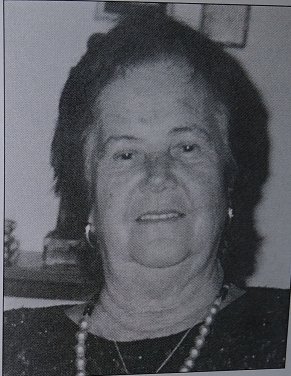
A picture of Hedva Kaufmann taken while filming her interview for the
film on Kolomyya.
When the Nazis entered Kolomyya in July 1941, Chedva was given the nickname 'the Kolomyya Korczak'. How did it come to pass that Chedva became the director of an orphanage without any formal preparation and without her agreement to such an undertaking at the time when the entire Jewish community was about to be destroyed?
When the ghetto was established in Kolomyya, Chedva was a young woman, married only a short while and without children. The Jews were being brutalized daily by the Nazis - aktions, murders, banishment of thousands of Jews to the death camp Belzec; tens of children who had succeeded in escaping the aktions wandered about the street. They had become orphans, without homes, and without any one to care for them. They were neglected, hungry; they crowded together, barefoot, wearing rags, sick and crying over their bitter fate. It was during this time that Chedva and her friend Lily Kris, who, until the outbreak of the war had been a medical student in Paris and had returned home to Kolomyya for a short holiday just prior to the Nazi invasion of Poland, were walking the streets when they saw the terrible suffering and were overcome with pity and compassion. They decided to take action. They decided on the spot that each of them would take home temporarily a number of children in order to save them from hunger, disease and death. Everyday more and more children would come to the home until it was impossible to accommodate them all. They turned to Mr. Motti Horowitz, head of the Judenrat in Kolomyya and reported the grave situation the children were in: he gave them a place to house the children, over twenty of them, and supplied food and medical attention. This is how Chedva became the director of the orphanage with her assistant, Lily Kreis.
The orphanage was in one of the abandoned houses in the second ghetto on Krashovski Street. There the children received the dedicated attention of Chedva and Lily and their helpers. As the destruction of the ghetto advanced, the orphanage filled to capacity and Chedva needed another home to care for the sick children who survived the latest aktions. The Judenrat gave her another house, and, until the final destruction of the ghetto, approximately 160 children were cared for in these homes. Chedva and Lily cared for them devotedly together with the Jewish doctors who worked with her on the orders of the Judenrat.
p. 122 One morning, on his own initiative, a Jewish policeman, a loyal and compassionate man, arrived at the orphanage to warn Chedva that the next morning the Nazis planned to come and kill the children, and begged her to hide the smaller children, and urged that the bigger ones, between the ages of 10-12, should escape over the walls in the night and seek refuge with the non-Jews. Chedva decided to act immediately but what could she do with 40 babies who were lying weak and sick in their beds. Her heart sank with the notion as to what their fate would be. The following morning two Gestapo men arrived at the orphanage and ordered her to prepare groups of children, dressed and who were able to work for half-an-hour to the prison. She was to accompany them. Those who were unable to walk were to be left behind in the orphanage. Deeply troubled as to the fate of the children, she had no choice but to carry out the commands of the Germans. The children were dressed nicely, the girls with bows in their hair, and the march began as if the children were going on a pleasure outing to the city. They were accompanied by Ukrainian and Nazi policemen with Chedva heading the march - just like Janusz Korczak, who lead his children to the train station. When they arrived at the prison, the children were separated from Chedva, who stood by helplessly with tears in her eyes dreading their terrible fate. "You can return to your orphanage with police escort", the Gestapo officer told her. She was now filled with dread about the fate of the 40 sick babies who had remained in their beds.
On her way to the orphanage, there was no way that she could have imagined the immensity of the Nazi brutality and sadism that awaited her there. As she approached the orphanage, she ran from the guards to the stairs at the entrance of the corridor, and there before her eyes was the most apalling sight; a river of blood flowed down the stairs from the second floor, the blood of babies who had been shot in their mouths by the Nazis. Chedva fainted in the face of this horror - children strewn across their beds in the pools of blood their mouths wide open! She was taken to the Jewish hospital, where, after great efforts, she was revived. Who on earth can comprehend the terrible sorrow that filled her heart in the face of this horrendous massacre of the babies - may God revenge them.
Chedva and her husband's story did not end with the destruction of the orphanage and the ghetto. Her father had maintained good relations with non-Jewish traders and industrialists before the war, and he also had ties with Ukrainians from the Carpathian Mountains. Two days before the ghetto was razed to the ground, Chedva and her husband fled to the house of a Righeous Gentile, a local German (Volksdeutsch) who helped them escape to the Hungarian border, accompanied by a Huzoli smuggler. But the journey through the cold and snowy Carpathian Mountains was hard and Chedva collapsed in exhaustion. She tried to kill herself by slashing her wrists. The smuggler saw what had happened and he saved her by binding her wrists with rags. Further along the way, most unfortunately, they were caught by the border police and handed over to the local Gestapo. However, she and her husband had forged papers with Polish names. Their appearance also worked to their advantage. Wisely, under investigation, they did not reveal that they were from Kolomyya, but claimed that they were from Stanislav. Eventually they were sent to Stanislav where they were imprisoned with some Poles. Three months later they were transferrd to Maidanek, where millions of people were being killed in the gas p. 123 chambers. Despite extreme pressures they maintained their Polish identity in Maidanek.
In her booklet "Field No. 5", Chedva describes the horrors that she and her husband experienced in Maidanek. In the autumn of 1944, the Soviet army freed the inmates of Maidanik and Chedva and her husband crawled out of the darkness into the light.
The Blessed Lord bestowed upon Chedva and her husband the opportunity of helping and caring for the children of the ghetto and the orphanage of Kolomyya. Dedicated and devoted as she was she gave everything she could to the children, but she was unable to save them from the clutches of death. To this day, Chedva carries with her the memories of the horrors that befell our nation during the Holocaust especially in Kolomyya.
Chedva, her husband, Lily Kris and their helpers will be remembered forever for their good deeds.
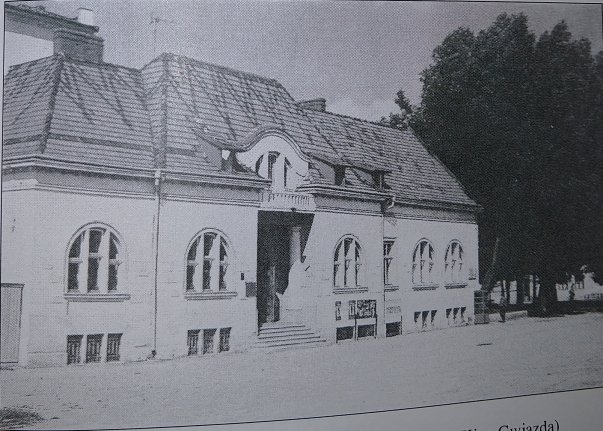
Hedva Kaufmann's husband's cinema in Kolomyya (Kino Gwjazda)
p. 124

The scene of Hedva Kaufman's anguished escape route across the Hungarian
border, which she took after the liquidation of the Ghetto in January 1943. The
Tcharnohora Mountain (the Black Mountain) is part of the Carpathian Mountain
range and is on the border between eastern Galicia and Hungary.

The snow-covered Carpathian Mountains. It was here Hedva attempted to
take her life by cutting her veins, no longer having the strength to continue
wading through the deep snow, as she climbed the mountains on the way to the
Hungarian border.
p. 125

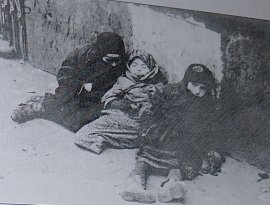

Some of the children who wandered through the streets of the Ghetto after
the aktions remained without parents, hungry, sick and in ragged
clothing. Hedva in her compassion took them into her home and cared for
them like a real mother, even before she established the orphanage with
the assistance of the Judenrat.
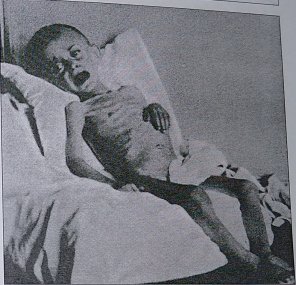
Forty children, like this boy, were shot in the mouth by the Nazis when
they liquidated them.
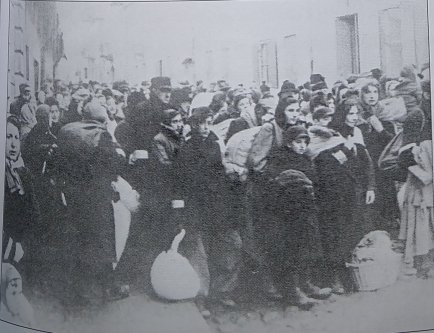
The last aktion that wiped out the ghetto.
p. 126
Testimony of a Holocaust survivor
Mr Yaakov Zinger
from Kolomyya - 1960.

Yaakov Zinger, z'l
The late Mr Zinger was chairman of the Organization of Ex-Kolomyyans in Israel in the 1950's. We call him 'the hero of the death train' which took thousands of Jews from Kolomyya and its environs to the death camps in Belsec. Mr Yaakov Zinger was a short, courageous, decisive man who was not afraid to take risks. On two occasions he decided to jump from the death train and return to the ghetto to remain with his wife and only son. He successfully hid during all the last aktions with a Polish gentile, one of the Righteous Gentiles in Kolomyya, until the Russian army entered on 27 March, 1944. One can say that Yaakov Zinger was sentence to life and not to death.
As an adult, Mr Yaakov Zinger was a married man with a family living in Kolomyya. He ran a business for clothing materials and owned a factory of knitwear. When the Russians entered Kolomyya in 1939, they boycotted the factory and busines. When the Nazis entered Kolomyya in July 1941, he was forced to work for them. He worked in the factory for materials that was run by a Ukrainian by the name of Winsol, but because of his expertise, he was promoted to labor manager. Three hundred Jews worked in the factory making sweaters, women's hats and handbags, and slippers for the Germans.
While working in the factory Zinger became acquainted with the top Nazis who came to the factory to order supplied. He met the heads of the Gestapo, Leiseritz, Hertel, Kleinbauer, Frost, Weisman, Kanakendaffer and Gaiah.
In 1942, there were between 30,000 to 80,000 Jews in the ghetto in Kolomyya, about a quarter of them from the surrounding towns. Outside the ghetto, only 2,000 of them remained alive having managed to escape and hide. Later most of the Jews were killed in the Shoporovtza Forest next to Kolomyya, or in the Jewish cemeteries, or they were burnt alive in the ghetto, where they had hidden in basements or attics, and thousands of others were shot in the ghetto streets during the cruel aktions that took place in the city.
As far as I can remember, from July 1941 to January 1943, about 17 cruel aktions against the Jews took place in Kolomyya, with the Gestapo, Krepo (crime division of the police) and Schupo (the local police) and Ukrainian militia participating in them.
I especially remember seeing from my apartment on Slovski Street at the edge of the ghetto, Weisman, a Krepo man, who was always around during the aktions, with an axe. From the Aryan side I saw the p. 127 aktion of Pesach 1942, an especially cruel aktion. I hid with my wife and son in the attic of my home, and during the aktion we looked out onto the ghetto through a slate that I had removed from the roof. I saw how the Nazis blocked the roads in the ghetto and began to burn the houses populated by people with phosphorous bombs. The Jews who tried to escape from the fire were forced back into the burning buildings.
A few hundred people were shot or burnt to death in this aktion. Some 5,000 Jews were led to the train station and forced under extremely cramped conditions into carriages that took in between 150-200 people, some of them choking to death even before the train left the station on its way to the gas chambers of the Klesiatz camp. I saw that criminal Weisman who walked around with the axe. He saw an old Jew sitting in the yard of his home. The man was exhausted and unable to walk to the train station. Weisman approached him and killed him with the axe.
In the winter of 1942, I happened to be at my cousin's, Yaakov Avush's apartment in the ghetto. He lived there with his sister, Heniah. Unexpectedly, Weisman, the nazi criminal walked in, and asked my cousins if they had butter. Whilst my cousin was answering in the negative, I managed to escape from the apartment, and hide in a neighbor's apartment. Suddenly I heard three shots. I peeped out and saw Weisman walking out putting his gun into its holster. Startled, I returned to my cousins apartment. They were all lying on the floor, dead, in pools of blood. I fled from the place.
The Aktion of September 7, 1942, the Registrazia aktion
This aktion was one of deception. Under the pretense of registration for work, the Germans intended to assemble 8,000 Jews at the Umschlagplatz to be sent to the death camp, Belzec. On the day, 1,000 Jews were shot in the ghetto and 7,000 were taken to the railroad station. I was amongst those. Before the registration I had managed to hide my wife and 4-year old son. I, myself, was caught and taken, despite the fact that I had a permit of 'an essential worker for Germany'. I was forced into a carriage with another 120 people, crushed together. It was not surprising that something like 15 of them, men, women and children, died of suffocation almost immediately, a long time before arriving at the death camp.
Despite the many guards on the train, and the barbed wire on the small window, I managed to climb through the window and escape almost unhurt. I began to walk in the direction of Kolomyya following the railroad lines all the time worrying about what would happen to me if I were caught. On the way, I met my neighbor, Mrs. Kirschenberg. She, too, had jumped from the train but she had lost an eye. We walked all night along the tracks. At dawn we arrived at the Jewish cemetery and decided to hide there until it was light.
In the morning the gravediggers arrived with bodies of those who had died the previous day. I pulled off a shirt from one of the bodies and tore it into rages so that I could dress Mrs. Kirschenberg's eye. The gravediggers and I also removed a coat from one of the bodies for her. She and I were without coats because during the aktion the Germans took our coats from us with our documents and money. We returned to the ghetto in the back of the gravediggers' truck under the canvas.
p. 128
As we approached the ghetto, I walked alongside the truck, which was moving slowly, and Mrs. Kirschenberg prepared to leave and go to her apartment. Two Nazis criminals approached us, Weisman and Prost. Weisman stopped and asked Mrs. Kirschenberg why she had a bandage over her eye. I was unable to hear her reply as she spoke very softly. Weisman ordered her to go down on her knees, took out his revolver and shot her in the back of her head.
Before the war, there was a poultry slaughter house in Kolomyya. It stood at the center of the town, not far from the market place, next to Synagogue Street On one occasion, the Nazi murderers, Weisman and Gaiah decided to murder 105 women in the slaughterhouse. I heard that one morning, Weisman and Gaiah turned up at the Judenrat and demanded that 105 women and children be handed over to them. Panic struck the ghetto. Women and children were forcefully removed from their homes in order to make up the quota the Nazis demanded. The Nazis threatened to burn down the whole ghetto if the women and children were not handed over. From the window of the factory where I worked I saw Weisman and Gaiah leave the ghetto very pleased with themselves. After work, I went to my sister, Regina Kriss in the ghetto, but she and her two children were not there. From the neighbors I heard that they had been taken to the slaughterhouse and had been shot by Weisman. From the evidence of the Jewish police, who were there, I learnt that there were more than 130 women but the murderers had only 105 bullets, and thus sent the rest of the women back.
Concerning other atrocities of the Schupo (local police) I have already given evidence.
p. 129

The Shauber House on Slowaski Street, 30 metres from the author's home.

The Zimund Bath House. Behind this house stood a small house in which
Yaakov Zinger, his wife and son, found refuge with a righteous Pole. After the
liquidation of Ghetto No.3, they hid there for 17
months under very difficult conditions until they were liberated by the Soviet
Army on 28.3.1944.
p. 130
The establishment of the Ghetto
The three ghettos were established in Kolomyya in March 1942 by the Nazi criminal, SS Officer Peter Klaus Folkman. The Judenrat was absolutely subject to the Nazi authorities and required to carry out its orders. At the head of the Nazi organization was the head of the Gestapo in Kolomyya who brought about the total destruction of the ghettos and the Jews of the environs. He declared the area Judenrein (Free of Jews) on 3.2.1943.
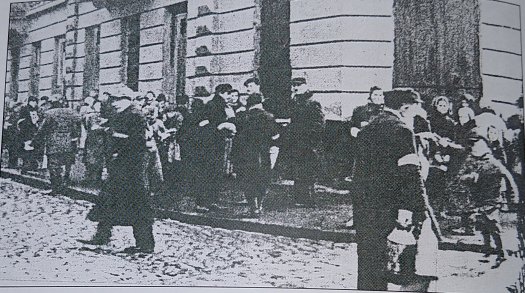
The establishment of the Ghettos of Kolomyya. (By courtesy of the Polish
Historical Archives)
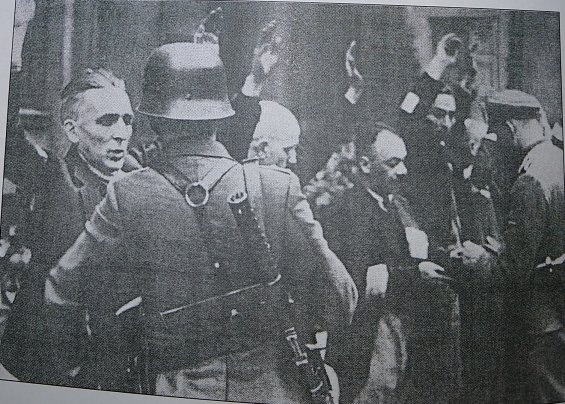
Slave-laborers searched on their return to the ghetto.
p. 131
Streets of the First Ghetto under the Nazi occupation, as they appear today in 2003.
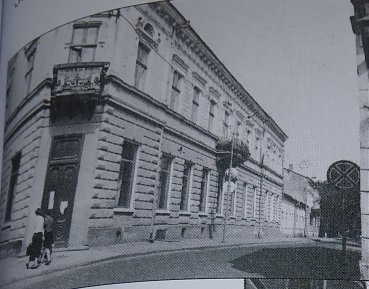
Walowa Street, presently under Ukrainian authority.
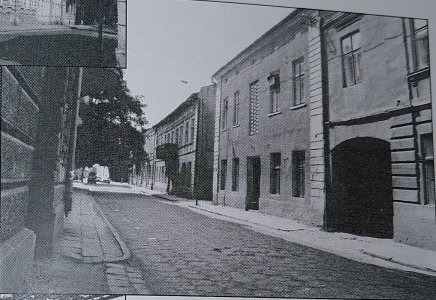
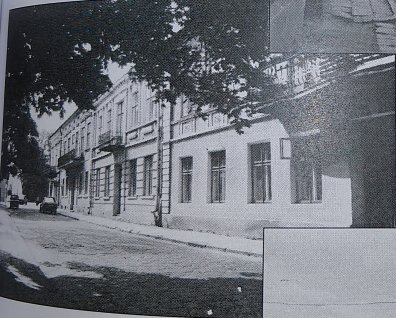
Walowa Street, unchanged since the ghetto days.

Today, a second-class hotel stands where the Great Synagogue stood, built
by the local authority.
p. 132

Bazira Street, opposite the Butchers' Market, (De Halas in Yiddish)

Bezira Street, corner of Pilsodski Street - part of the First Ghetto.
p. 133
The First Ghetto near where the market place once stood.
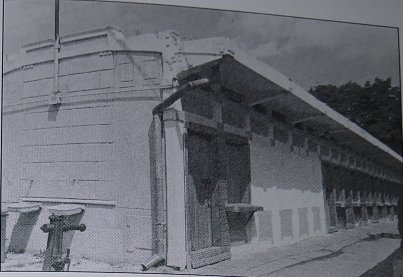
The Jewish butchers' market, Bazera Street, at the center of the town, opposite
Yeshayahu Likvornik's house.
The picture was taken in 1996. The place has not changed since before the
war.
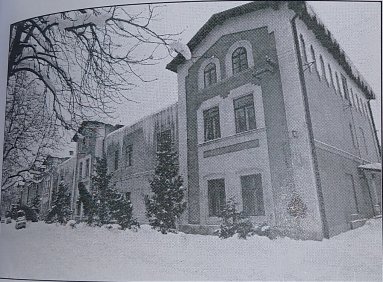
Aleja Wolnosci Street, to the right was the Umszlagspatz (assembly
point).
Thousands of Jews were concentrated here after the aktion for selection and then
sent to their death or to forced labor.
On this spot the local government
built a curtain factory.
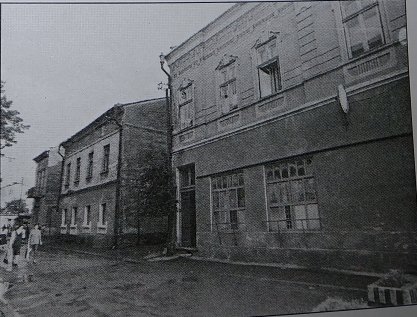
Bazera Street, the houses opposite Yeshayahu Likvornik's house
p. 134
The second ghetto — Mokre Street

Kamionka Street. At the end of the street stands the Kamionka Synagogue, which
survived the Holocaust.
p. 135
The third ghetto, Slowaski near the author's home.
The place has hardly changed since the outbreak of the Second World
War.
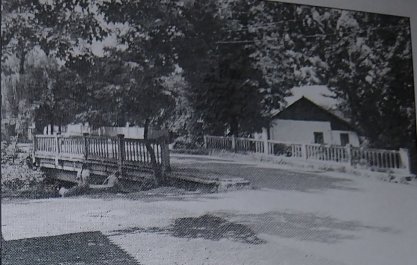
The small bridge across the Black River. In Yiddish it was called Dar
Pokik.

Dr. Neuberger's house and beyond it, Mr. Hammer's house
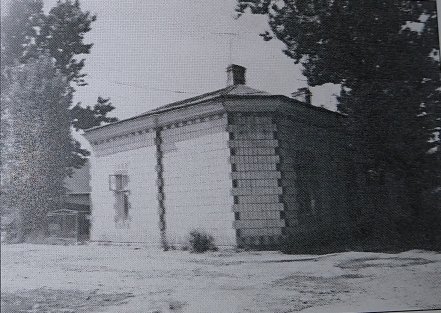
The Knol Pharmacists' house, opposite the author's home. Today the building
serves as a Driving School.

Slowzki Street, on the corner of Dzidoshitzki. The building on the other side of
the street was where the family Jurgenman's coffee shop stood.
p. 136
The Nazi apparatus that was responsible for carrying out the brutal aktions during the liquidation of three ghettos.

Schupo (Local Police) Commander.
Johann Gail, responsible for the
Nazi police in Kolomyya.

Schupo officers of the criminal Nazi organization responsible for the
aktions that took place in Kolomyya and for the systematic theft of all
their victims owned.
In the middle of the back row, with his arms crossed,
stands The Gestapo officer, Hertel, who oversaw the looting of all the
Jews of the Kolomyya ghettos.
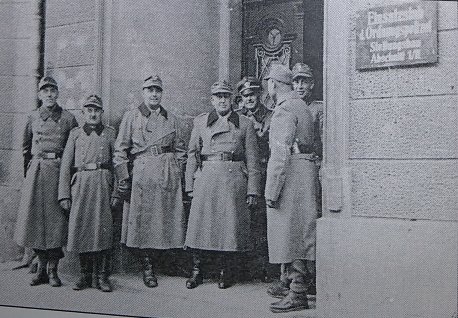
Schupo officers in Kolomyya standing at the entrance of their
headquarters in Railway Street. The building had served as the post office
before the war.
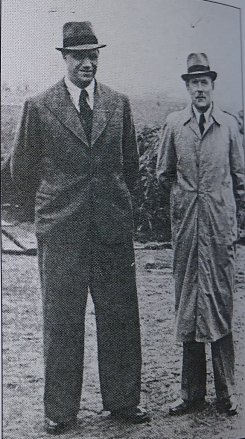
Two criminal Nazi detectives in civilian clothes would wander around the streets
in the ghetto looking for Jews who had assumed false identities. The one on the
left was a Nazi Schupo officer and the other a Ukrainian policeman.
p. 137

The Baron Hirsch School Building, Kolomyya, 1941. During the Nazi occupation it
served as the headquarters of the Judenrat until the ghettos were
destroyed. The building still stands today.
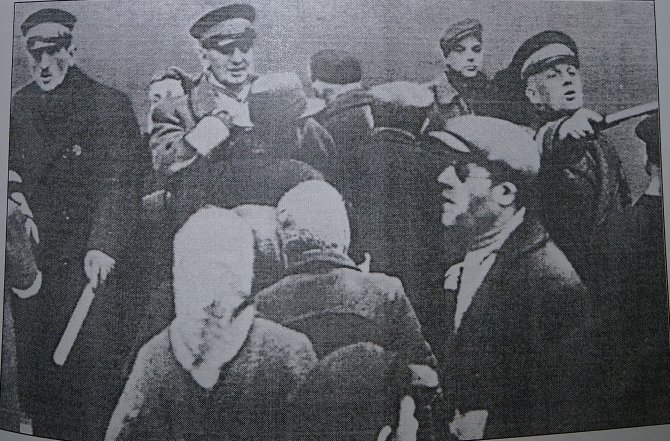
The Jewish police of the Judenrat. Jewish police units were established
in all the ghettos. Many of these police acted with great cruelty against their
brethren. By courtesy of the Polish Archive.
p. 138
Mordechai Horwitz,
Chairman of the Judenrat in Kolomyya
As has been mentioned, Mordechai Horwitz was appointed chairman of the Judenrat in September 1941, and remained at his post until the end of October 1942. Mr. Horwitz was one of those controversial characters. Testimonies about his behavior and relationship with the Germans on the one hand, and with the Jews on the other, have shed light on his attempts to endure the impossible situation he found himself in.
Mr. Horwitz was a descendant of an extremely rich family of rabbis. As the owner of a factory he behaved towards his workers with consideration and kindness. During the reign of the Soviets from 1939-1941 the workers protected him despite his "capitalism" and he was neither banished nor imprisoned and he was allowed to stay on at the factory as a worker.
Before the war he had refrained from public service despite the fact that he had been approached. After the first chairman of the Judenrat was taken in an aktion, Horwitz agreed to take over the position. From the day that he was appointed chairman, he dedicated all his time and thoughts to the task. He moved into the community building and ate his meals in the kitchen of the Judenrat. His possessions, he donated to the Judenrat fund.
On the second day of the Rosh Hashana holiday in 1941, Horwitz arrived at the synagogue and calmed the public by saying that nothing bad would happen.
In the fall of 1941, his wife was arrested. Horwitz did not appeal to the Germans to release her, despite the fact that in those days one could still secure releases through some kind of intervention and/or bribery. He explained his position thus: "If it is impossible to release other Jews, I do not want to be different and release my wife". Horwitz's wife never returned.
Horwitz often visited the Gestapo offices. At this stage he believed that by handing over possessions it would be possible to get through this period so he demanded the city's rich to hand over their possessions. His demands were cruel and more than once accompanied by abuse.
Another one of Horwitz's demands was forced labor. He believed that by fulfilling the Germans commands he would succeed in making the Jews "useful", and this would ensure them a safe passage through these terrible times. While the possessions of the rich were being taken from them, the poor of the city were doing hard labor.
With the worsening of the situation in Kolomyya, one could see a change in Horwitz. He began to imitate the behavior of his masters, acting cruelly. Most testimonies point out this change and emphasize his degradation. He used to beat people, imprison them and attack whoever came across his path. He used to walk around the streets of the ghetto observing the dying lying next to the dead, the distress and poverty of his people. Pain and hopelessness was everywhere.
p. 139 On 7 September 1942, the German Command ordered a public gathering. From the 8,000 people that assembled, only 1,600 remained as slave-workers. The others were taken to Belzec. Horwitz was at the assembly, he saw the selection taking place, watched how the Germans beat the elderly and the young, and watched people commit suicide. Hopelessness accompanied his people on their last road.
A month later another aktion took place. This time 4,000 people were assembled of which only 240 were given work permits. The following day one of the Gestapo commanders appeared and demanded that 106 elderly be handed over because they were charity cases. The people were collected by the police and brought to a slaughterhouse and shot. The Judenrat buried them, and Horwitz was amongst those that gathered the dead.
From 20 October 1942, the police gave an order to produce a daily quota of elderly and children. In order to fulfill this quota the police had a daily hunt. Horwitz was on hand and understood the demand. He understood that work places did not protect the workers. Horwitz sobered up as it were and understood the German system. He realized that he had nothing more of value that he could use in exchange to save the Jews from their fate. The only thing left to struggle for was some extra time. His dream of turning the ghetto into a work camp had not succeeded.
On 25 October 1942, Horwitz, together with his sister, took his life. Did he commit suicide because he realized what the Nazis plan was? Or did he realize that he had actually collaborated with the Nazis and and was a cog in the extermination wheel? Maybe he tried to rebel and express his rejection of this system? Maybe he had a nervous breakdown? Amongst the testimonies about Horwitz, there are those who mention his efforts for the Jewish police, on the other hand, there are those who criticize his behavior and outbursts. Undoubtedly, Horwitz could not stand up to the harsh realities that dictated his choices that meant the difference between life and death. In the words of A. Weiss: "The harsh tests he faced forced him to question his fate, his life".
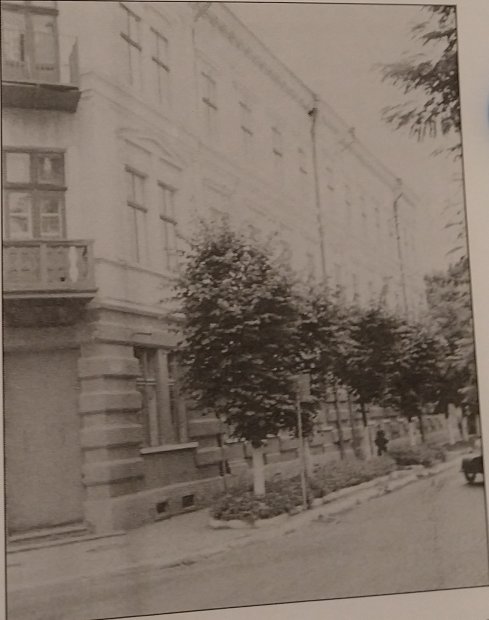
The curtain factory building that belonged to Mordechai (Moti) Horwitz
before the outbreak of the Second World War. Tens of Jewish girls earned their
living here.
p. 140
The Kolomyya Railroad Station
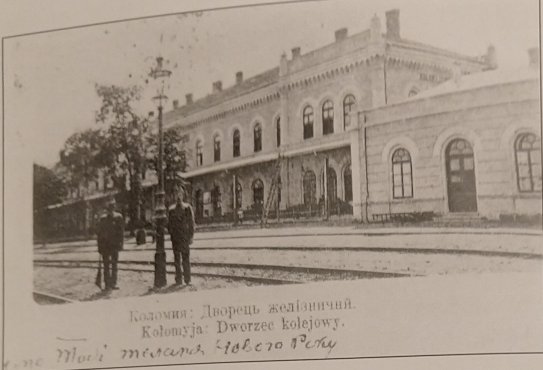
This was to the station to which the
Nazi's brought thousands of their victims and from here
they were transported to the death camp, Belzec

In the period of the Nazi occupation, thousands of Jews were forced into
freight cars and transported to the Belzec death camp.

The railway station in Kolomyya, photographed from the outside in 1994.
It was built a hundred years ago, and this is how it looks today under
Ukrainian rule.
p. 141
Avraham Taub - Hero of the Death Train
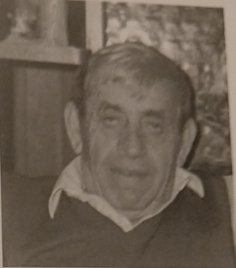
Avraham Taub, a Holocaust survivor from the Kolomyya Ghetto
In September 1941, when the Nazis entered Kolomyya, Avraham Taub was trapped in the ghetto with his parents and sister, and the rest of the Jews of the city. Avraham was a young boy of 14, still young enough to enjoy a cuddle in the arms of his parents.
Like other youngsters of his age, he did not understand the drastic changes that were taking place in the country, such as, the replacement of the Polish government following Poland's surrender in 1939. He was also unaware of the imminent danger they were to all face with the arrival of the Nazis in Kolomyya.
In this period Avraham was a strong and talented lad who looked like a typical Ukrainian youth. He knew a lot about agriculture and spoke fluent Ukrainian. These characteristics saved him from the hands of the Ukrainian murderers with whom he worked. However, he lived under the constant threat of being discovered that he was Jewish and not Ukrainian. The discovery would have meant his immediate execution. The threat was compounded by the fact that the man who he worked for was the head of a very dangerous Ukrainian gang from his neighborhood. On more than one occasion, he was almost found out, but the Lord protected him and saved him.
In the interview, Avraham tells of the suffering and the terrible experiences he had in the ghetto of Kolomyya. In one of the first aktions his parents were taken to a death camp by the Nazi murderers. He and his sister were left behind, orphans in the ghetto. That was their first shock, but one terrible experience followed another. They witnessed and escaped many cruel aktions that have no precedent. What Avraham told us is probably only a third of what he had experienced.
The cruelest action was the Registrazia aktion in which all the Jews, young and old, were ordered to assemble at Umschlagplatz (the assembly point), in order to register for work. The Nazis wanted to fool the Jewish population into thinking that they were being sent to labor camps in Germany, and to this end they started a rumor. However, the truth was that this aktion was meant to be the last drive to empty the ghetto of most of the Jews and send them to their death on the trains to Belzec, the death camp.
Avraham and his sister were caught in the aktion having failed to escape because the Nazis had placed guards everywhere. People who already knew where the trains were heading advised the youngsters to get hold of knives or screwdrivers in order to loosen the wall-panels of the train to try to escape. Luck seemed to play into the hands of Avraham Taub. He cannot tell how much time passed, hours, days, nights, but eventually some people did manage to jump from the train and escape. Sadly, although he had meant to take his sister with him, he was unable to drag her with him when he jumped into the canal alongside the tracks. A jump from a fast moving train into a canal alongside the tracks could easily have p. 142 been fatal. But it seems that Avraham was meant to live and not to die.
Having escaped one mortal danger, Avraham still faced many more. He was now petrified that he would be discovered by the local folk that were in the area and turned over to the Germans. He hid for some time, and eventually he found a sympathetic person whom he asked for work pretending to be a Ukrainian youth.
p. 143
The Testimony of Moshe Brettler
 I am Moses Josef Brettler, born in Kolomyya, 17 August, 1925. My father's
name was Kalman Brettler. My mother's name was Shprince Eisner. I had two
sisters. My older sister was Charna Brettler, born in 1924. My younger sister
was Dora Brettler, born in 1928. My grandmother's name was Mahtal Brettler.
I am Moses Josef Brettler, born in Kolomyya, 17 August, 1925. My father's
name was Kalman Brettler. My mother's name was Shprince Eisner. I had two
sisters. My older sister was Charna Brettler, born in 1924. My younger sister
was Dora Brettler, born in 1928. My grandmother's name was Mahtal Brettler.
I would like to tell you how I survived the Ghetto.
In 1942, I and another boy Jacob decided to run away from the ghetto. I told
my father that maybe I was going to run away. He didn't answer me. He just
looked at me. We ran away very early in the morning and we hid house by house.
We ran the wrong way. We were not far from the road and when we needed to, we
hid in the cornfields. We ran about ten days. When we were sleeping in the
bushes, a tall Ukrainian man grabbed us and took us to a city named Lwow
(Lemberg). There was a station (Podzamche) from which the Germans were sending
Jewish people to the concentration camps. There were several hundred Jewish
people there when we arrived. The women and babies were separated from the men
and the boys. The Germans were patrolling with dogs. The Ukrainians were
especially brutal towards children. We were sitting close to the freight cars
with other young boys. When we all saw what was happening we decided to run.
There was a freight car shunting close to me (maybe a few meters) I grabbed onto
the steps of the freight car and the Germans shot at me.
 One bullet hit my right
first finger. I made my way through the freight cars and the rail yards to the
woods close by. I was in lots of pain and my finter was full with blood. Another
boy met up with me and we continued running together. We made our way towards
Russia. We hid in the daytime. In the nighttime we hid in trains carrying coal
or other things. By the fall we came not far from the Caspian Sea. And there we
came to a small town. There were some Russian soldiers, and they took us to the
officer. The officer was a Jew. He gave us some food. The last train with Jews
had just left, so he put us in a small tank to chase the train. When we got
close, the soldiers threw us to thew Jews on the open cars, who pulled us up
from the tank to the train and we continued on with them.
One bullet hit my right
first finger. I made my way through the freight cars and the rail yards to the
woods close by. I was in lots of pain and my finter was full with blood. Another
boy met up with me and we continued running together. We made our way towards
Russia. We hid in the daytime. In the nighttime we hid in trains carrying coal
or other things. By the fall we came not far from the Caspian Sea. And there we
came to a small town. There were some Russian soldiers, and they took us to the
officer. The officer was a Jew. He gave us some food. The last train with Jews
had just left, so he put us in a small tank to chase the train. When we got
close, the soldiers threw us to thew Jews on the open cars, who pulled us up
from the tank to the train and we continued on with them.
When we came to a city Machachkala there was a port and we went by boat across the Caspian Sea to Kracnovotsk. From there we went by train to the Urals, not far from Siberia. When we arrived in the Urals, we came to a city called Chkalov. This was already 1943. There was a Polish Office where we got a kilo of bread and some clothes. From there we went to a farm where we worked. There was plenty food. In May 1943 they took us to factory where they were making tanks. We were there until March 1947. Then they gave us documents and I arrived in Kolomyya May or June 1947. I saw most of the Jewish buildings were destroyed.
p. 144

The death train from Kolomyya to the Belzec death camp. A few managed to escape
from it, and only a few individuals survived the camp.
Drawing by Ariah
Suchman
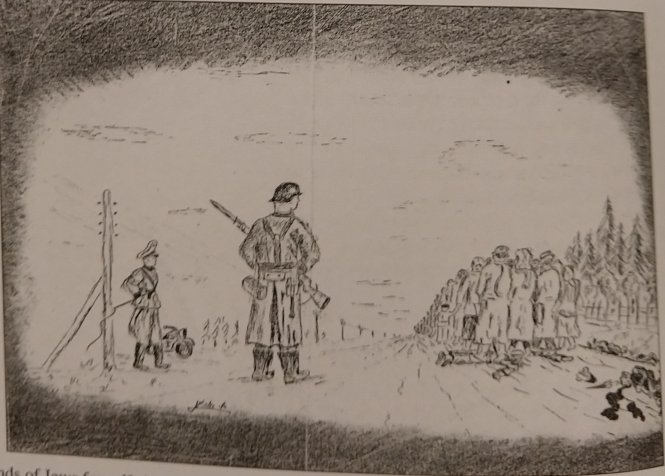
Thousands of Jews from Kolomyya and the environs, men, women and children, were
led to the Shoporovtza Forest near the town and shot next to the pits where they
were buried, the dying crying, "Shema Yisrael!" Those who collapsed from
exhaustion on the march to the slaughter place were shot on the spot. This is
how thousands of the Jews of the town and the environs were slaughtered. This
continued until March 2, 1943.
Drawing by Ariah Suchman
p. 145
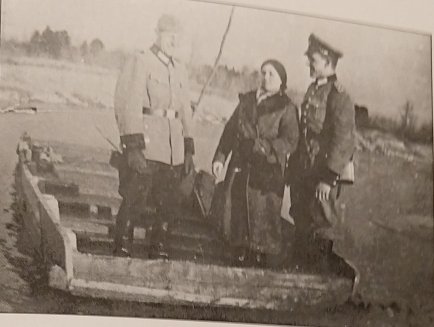
The woman
in the picture managed to flee from the ghetto to the village of Verbisch near
Kolomyya, and there she managed to survive for a time despite very harsh
conditions, until the Ukrainians handed her over to the Nazi police. In the
photo she is being taken by boat on the Prut River to the Kolomyya Ghetto to be
executed.
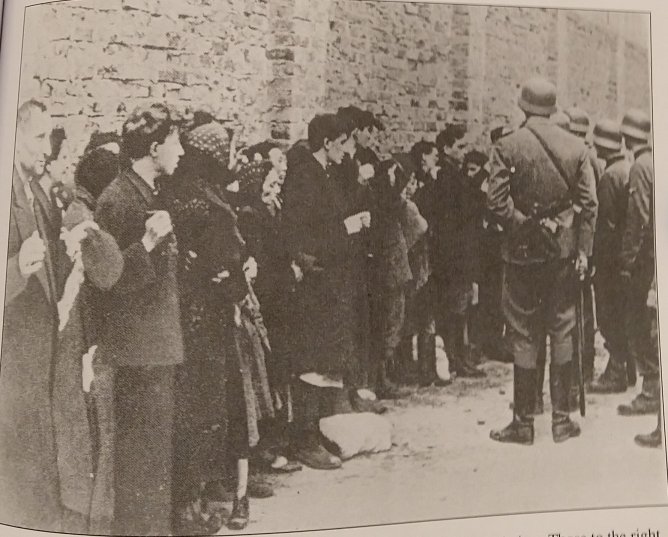
A
selection in the courtyard of the prison. The Nazis selected the Jewish victims.
Those to the right went to slave labor and life, those to the left went to the
death train or to Shoporovtza Forest and their death.
p. 146

An aktion in the ghetto.
With shouts and blows, the evicted the Jews from their homes. They were then
concentrated at the assembly point and from there sent by train to the Belzec
Camp. In other cases, thousands were marched to the Shoporovtze Forest where
they were executed by shooting.
(From the Polish Archives for
Holocaust Research)
p. 147
An aktion in the ghetto.

(By courtesy of the Polish Archives for Holocaust Research).
The aktions continued until not a single Jew was left, and then the town was declared ‘Judenrein’ (Jew free).
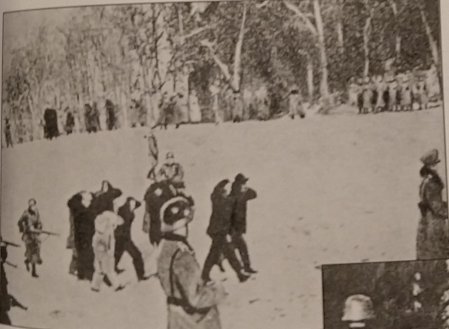
A group of Jews being led by Nazis to the death pits minutes before their
execution.
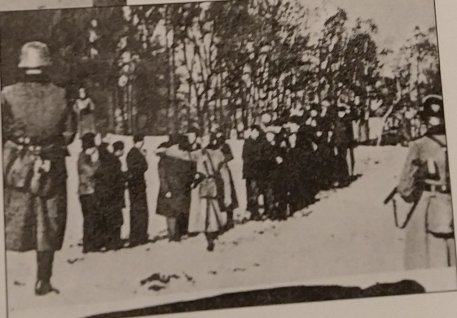
A group of Jews being led by Nazis to the death pits during the final
liquidation of the ghetto.
p. 148
TODO: page 148 has not yet been typed/etc.
p. 149
TODO: page 149 has not yet been typed/etc.
p. 150
TODO: page 150 has not yet been typed/etc.
p. 151
TODO: page 151 has not yet been typed/etc.
p. 152
Professor Menek Goldstein, z'l

Professor Menek Goldstein, z'l, a survivor of Kolomyya Ghetto.
We, the survivors of the Kolomyya Ghetto wish to commemoriate the memory of Prof. Menek Goldstein from Kolomyya, who, as a young boy endured the Holocaust and who lost his dear parents and members of his family. As a youth he suffered the inferno of the ghetto and was witness to the annihilation of the last of the Jews of the city as they were being rounded up and sent to their deaths. He was shot and wounded by the vicious Nazis, but because he lay unconscious on the ground, the Nazi murderers left him for dead.
Menek lay in the snow losing blood. Eventually, when he awoke, he realized the snow had saved his life. He recalled that his mother had said that Mrs Vinarovski, one of the righteous of the nations, would save him. And so it was.
However, as fate would have it, in November 1997 he died and untimely death and was taken from us. Menek was a world-renowned professor famous for his brain research. His work contributed greatly to the science of medicine and the progress of medicine for humankind.
We, the survivors of the Kolomyya ghetto, will always remember you, Menek, and we want to thank you and your family for the wonderful help that you gave us so that we may complete this historical project of which you were so much a part of. Menek, you were a great and special man and your death is a tremendous loss to mankind.
May you rest in peace.
Our sympathy is with the family.
The name of the survivors of the Kolomyya Ghetto.
p. 153
The Testimony of Professor Menek Goldstein
The last
day in the Ghetto of Kolomyya.
Professor Menek
Goldstein
The date was February 2, 1943. The population in the ghetto had been reduced from 25,000 to approximately 1000 people. The Jews had been murdered by the German Gestapo and the Ukrainian police during 1941-42 in a series of aktions in which thousands of people - men, women and children, had been rounded up and killed in the forest near Kolomyya, Szeperowce (Shoporovtza) or in the Ghetto slaughterhouse. Some had been transported to the camp Belzec near Lwow and killed there immediately. Some escaped the killings, only to die in the Ghetto of typhus or starvation. The Gestapo kept a register how many Jews were killed by bullets and how many died of starvation and the typhus epidemic.
The Jews remaining in the Ghetto were ordered on January 30, 1943 to move by February 1 into a block of houses on Walowa Street. We had to pack our belongings overnight. Twenty to thirty people, two to five families, were packed into one room. The situation was desperate since we knew that the ghetto was to be declared Judenrein and everyone would be killed in the next few days. Our intolerable living conditions were not of great importance since it was obvious that our deaths were imminent.
Some people discussed the possibility of escape, while others, in resignation turned to prayer.
My surviving family consisted of myself, my mother, Cilia, grandfather Samuel (called Reb Schmil) and my grandmother, Perl. We moved into a room on Walowa. My father Jacob and uncle, Arek had been deported to Belzec in October and we hadn't heard from them since. We shared the small room with 2 or 3 other families, and approximately 20 people were cramped together in this room.A cousin of ours, a young girl called Mati Trutner, whose mother Pepi, died in the Ghetto of starvation was also sharing this room with us. At night we did not go to sleep. Everybody was dressed and sat around the table or on the floor and listening to hear whether the aktion had started.
Though the people were desperate, a ray of hope was voiced by a man whose name, I think, was Krauthammer, (a grain merchant). He brought news that the German army had been defeated at Stalingrad, and for a moment everybody cheered. Even a bottle of Vodka was opened, and Mr. Krauthammer prayed that the war would be soon over. He turned to my grandfather and said to him, "The war will be over and you, Reb Schmil, will be elected as Rosh Hakahal (chairman of the Jewish community)." I remember that my grandfather told him that after the war they will not need traditional Jews like him to be leaders of the community.
Around midnight we could hear the horrible voices of the Germans, "Alle Juden Rauas", (All Jews out!). Their yelling was mixed with the horrible barking of the Gestapo dogs, and shots fired from various sides. Within minutes we had to assemble in the snow covered street. The Gestapo and the p. 154 Ukrainian police separated the women and children from the men. My mother, grandmothe and cousin Mati were separated from my grandfather and me.
I remember that a man named Presser or Pressman, who was in charge of the Jewish workers, and as such had connections with the Gestapo came forward. Presser delivered Jews everyday to the Gestapo for hard labor. He approached the Gestapo officer Frost, (Head of the Jewish division of the Gestapo) and reported that all Jews of the Ghetto were assembled. Frost screamed "You, Presser, stay in the line with the rest of the Jews". I realized then that if Presser had to join the Jews, that no Jews would be left alive in the Ghetto. At this point I turned in anger to my grandfather, saying to him that there is no more hope for us, and we should have escaped from the Ghetto a day before to the Polish family Wojnerowski which might have been willing to hide us. My grandfather comforted me in a quite voice with the following message: "When a sword hangs over your neck, God can still save you". I took my grandfather's remarks as a signal to run away from the assembled group. I heard the Gestapo screaming, "Halt, stehen bleiben" (Halt, don't move!) and shots were fired in my direction.
I ran along the Walowa Street until I reached a house occupied by the families of two tailors, Urwich and Weisser. Both men were dressed and waiting for the Gestapo while their families hid in a shelter. Both were accomplished tailors and had made suits for the Gestapo, and therefore they thought that they would not be killed. I knew Mr. Urwich and I asked him to hide me in the shelter. He screamed, "It is too late to hide. You'd better run since the Gestapo will be here any minute". I ran from the house to the courtyard, which bordered on the houses assigned by the Gestapo to Jewish craftsmen. In these houses Jewish craftsmen performed all types of work for the Gestapo and other Germans. As I reached the fence between the Ghetto and the houses of Jewish craftsmen, which was called Umschlags Stelle, I encountered gunfire, and was struck by two bullets. One bullet passed through my left arm and the other my right leg. I lost consciousness temporarily and then remained lying in the snow-covered courtyard pretending to be dead. As the gunfire stopped I looked around me and I saw near me two blood covered bodies of a man and a child. Both of them had been shot to death.
I ran back to the house of Urwich and Weisser, which was now on fire. I saw in the kitchen stove of the house a child burning. I didn't know whether the parents were hiding the child in the stove or whether the Gestapo put the child in their to burn. I managed to reach the attic, and by breaking a window I jumped from their to another house. This house was part of the Umschlags Stelle and it was guarded by police. I was in the house where a sheet metal facility was located and I found a hiding place in a large closet.
After two days and nights without solid or liquid food I was feeling weak, and I was thinking about how to escape and get outside the ghetto. As the shooting in the Ghetto ahd subsided I decided to make my getaway. I climbed the stairs to the attic of the house. From the attic I was able to see the Ghetto and also the surrounding areas. I saw that the houses in the Ghetto were burning, and civilians (Ukrainians and Poles) were looting personal belongings from the burning houses. During the day, a few Jews climbed out of the burning underground shelters and were immediately denounced by civilians to the Ukrainian p. 155 and German police who shot them on the spot.
I realized that without food I could not survive very much longer. The snow from the roof of the attic was my only nourishment and not sufficient to sustain me. I planned to escape to the Polish family, Wojnerowski. They had promised my mother to hide me. From the holes of the attic walls I could see that the Ghetto was still burning and that no Jews had returned to the Ghetto. The German police were guarding the Umschlags Stelle, and the one adjacent courtyard was also guarded by a German soldier. This large courtyard belonged at the time to the German army. I studied the movements of the soldier on guard for hours. When the soldier was patrolling at the furthest point I jumped from the attic three floors into the snow covered courtyard and I moved on my stomach into the direction of a high fence, which ran along one of the city streets near a movie house, Cinema Mars. To reach the street outside the ghetto, I jumped the wired fence, and I moved fast along the dark streets of the city to reach the house of Maria and Florek Wojnerowski. In a barn of their house, I found shelter for the next few months and as for the story of my hiding, I might describe it in a separate chapter.
Later, after the war, I wondered what had inspired my grandfather to quote the saying to me. A friend told me recently about a passage in the Talmud Berachot (Chapter One, which in the English translation states "Even though a sword rests upon a man's neck, he should not desist from prayer"). Although I remember that my grandfather studied the Talmud during the last days of the Ghetto I am not sure whether he cited this or another Talmudic passage. However, I am convinced that my grandfather's massage was instrumental in my sudden decision to escape.
New York, Nov. 4, 93
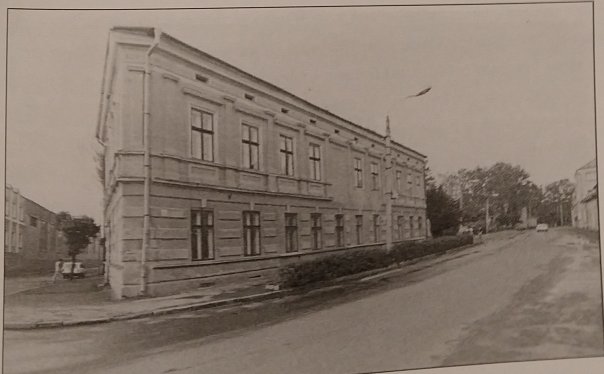
In the cellar of this house on Legionov Street and the corner of
Volowa Street, on the edge of the ghetto, Maria Rosenbloom and her relative,
Menek Goldstein, hid during one of the aktions.
p. 156
p. 157
p. 158
Memorial service tribute to Menek Goldstein
June 26, 1998
by
Alex Gitterman
TODO: type up the text of Alex Gitterman's memorial service tribute to Menek Goldstein (pages 156 through 158)
p. 159
p. 160
p. 161
p. 162
TODO: type up the program of Menek Goldstein's memorial service (pages 159 through 162)
p. 163
The Testimony of Mr & Mrs Solomon Gutman,
Kolomyya Ghetto Holocaust survivors
The following is a full copy of the testimony of Mr and Mrs Solomon Gutman, Kolomyya Ghetto Holocaust survivors, who gave testimony at Yad Vashem in the 1960's concerning their Holocaust experiences, specifically concerning the ghetto from the time the Germans arrived, until they left.
Solomon Gutman — son of Ephraim and Yetti (Witz), born 23/10/1903 in
Kurniov
Miriam Gutman — daughter of Shlomo Nemet and Regina (Stein), born
13/5/1909 in Kolomyya
The Gutmans live at 20 Arlosoroff St., Bat Yam, Israel.
Family members who perished during the Holocaust:
| Mother | - Gutman Yetti, 62, in an aktion on 7/9/1942 in Kolomyya |
| Brother | - Israel, 28 September, 1941, in Shoporovtza |
| Father | - Shlomo Nemet, 62, in Shoporovtza |
| Mother | - Regina, 60, in Belzec |
| Brother | - Yaakov Nemet, 37, dentist, in Homin |
| Brother | - Phillip, 35, physician, in Vinitzia |
| Children | - Etta Gutman, 5, in Kolomyya and Mata Gutman, 2, on 10/1/1942 |
Before the war, we managed a store and workshop in Kolomyya for jewelry and optics. This trade helped us during the occupation to acquire work permits from the Umschlags Stelle, the collection point for forced labor (see the attached photograph). On the other hand, it enabled the Germans, as always, to exploit our professional skills without payment. Despite this, our chances of surviving this terrible period were virtually non-existent.
The only temporary privilege we had was permission to transport 2 kilograms of food to the ghetto (see the attached photograph). Using this permit, we were able to contribute at least something to overcome the hunger of those who came to our house every day. From these supplies we would prepare a large pot of soup which we would disk out over a long period of time.
Every day of our lives in the ghetto was filled with tragic experiences of which we will recount several details.
Sorting the Jews' Silver, Gold and Jewels (S. Gutman)
In August, 1941, the German authorities ordered all Jews to hand over their gold, silver, jewelry, and all metal foreign currency. This was one of the ways to prevent the Jews from trading and profiting from p. 164 the Germans 'fighting' for the good of humanity.
Even if on occasion someone hid a zloty the long lines before the regional government offices proved that the Jews were following the order. Shortly after, I happened to witness the fruits of this illegal robbery. On 7/8/1941, I was called to the regional government offices together with the jeweler Y. Baruch Feurstein (who was later killed in one of the aktions). We were brought to a closely guarded place where there were piles of silver, gold jewelry and coins — the tremendous booty that had been taken from the Jews.
We were ordered to sort and organize these goods into that which was new and valuable, and that which was worthless.
Anlernstelle (The Training Center)
Others also were supposed to benefit from our professional skills and knowledge. The German authorities, aware of the impending destruction of the Jews, established a center in 1942 in which Jewish tradesmen were to teach Ukrainian and Polish youths their trades.
The center belonged to the regional government, a sub-division of the local Kolomyya government. More than 10 tradesmen trained their 'apprentices' in their respective trades at the center.
Escaping the Belzec Transport twice (M.Gutman)
It was on a Saturday evening, the autumn sun was setting, and the air was full of impending disaster, which we felt instinctively.
My husband told me to dress the children, and we went to the collection point for the transport. We sat there for several hours and then again returned home. But the anxiety within remained, and was increased by the visits of the Germans late in the evening who came to pick up their polishing jobs. When they had left, my husband assembled everyone (the family having increased by another youth whose parents had been taken in a previous aktion). He divided up all our remaining goods which were worth about 12,000 zloty, so that each would have the independent means to deal with his own particular need or emergency. I said that I would not be parted from the children. In the morning, we decided to go to the collection point again. But at 5:00 AM on 10/10/1942, shots and shouts were heard, and suddenly there were Germans in the house, shouting: "Jews, outside!" We walked to the square. During the selection, my husband and I were sent to the 'good side. But I followed my children to the 'bad' side.
I will not describe here the terrible scenes that occurred in the square. There are no words to describe the crowding, the lack of air, the stench of the sweating bodies and the filthy rags, the lice. I saw my children die before my eyes.
We rode toward the infamous last stop - the death camp of Belzec.
Before Slanislavov, some youths succeeded in opening the door. They wanted to escape, but the SS broke in and began massacring. Brains were splattered on the walls of the car, and I like a mother hen, p. 165 I covered my children with my body.
he door was then closed and we moved on. In the meantime, one of the youths managed to open the barred window. Without a thought, I leaped from the window. I simply pushed everyone aside and jumped out, driven by some kind of madness. I knew from stories that many ended their lives before reaching the gas chambers, and this was my goal. I had reached the end of my strength to struggle pointlessly. But I found myself on the ground, on my feet. I stretched my arms out after the train in which my children remained. No one even shot at me. I was alive. I looked around me and saw a well. I walked over as in a dream, hearing imaginary noises, drew a handful of water and drank, soothing my burning, parched lips.
Finally, I set off. I found a hut in Bolshevitz but a frightened farmer ordered me to leave. I reached the train station. I was without the yellow star and dressed normally, with nothing to draw attention to me, but one Ukrainian came running up to me, shouting "Jewess!" I reprimanded him: "Do you know what it means to say that about someone today?" But he wasn't sacred, he simply ran to the station and I disappeared from view. I went into some house in which I met many people from Kolomyya, including my cousins Minia and Carol Stein. There I learned of the possibility of arranging Aryan papers for myself and for my husband, to whom I sent a telegraph telling him that I was living in this place, and this idea strengthened me and gave me a little bit of hope. They bought me a ticket to Kolomyya, and in the evening I boarded the train with a young man, Hecht, a survivor like myself.
But in Stanislabov, we had to wait till morning for a connection. Waiting in the station involved danger. And in fact, in the morning a Ukrainian came and took me to the Germans. They searched me, took my 4000 zloty, and left me with my gloves, a comb, and little else. I could have kept up a better face, but the ghetto certificate found on my companian gave us away. I admitted that I was a Jewess and that I had lost my children. I had no desire to live, pleading with them to just shoot me. I saw the tears welling up on the cheeks of the German—the first compassionate German I had ever seen.
They took us to a jail, together with 16 other regufees from Kolomyya, who were caught in the same way. They told us to turn our faces to the wall and called us into the office one at a time, and then began questioning us about our education, skill, languages, etc. Then the jail physician took my last zloty from my wallet, and a drunken German sprayed water on us from a siphon. Finally, they took us out to the courtyard to be shot. Had it not been for an order not to shoot, I would have finally ended my torture, but it turned out not to be so easy. I would have to drink the glass of poison till it was empty.
In the meantime, a large aktion had taken place in Stanislobov, and 8000 Jews were forcefully assembled at the Rudolph Station, where we were also taken. The scene was indescribable. The ground was covered with corpses, but none of this made any impression on me. Again I pleaseded with the Germans to kill me, but all I received was a kick, and fell underneath a wall.
People were falling like flies. They had been there from Sunday till Wednesday with no food. They had become beasts awaiting slaughter.
The next day I was taken to the hospital for contagious diseases. There I met the same German who had p. 166 cried the day before. I asked him if they were loading the people on railroad cars to take them to Belzec. He nodded his head that they were. But now I wanted to live. I wanted to see my husband. That is apparently the nature of the human being.
And it started all over again: going up into the cars, the journey. Again this time the youth opened the doors of the car, and I jumped out in Bokchowitz, but not so successfully. The blood poured from my face. But I struggled on until I fuond some hut, and I saw some apples which I begged for. The peasant lady gave me several. And then I walked on through a field. Here I had a terrible experience. I met an old Jew and a his wife who were walking on a path there. They turned around and shouted at me not to follow them. This depressed me greatly—after all, I was as wretched as them!
I reached a wood and began to look for food. My body began to demand its rights, but none of the leaves seemed edible other than the Alnus. Then I lay down and slept curled up, and in the evening set off again. I found some potatoes but I couldn't eat them. It was so cold that I decided to lie down on a pile of potatoes and cover myself with leaves. The farmer discovered me and began to threaten to call the police but then his heart softened and he took me to his house. I felt a bit of the warmth of a home. I was given bread, milk and a heavenly sheet on the floor, on a pile of hay. I had to leave in the morning but there were still good people in the world.
This encouraged me. I gave them my clothes and asked for a beggar's rags and a basket of potatoes. And so as a beggar, I set off for Bokchowitz. I went to the address, which had been given to me. There I found two neighbors of my parents, lying wounded in bed. In the Judenrat, I met the lawyer Lorber and other Jews from Kolomyya. I told them about the telegram to my husband and about the piece of coral I kept hidden under my tongue as an amulet that the Germans wouldn't find when searching me. Regarding its worth, it turned out that piece was not the valuable treasure I thought. I couldn't even sell it — I borrowed 15 zloty against it for a ticket to Kolomyya, which I later paid back. This time when I bought the train ticket, the stationmaster 'took care' of me. He brought me into his office, began by threatening me, and ended by giving me the good advice to pretend to be a Pole returning from Kazakhastan, due to my excellent Polish. When he offered me bread and butter I burst out in tears.
Finally at night I found myself on the train, where I also encountered danger because of some Ukrainian women. At the station in Kolomyya there were many agents, but I was in my beggar's clothes, and they didn't stare at me. My walk to town was uneventful, and I reached the collection point where our milkman was waiting for me. He had been sent by my husband. Only after examining me closely did he recognize me and take me home.
The result of these experiences was meningitis. I received first-aid that night from Dr. Wallenstein, who later left the ghetto permanently, leaving his mother with us.
Afterward, when the Germans burned the ghetto, my husband asked Dr. Gross to come and give me a p. 167 shot, so that at least I wouldn't be burned alive, but he couldn't get to me, but neither did this fire consume me.
I slowly returned to health. My husband taught me to walk, and in this condition, I had to escape from the ghetto for the final bell had rung. In my beggar's clothing I went with my husband and Dr. Wallenstein's mother to Piadiki, where we stayed in hiding for 17 months at the home of Mr Pididovridani, which was a different sort of hell.
No modern film could depict the horrifying experiences we went through. No sane person can imagine them when they are described in such telegraphic terms, frozen, like incredible nightmares, but nevertheless, recalling each one of them instantly arouses great sadness.
Alive in a Mass Grave in Shoporovtza with the murderer, Kenkendeffel (S. Gutman)
When I left the ghetto on December 12, 1941 to go to a pharmacy to buy medicine for my sick wife, I was stopped by two policemen, a German and a Ukrainian. Their greeting was a blow from a pistol to my head: "Dirty Jew, don't you know how you're supposed to walk?" My crime had been that instead of walking in the gutter I had walked in the middle of the street. Because of the mud and my torn shoes I was taken to a Ukrainian police station. While searching me they found my wedding ring, which I thought I had lost. It now fell out of the torn lining of my coat. I was beaten with a club till I bled and taken to the Gestapo. There, after being whipped, I was taken to a cell. Toward evening, I was taken with a group of 300 Jews to Shoporovtza. The pit had been prepared. We were beaten, forced to undress and run in groups of ten into the pit, when the shouting and shooting began. I was in the next-to-last group. When my turn came, I ran into the pit. I noticed that it had been dug at an angle. That detail I remember.
Inside the pit stood Kenkendeffel, wearing rubber boots. Two of his helpers forced us with prods to lie down. When I saw this infamous Gestapo man, I shouted - or wanted to shout - "Murderer!" But I was petrified, and couldn't move my tongue. Kenkendeffel shot each person in the head.
…When I awoke, it seemed as though I were sleeping comfortably in my bed. But I quickly regained consciousness and realized where I was, and most importantly that I was - alive! There were two bodies lying across each other on top of me. We were covered with lime.
I crawled out of the pit, completely naked, into a cold starry night. I began running toward the town but then I realized I was naked and returned. I decided to enter the town in a back way and to get into the old ghetto, which was already Judenrein. I crossed the frozen river, the Prut, and then walked along it. The ice broke under my feet, and I struggled against death fighting the forces of nature. Broken and wounded, I reached my destination.
The houses were empty and silent. I found clothing and shelter. In the morning, Hallerbach's group, who were responsible for collecting Jewish property left in the houses of those Jews who were killed or p. 168 shipped off to the concentration camp, arrived to collect the scraps of Jewish belongings, which were to be sent to German factories for reuse. I returned with the workers to the ghetto.
How did I remain alive? I learned only later from a man whom was struck dumb when he saw me. He told me about himself and about what had happened to me.
By the time our group was forced into the pit, it was already dark when they started shooting my group of ten. However, the shot missed me and the others ran away. The Germans chased after them and caught some. That is how I found two bodies on my back. The man with whom I was speaking had been convinced that I was no longer alive, since he had been in the last group and had seen me run into the pit. As luck would have it, he had succeeded in hiding in the dark and escaping.
Pneumonia in both of my lungs was the outcome of the tragic experience.
Now it was time to leave the ghetto, for its end was approaching. On December 22, we got our 'new housing', in a room in the village of Piadiki in the house of Mr Pididovridani, one of the villagers, for 17 months. In 1944 we went to Chernowitz, and from there we returned for a short while to Kolomyya, in order to move from there to Poland, and afterwards to settle in Israel.
We have delivered this testimony in full awareness and of sound mind.
(signed)
Solomon Gutman
Miriam Gutman
Testimony received and translated by Olga Branich, March 27, 1961
Some comments on the Testimony of Solomon and Miriam Gutman
This partial testimony completes the material collected regarding Kolomyya. It is of great value due to the events described in it, especially due to the fact that the witness Solomon Gutman took part personally, being forced to do so together with another Jewish jeweler, in the sorting of gold, silver and jewelry stolen from Jews.
Those taken for this work were skilled Jewish tradesmen, who were carefully searched at the end of the job. The witness cannot evaluate the value of the stolen Jewish property, but this was done by Katzman in his report of June 30, 1943, in general figures for the entire district of Galicia.
A second problem raised is that of forcing Jews to teach Poles their various skills.
It should be noted here, as Shauder, a Jew who worked with Solomon Gutman, reports in his testimony, that this work was done before the war in Kolomyya by Jews, a matter which created a special situation in Kolomyya after the German invasion (see Shauder's testimony). Gutman's testimony confirms that as a skilled tradesman, together with other Jewish workmen, he was forced to teach his trade. The veracity of these facts is confirmed by the photograph of a relevant certificate.
p. 169
The testimony of Miriam Kaufman presents experiences of value for psychological studies of the Holocaust. During her transport by train to Belzec, she abandoned her children by leaping off the train, with the intention of killing herself. Surprisingly, she remained alive. She tried her luck again, going to find her husband, whom she knew to be alive in Kolomyya, having escaped the aktion. This is a case of a psychological dilemma, which has also arose during the Eichman trial.
Finally, the testimony given here can be used to implicate Kenkendeffel, imprisoned in Germany, due to the careful search of a son of Kolomyya, Mr Windwer.
This testimony confirms the participation in the crime of mass murder, which was unknown to the people in Israel who were from Kolomyya who had testified against Kenkendeffel, in regard to his specific crimes. Here we have a witness to the mass murder of 300 Jews in the Shoporovtza Forest.
There are instances in Poland of individuals escaping mass murder. From this case we learn that it could happen under certain Gestapo functionaries in Kolomyya, and from the testimony of the dentist Kaufman from Horodanke (witnesses, who despite their identical family names were not related, or even had knowledge of each other, as far as I was able to discover), who escaped a similar mass grave execution. There the governor of the district of Horodanke submitted a complaint about the fact that the Gestapo aimed poorly.
Olga Bernich
April, 1961
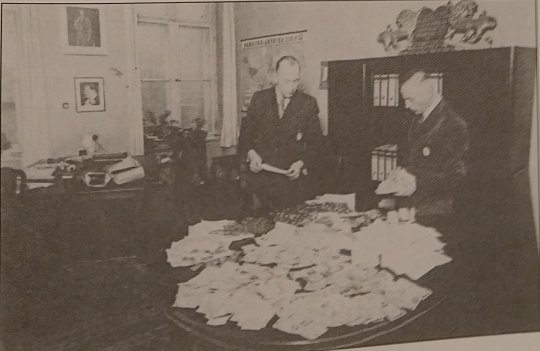
In a room similar to this, Mr. Solomon worked at sorting cash and jewelry
that was stolen from Jews in the ghettos.
p. 170
The Testimony of Yeshayahu Likvornik
a Holocaust
survivor of the Kolomyya Ghettos.

Yeshayahu Likvornik
My name is Yeshayahu Likvornik - a Holocaust survivor from Kolomyya. It seems to me that there are two things in the world that are influential to a man: luck and fate.
When the Nazis entered Kolomyya in September 1941, I was a boy of twelve years old. We were a complete family - father, mother, eldest brother, Meir, my big sister, Tami and I, Yeshayahu. We lived on 7 Bazera Street. My father had a metal business and a successful clientele of both Jews and Christians. He was highly respected as he was an honest and kind man.
One day I had the opportunity of becoming acquainted with one of the clients by the name of Vasilien Petrovski, a rich, intelligent and upright Ukrainian. He built his house on Krashavski Street and had bought his supplies from our store. Petrovski liked our family and especially my father who was very kind to him. At the time, I would never have dreamed that it would be Petrovski who would endanger his life and that of his family in order to save us and another 14 Jews from the hands of the Nazis.
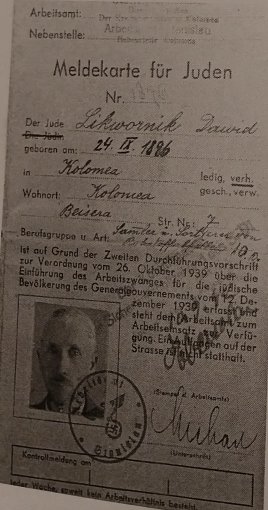
A slave-labor permit in the name of David Likvornik. Thanks to this
document he was saved from the roundups and deportations from Kolomyya. Together
with his son, 12-year-old Yeshayahu, he was given shelter in the home of the
Righteous Gentile Vasilian Petrovski, and they stayed there together with 14
other souls until the Soviet Army liberated the town on 28.3.44.
Now to return to the two things I mentioned in the beginning - luck and fate. Can I say that my father and I were lucky since Petrovski saved us because of the especially good relationship we had; or as fate would have it, that my father and I would survive while my brother, sister and mother died in Belzec, a death camp? It is beyond my comprehension. Maybe I stayed alive by virtue of my father, or maybe my father stayed alive because of me - who can tell?
This is how it all came about. My father was among those who went to work under the orders of the Germans and I accompanied him. One day, Vasilien Petrovski arrived at my father's workplace, p. 171 which was outside of the ghetto and taking great care, he spoke to my father. He told him that if we felt that we were in imminent danger of being killed that we should come to him and he will take care of us. And thus, the very next day, at my father's workplace, I began to beg my father "Daddy, lets run away from this place". My father was surprised by this but I continued to plead and beg him. Finally, we went to one of the empty houses in the vicinity. Immediately after that, the Nazis came and rounded up all the workers. I have no explanation as to why I begged and cried or why I had the feeling that the end was near, but it seems that it was a sign from heaven. The good Petrovski was indeed heaven-sent and he saved my father and myself and others. He gave us refuge until the Red Army liberated Kolomyya. I will never understand why we were lucky while the other members of my family were 'sentenced' to death. Who am I to question the ways of God?
Let me finish by saying that Vasilien Petrovski and his sister, Anyah, who assisted him in saving us, abided by the commandment, "And thou shalt love thy neighbors as thyself". May their precious souls rest in peace.
Yeshayahu Likvornik
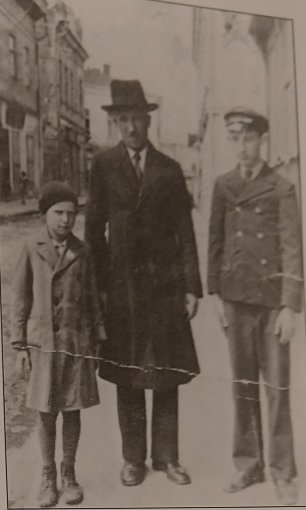
David Likvornik and his two sons. On the right, the eldest, Meir, and
on the left Yeshayahu. The photo was taken before the war.
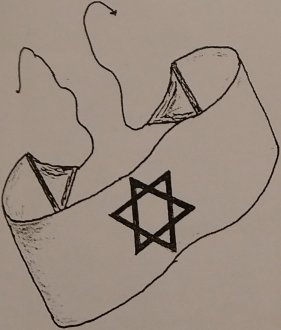
A sketch of the Magen David armband that Jews had to wear in the
Kolomyya Ghetto.
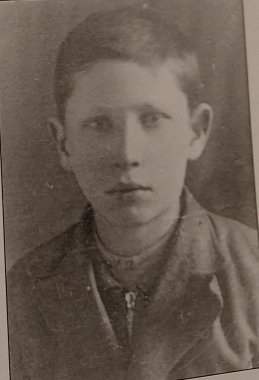
Yeshayahu Likvornik, photo from the ghetto period - aged 12.
p. 172

In memory of Golda, daughter of Moshe and Hannah Likvornik from Kolomyya,
the righteous mother of the Holocaust survivor, Yeshayahu Likvornik from
Kolomyya, who perished in one of the cruel aktions together with her
daughter, Tami, and her eldest son, Meir, who were taken on death trains to the
Belzec extermination camp. May their memory be blessed.
p. 173
The Likvornik Family -
Those who
fell in the Holocaust and those who survived

Ariah Lev Likvornik, his father, David,
z"l, his
grandgather, Yeshayahu who died in the
Holocaust in the first aktion in 1941.
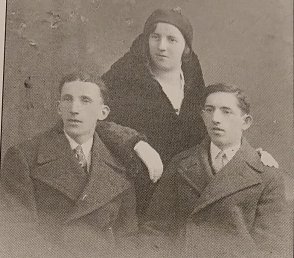
On the right is Yitzhak Likvornik who survived on the Holocaust, in the
middle is Rosa Likvornik who died with her husband and their daughter, Ita, in
the Holocaust in Belzec, September, 1941. On the left is Herzk Likvornik who
died in the first aktion in 1941.
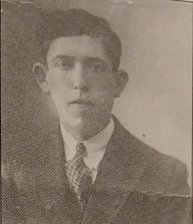
Yosi Likvornik, David's younger brother, the uncle of Yeshayahu, who
fell in the Holocaust in 1941.
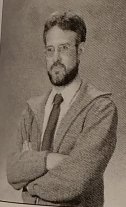
Yaakov (Jack) Likvornik, who lives in the USA.
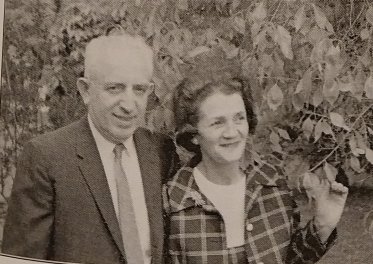
Yitzhak Likvornik, David's brother, and his wife, Tami, who survived
the Holocaust. They went to the United States where their son, Yaakov (Jack)
was born.
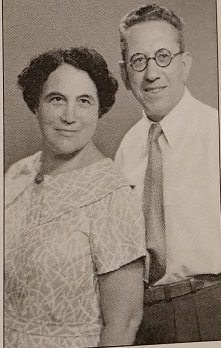
Shimon Likvornik, David's brother, and his wife, Naomi, both of whom
survived the Holocaust.
p. 174
The late Vasilien Petrovski and his sister Anyah Dimitrovna, Righteous Gentiles, who saved 16 Jewish men, women and children in a secret bunker in his home during the Nazi occupation.
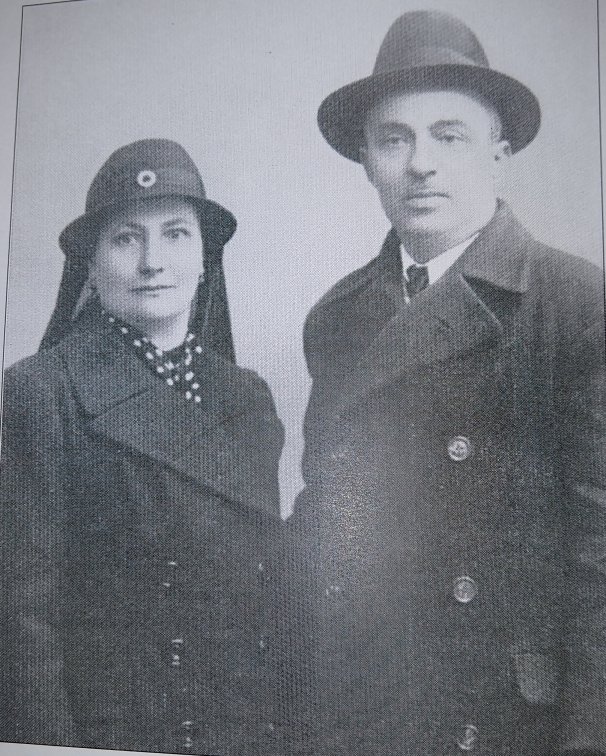
The title of Righteous Gentile was bestowed on them, sadly only
posthumously, in Jerusalem as Yad Va‘Shem on November
12, 1997.
p. 175
Righteous Gentiles
Vasilien Petrovski and his sister, Anya
On 12 December, 1997, a ceremony was held in Jerusalem at Yad Vashem in the Garden for the Righteous Gentiles. The ceremony was attended by public figures, high school students and survivors from Kolomyya living in Israel and the Diaspora. The title of "Righteous Gentiles" was awarded postumously to Vasilien Petrovski. Professor Dov Noy of the Hebrew University, himself from Kolomyya, paid tribute to Vasilien Petrovski's brave act of saving Jews and his heroism in the face of the terrible danger he faced.
Mrs Bahira Zakai, a member of Kibbutz, Moshavei Sadeh, who had been given refuge by Petrovski in the hideout, spoke of the difficult conditions and suffering she experienced and about the other people who were saved over a period of 14 months. She described the suffering and hunger and the food Petrovski and his sister, Anya, managed to scrape together to keep them alive. The food that he bought was camouflaged as cattle food so that his neighbors would not detect that he was hiding Jews. In their hiding-place, Mrs Zakai sat with her little sister, and both little girls sat waiting until the morning in order to receive their share of food - a small slice of bread, a little porridge made from corn flour or potatoes cooked in their skins, and water from the bucket used by the cattle. That was all that they ate for 24 hours. As for changing their clothes and washing, there is nothing to say because the danger of being discovered hovered over their heads at all times. At any moment, there could have been a surprise search of Petrovski's property by the Gestapo. In addition, they lived in constant fear of being informed on by the neighbors. Yeshayahu Likvornik, one of the 16 survivors, spoke about this: "We just wanted to go to sleep and not wake up in the morning, and in this way just end our suffering". It was even difficult to hope that one day we would come out of this hiding place alive.
Mr Yochanan Bein, the Deputy Director of Yad Vashem, who opened the ceremony, talked of the planning and barbarism of the total destruction of the Jewish nation by the Nazis.
Dr Mordechai Paltiel, in his address, said that it is incomprensible why Petrovski endangered his own life and that of his sister’s and everyone around him, to save 16 Jews even though no one asked him to. Vasilien Petrovski, on his own initiative, told the late David Likvornik, the father of Yeshayahu: "the moment you feel that you are about to be annihilated, come to see me and I will take care of you". And so, when the Nazis besieged the ghetto and took the last surviving Jews from the ghetto in order to kill them in the Shoporovtza Forest, David and Yeshayahu Likvornik escaped to Petrovski's hiding-place and stayed there with the 14 other Jews. They hid there until the Soviets invaded Kolomyya.
It is most unfortunate that Petrovski, and his sister Anya, did not live to receive this distinguished honour bestowed upon them. May they be remembered forever and their memory be blessed with all the Righteous Gentiles.
p. 176
These are the names of the people who found safe refuge in Vasilian Petrovski's house during the Holocaust.
Genia Fogel (Zehava Carp)
Havs Fogel
Sara Shnitzer
Zvi Shnitzer
Avraham Sherzer
Yoseleh Bernhoit
Ziama Graif
Zvi Graif
David Likvornik
Yeshayahu Likvornik
Bronia Fogel
Zvi Eizencraft
Ela Eizencraft
Hela Eizencraft (Behira Zakkai)
Hana (Haklai) Eizencraft
Fishl Boichman
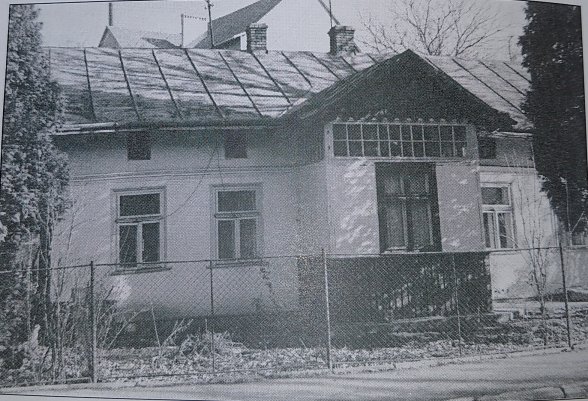
The home of Vasilian Petrovski, the righteous gentile from Kolomyya was a
short distance from the Gestapo Headquarters of Kolomyya. Behind the house were
bunkers where the Jews hid. The house is still standing.
p. 177
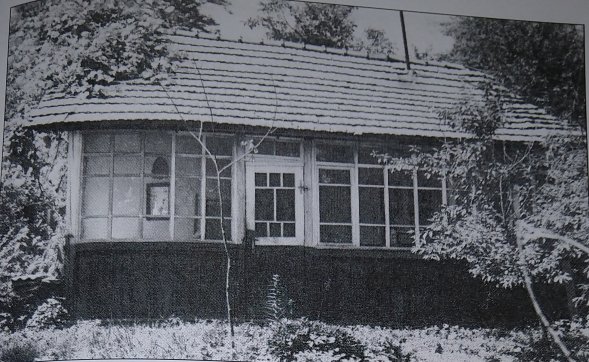
Petrovski's house where a Polish family lived unaware that Mr. Petrovski
had hidden 16 Jews under the cowshed in the yard.
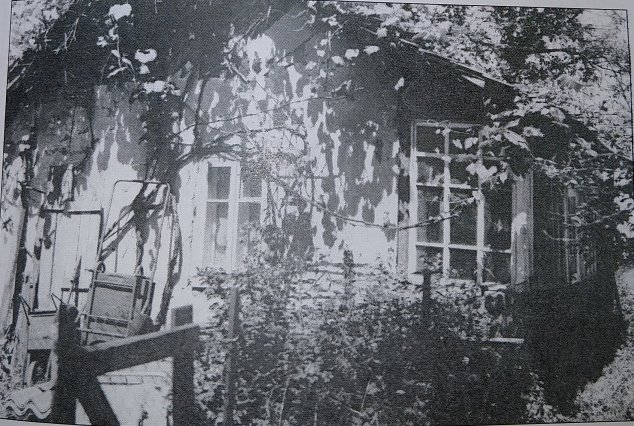
The wooden gate at the entrance to the cowshed, where 16 Jews were hidden
in a bunker deep in the ground under the cowshed.
p. 178
Dates of aktions that took place in Kolomyya
From the Holocaust Encyclopedia, Volume V, Page 1080/1
| 12.10.1941 | 3,000 Kolomyya Jews murdered in Shoporovtza outside of the city |
| 04.11.1941 | Thousands of Jews kidnapped and killed in Shoporovtza |
| 23.12.1941 | 1,200 Jews with foreign passports arrested in Kolomyya and killed in Shoporovtza |
| 24.01.1942 | 400 of Jewish intelligentsia arreested and killed in Kolomyya |
| 25.03.1942 | The ghetto of Kolomyya was established and 18,000 Jews imprisoned there |
| 3-4.04.1942 | 5,000 Kolomyya Jews sent to Belsec and 250 Jews killed in the ghetto |
| 07.09.1942 | 7,000 Kolomyya Jews sent to Belsec, another 1,000 Jews killed in the ghetto |
| 11.10.1942 | 4,000 Kolomyya Jews sent to Belsec |
| 04.11.1942 | 5,000 people killed in the ghetto, 1,600 people shot in Shoporovtza |
| 02.02.1943 | The Kolomyya ghetto destroyed, and 2,000 Jews were murdered, the last residents of the ghetto |
p. 179
TODO: page 179 has not yet been typed/etc.
p. 180
TODO: page 180 has not yet been typed/etc.
p. 181
TODO: page 181 has not yet been typed/etc.
p. 182
TODO: page 182 has not yet been typed/etc.
p. 183
TODO: page 183 has not yet been typed/etc.
p. 184
TODO: page 184 has not yet been typed/etc.
p. 185
TODO: page 185 has not yet been typed/etc.
p. 186
TODO: page 186 has not yet been typed/etc.
p. 187
TODO: page 187 has not yet been typed/etc.
p. 188
TODO: page 188 has not yet been typed/etc.
p. 189
TODO: page 189 has not yet been typed/etc.
p. 190
TODO: page 190 has not yet been typed/etc.
p. 191
TODO: page 191 has not yet been typed/etc.
p. 192
TODO: page 192 has not yet been typed/etc.
p. 193
TODO: page 193 has not yet been typed/etc.
p. 194
TODO: page 194 has not yet been typed/etc.
p. 195
TODO: page 195 has not yet been typed/etc.
p. 196
TODO: page 196 has not yet been typed/etc.
p. 197
TODO: page 197 has not yet been typed/etc.
p. 198
TODO: page 198 has not yet been typed/etc.
p. 199
TODO: page 199 has not yet been typed/etc.
p. 200
TODO: page 200 has not yet been typed/etc.
p. 201
TODO: page 201 has not yet been typed/etc.
p. 202
TODO: page 202 has not yet been typed/etc.
p. 203
TODO: page 203 has not yet been typed/etc.
p. 204
TODO: page 204 has not yet been typed/etc.
p. 205
TODO: page 205 has not yet been typed/etc.
p. 206
TODO: page 206 has not yet been typed/etc.
p. 207
TODO: page 207 has not yet been typed/etc.
p. 208
TODO: page 208 has not yet been typed/etc.
p. 209
TODO: page 209 has not yet been typed/etc.
p. 210
TODO: page 210 has not yet been typed/etc.
p. 211
TODO: page 211 has not yet been typed/etc.
p. 212
TODO: page 212 has not yet been typed/etc.
p. 213
TODO: page 213 has not yet been typed/etc.
p. 214
TODO: page 214 has not yet been typed/etc.
p. 215
TODO: page 215 has not yet been typed/etc.
p. 216
TODO: page 216 has not yet been typed/etc.
p. 217
TODO: page 217 has not yet been typed/etc.
p. 218
TODO: page 218 has not yet been typed/etc.
p. 219
TODO: page 219 has not yet been typed/etc.
p. 220
TODO: page 220 has not yet been typed/etc.
p. 221
TODO: page 221 has not yet been typed/etc.
p. 222
TODO: page 222 has not yet been typed/etc.
p. 223
TODO: page 223 has not yet been typed/etc.
p. 224
TODO: page 224 has not yet been typed/etc.
p. 225
TODO: page 225 has not yet been typed/etc.
p. 226
The following memorial prayer comes from
"Megillat Hashoah Al Yahadut Europa"
(The Holocaust Scroll of the Jews of Europe)
by Moshe Prager
YIZKOR ELOKIM - MAY GOD REMEMBER -
the Six Million Martyrs, Children of Israel, who were
put to death in all manner of cruel and inhuman ways in the years of the
atrocities 1940-1945, for the sole crime of being believers, and of
the the seed of Abraham, Isaac and Jacob.
YIZKOR ELOKIM - MAY GOD REMEMBER -
and have mercy on the surviving victims of the People of Israel who were
led in their masses to the crematoria and whose ashes and bones were strewn in
the fields of the gentiles. The echo of their last song "Ani Maamin" echoes from
one end of the world to the other.
YIZKOR ELOKIM - MAY GOD REMEMBER -
and bind up in the bond of eternal life thousands of holy communities of
Israel which were cut off from the land of the living by the Nazi destruction,
together with the crown of their ancestors and the glory of their heritage, and
with the abundance of their flowering and the seeds of their future.
How terrible the calamity of the Holocaust, and from this Holocaust, Earth do not cover the rivers and streams of our blood.
back
cover
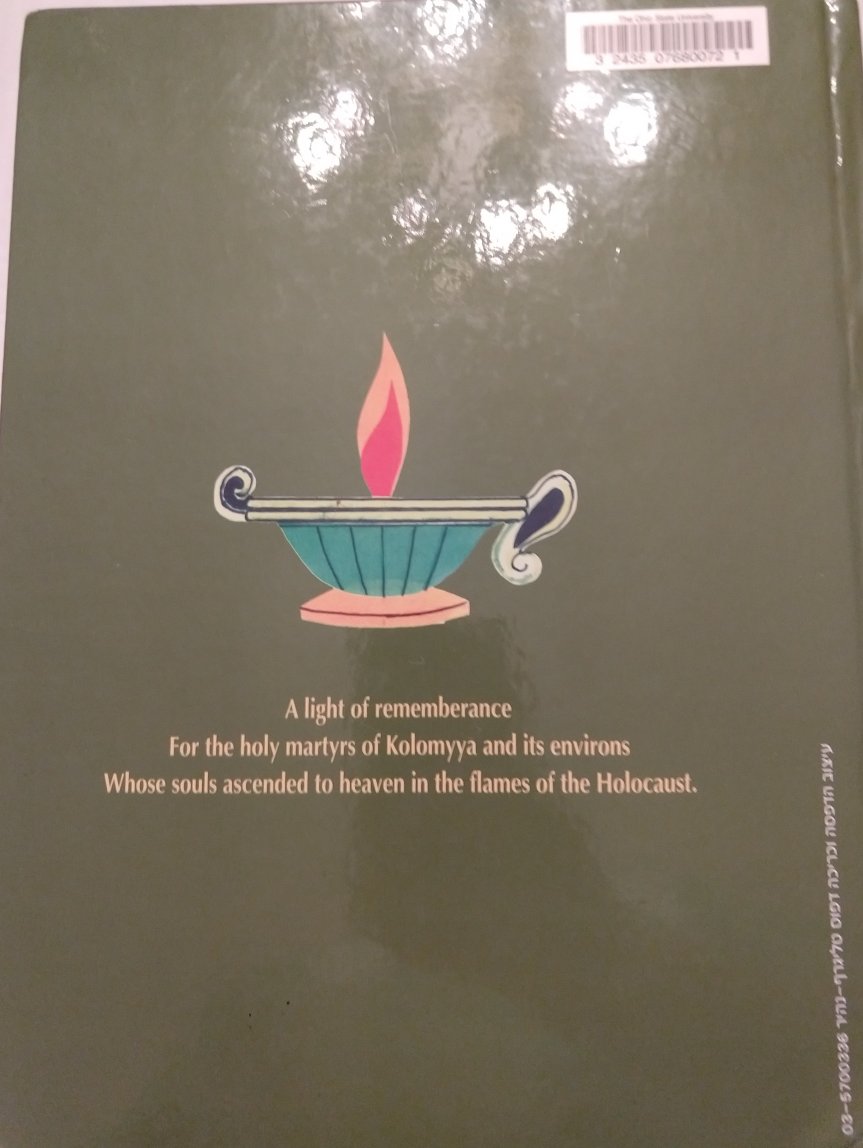
The back cover. The vertical text in Hebrew reads, "Design printing and binding [by] Taligraf-Nahir Press 03-5700336".